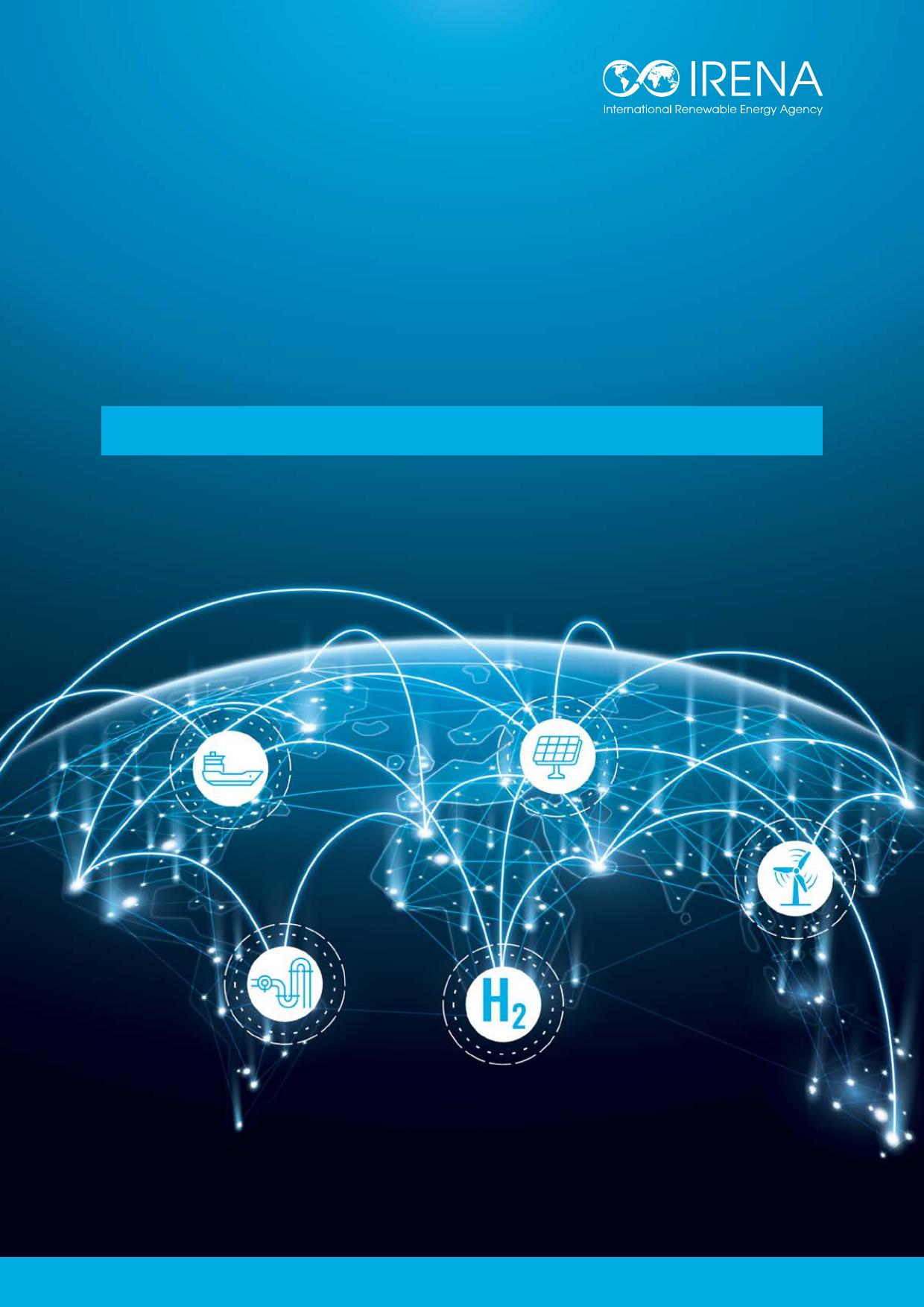GLOBALHYDROGENTRADETOMEETTHE1.5°CCLIMATEGOALPARTITRADEOUTLOOKFOR2050ANDWAYFORWARD©IRENA2022Unlessotherwisestated,materialinthispublicationmaybefreelyused,shared,copied,reproduced,printedand/orstored,providedthatappropriateacknowledgementisgivenofIRENAasthesourceandcopyrightholder.Materialinthispublicationthatisattributedtothirdpartiesmaybesubjecttoseparatetermsofuseandrestrictions,andappropriatepermissionsfromthesethirdpartiesmayneedtobesecuredbeforeanyuseofsuchmaterial.ISBN:978-92-9260-430-1Citation:IRENA(2022),Globalhydrogentradetomeetthe1.5°Cclimategoal:PartI–Tradeoutlookfor2050andwayforward,InternationalRenewableEnergyAgency,AbuDhabi.AcknowledgementsReportwasauthoredbyHeribBlancoandEmanueleTaibiundertheguidanceofDolfGielen(Director,IRENAInnovationandTechnologyCentre)andRolandRoesch.CarlosFernandezsupportedthemodellingexercise.Thisreportbenefitedfromtheinputandreviewofthefollowingexperts:MatthiasDeutschandPaulMünnich(AgoraEnergiewende);PrernaBhargava,ChaseFiori,JamesHetherington,GwenythMacnamara(AustralianGovernment);AlejandroNuñez-Jimenez(ETHZurich);RuudKempener(EuropeanCommission);IlariaContiandAndrisPielbags(FlorenceSchoolofRegulation);GasInfrastructureEurope;ThijsVandeGraaf(GhentUniversity);RobertoAiello(Inter-AmericanDevelopmentBank);JoséMiguelBermudez(InternationalEnergyAgency);TimKarlsson(InternationalPartnershipforHydrogenandFuelCellsintheEconomy);EmanueleBiancoandPaulKomor(IRENA);CarmineIarossi,VieriMaestrini,FabrizioDeNigris,andTatianaUlkina(Snam);AdvanWijk(TUDelft);andOctavianPartenie(Vattenfall).ThereportwaseditedbyEmilyYouers.Reportavailableonline:www.irena.org/publicationsForquestionsortoprovidefeedback:publications@irena.orgIRENAisgratefulforthescientificsupportfromtheFondazioneBrunoKesslerinproducingthispublication.IRENAisgratefulforthevoluntarycontributionoftheMinistryofEconomy,TradeandIndustryofJapaninsupportofIRENA’shydrogenwork.DisclaimerThispublicationandthematerialhereinareprovided“asis”.AllreasonableprecautionshavebeentakenbyIRENAtoverifythereliabilityofthematerialinthispublication.However,neitherIRENAnoranyofitsofficials,agents,dataorotherthird-partycontentprovidersprovidesawarrantyofanykind,eitherexpressedorimplied,andtheyacceptnoresponsibilityorliabilityforanyconsequenceofuseofthepublicationormaterialherein.TheinformationcontainedhereindoesnotnecessarilyrepresenttheviewsofallMembersofIRENA.ThementionofspecificcompaniesorcertainprojectsorproductsdoesnotimplythattheyareendorsedorrecommendedbyIRENAinpreferencetoothersofasimilarnaturethatarenotmentioned.ThedesignationsemployedandthepresentationofmaterialhereindonotimplytheexpressionofanyopiniononthepartofIRENAconcerningthelegalstatusofanyregion,country,territory,cityorareaorofitsauthorities,orconcerningthedelimitationoffrontiersorboundaries.GLOBALHYDROGENTRADETOMEETTHE1.5°CCLIMATEGOAL:PARTI–TRADEOUTLOOKFOR2050ANDWAYFORWARD3TABLEOFCONTENTSEXECUTIVESUMMARY6CONTEXTOFTHISREPORTANDWHATTOEXPECT111INTRODUCTION141.1Theroleofhydrogenina1.5°Cscenario161.2Hydrogenasanopportunitytoconnectrenewables-richregionswithdemandcentres191.3Earlysignsofglobaltrade221.4Softfactorsinfluencingglobaltrade262�REGIONALOUTLOOKFORHYDROGENDEMANDANDTRADEOFCOMMODITIES303GLOBALHYDROGENTRADEOUTLOOK383.1Maindriversofglobaltrade423.2Introductiontomodellingresults483.3Greenhydrogenproduction503.4Estimatedtradevolumesofhydrogenandderivatives553.5Identifyingimportandexportmarkets593.6Costimpactofdiversifyingimportmix623.7Investmentneedstodevelophydrogeninfrastructure653.8Alternativescenariosandsensitivityofresultstopessimisticassumptions674NEAR-TERMROADMAPTOENABLEGLOBALTRADE764.1Marketcreation804.2Certification834.3Technology904.4Costgap924.5Financing954.6Paceofdeployment974.7Infrastructureandregulation100REFERENCES1044FIGURESFIGURE0.1.GlobalhydrogentradeflowsunderOptimistictechnologyassumptionsin20508FIGURE0.2.ScopeofthisreportseriesinthebroadercontextofIRENApublications11FIGURE1.1.Carbonemissionabatementsunderthe1.5°Cscenario16FIGURE1.2.Prioritysettingsforhydrogenapplicationsacrosstheenergysystem17FIGURE1.3.Globallevelisedcostofhydrogen(LCOH)in2030(top)and2050(bottom)20FIGURE1.4.Economicbenefitofrelocatingproductionofvariousfuelsandcommoditiestoplaceswithlowrenewableenergycostcomparedwithshippingcostby203021FIGURE1.5.Cumulativenumberofannouncementsofagreementsforhydrogentradesincethebeginningof201822FIGURE1.6.BilateraltradeannouncementsforglobalhydrogentradeuntilMarch202223FIGURE1.7.AreasofactivityforhydrogeninthePortofRotterdamandmilestonesuntil203025FIGURE1.8.Overviewoffactorsforidentifyingpotentialtradingpartnersofhydrogenanditsderivatives27FIGURE2.1.Hydrogendemandbyapplicationin2020and205032FIGURE2.2.Hydrogendemandbycountryin2050ina1.5°Cscenario33FIGURE2.3.Topnineregionswithlargestdemandforammonia,methanol,steelandlong-haultransportin2050(PJ/year)34FIGURE2.4.Energypricedifferentialtojustifyproductionrelocation36FIGURE3.1.Economicfactorstoconsiderinthetrade-offbetweendomesticproductionandimportofhydrogen43FIGURE3.2.Electricityprice(expressedinUSD/kgH2equivalent)asafunctionofCAPEXforrenewablegeneration,WACCandcapacityfactor43FIGURE3.3.Electricity,hydrogenandammoniademandin2050incomparisonwiththetechnicalrenewablepotentialforsolarPV,onshorewindandoffshorewindinselectedcountries44FIGURE3.4.LevelisedcostofgreenhydrogenmapforChinain2050foranoptimisticcostscenariowithwaterstressconsiderations45FIGURE3.5.Factorscontributingtothereductionofammoniatransportcost46FIGURE3.6.Scopeofmodellingframework(blueboxes)usedforglobalhydrogenandammoniatrade48FIGURE3.7.Countryaggregationintoregionsintheglobalhydrogentrademodel49FIGURE3.8.Installedrenewablegenerationcapacityforhydrogenproductionandassociatedelectrolysercapacitybyregionin2050foroptimisticandpessimisticscenarios51FIGURE3.9.Electricitygenerationforhydrogenproductionandcurtailmentbyregionin2050foroptimisticandpessimisticscenarios52FIGURE3.10.Levelisedcostofhydrogenbyregionin2050foranoptimisticandpessimisticscenario53FIGURE3.11.Costreductionpotentialforgreenhydrogenuntil2050forvariousscenariosandconditions54FIGURE3.12.Electrolysercapacityfactorbyregionin2050fortheoptimisticscenario55FIGURE3.13.Globalhydrogentrademapunderoptimistictechnologyassumptionsin205056FIGURE3.14.Globalenergybalanceforammoniainanoptimistictechnologyscenarioin205058FIGURE3.15.Export(left)andimport(right)marketsarerelativelyconcentrated,withthetopsevencountriesrepresenting96%and86%ofthemarket,respectively59FIGURE3.16.Volumesofhydrogensupplyanddemandforregionsaroundtheworldin2050withoptimistictechnologyassumptions60FIGURE3.17.Volumesofhydrogenexportandimportforregionsaroundtheworldin2050withoptimistictechnologyassumptions61FIGURE3.18.LandedcostbreakdownforregionsexportingtoChina,GermanyandJapan63FIGURE3.19.InvestmentneedsforglobalhydrogenproductionandtradeinfrastructuretoreachalmostUSD4trillionbetween2020and205066FIGURE3.20.Globalhydrogentradein2050bytechnologypathwayandtotalinvestmentforvarioussensitivities67FIGURE3.21.Commoditypricetrendsfrombeginningof2020untilQ1202269GLOBALHYDROGENTRADETOMEETTHE1.5°CCLIMATEGOAL:PARTI–TRADEOUTLOOKFOR2050ANDWAYFORWARD5FIGURE3.22.Globalhydrogentradein2050bytechnologypathwayandtotalinvestmentforscenarioswithhigherCAPEXforPVandtheelectrolyser69FIGURE3.23.Greenhydrogensupplycostcurvefortheoptimisticandpessimisticscenariosin205071FIGURE3.24.Hydrogenproductionbycountryacrossscenariosexpressedrelativetothescenariowiththehighestproduction72FIGURE3.25.WACCeffectonhydrogenproductionforselectedexport-orientedcountries74FIGURE4.1.Mainbarriersforinfrastructureandtradedevelopmentandrelationshipsbetweenthem79FIGURE4.2.Milestonesanddevelopmentsformarket-relatedaspectsintheshortterm82FIGURE4.3.Trade-relatedmilestonesforhydrogencertificationinthecomingdecade85FIGURE4.4.Environmental,economic,socialandgovernanceframeworkforPower-to-Xsustainabilitydimensions89FIGURE4.5.Milestonesanddevelopmentsformarket-relatedaspectsinthecomingdecade91FIGURE4.6.Policiestoaddressthehighcapitalandoperationalcostacrossthehydrogenvaluechain93FIGURE4.7.Historicalgrowthforvarioustechnologiesandenergycarriersincomparisonwithlow-carbonhydrogen99TABLESTABLE4.1.Standardsandregulationsdefininglow-carbonhydrogenoritsderivatives87BOXESBOX1.1.Methanepyrolysisasalternativerouteforlow-carbonhydrogenproduction18BOX1.2.HydrogenimportstoEuropethroughthePortofRotterdam24BOX1.3.DoubleauctionmodelforglobalhydrogenproductionforuseinGermanindustry29BOX2.1.Tradeofcommoditiesandhydrogen-derivedproducts35BOX3.1.Effectofhighercapitalcostsforrenewablesandelectrolysersonhydrogentradein2050686EXECUTIVESUMMARYUnlikefossilfuels,forwhichlargereservesareconcentratedincertaincountriesandregions,renewableenergyresources(solar,wind,geothermal,etc.)areavailableataviablescaleineverycountry.Thegeographicalconcentrationoffossilfuelreserveshasmadesomecountriesintomajorproducers,whilemostcountriesarepredominantlyimporters.Renewableenergy,incontrast,canbeproducedeverywhere(althoughthecost-effectivenessvariesbylocation)andthereforehasthepotentialtodramaticallychangehowandbetweenwhomenergyistraded.However,untilrecentlytherehasbeennocost-effectivewaytotransportrenewableelectricityoverlongdistancestolinklow-costproductionsiteswithdemandcentres.Suitabletransmissionlinesarerareandcostlytoconstruct.Theuseofhydrogenasanenergycarriercouldbeananswer,enablingrenewableenergytobetradedacrossbordersintheformofmoleculesorcommodities(suchasammonia).Thecriticalfactorthatwilldeterminethecost-effectivenessoftradeinhydrogenwillbewhetherscale,technologiesandotherefficienciescanoffsetthecostoftransportingthehydrogenfromlow-costproductionareastohigh-demandareas.Toproducegreenhydrogen,renewableenergyisconvertedtohydrogenthroughelectrolysis,andthishydrogenisfurtherprocessedtoincreaseitsenergydensity.Thefurtherprocessingmaytaketheformofliquefaction,useofliquidorganichydrogencarriers,orconversiontoammonia,methanol,steelorsyntheticfuels.Theadditionalconversionstepstranslateintoenergylossesandthereforeanincreaseinthecostperunitofenergydelivered.Theselosseswillbethesameregardlessofwhethertheconversionisdoneinanimportingoranexportingregionandthuswillnotbeadifferentiatorwhenthefinalcommodityisdirectlyusedwithoutreconversiontohydrogen.Thus,tomaketradecost-effective,thecostofproducinggreenhydrogenmustbesufficientlylessexpensiveintheexportingregionthanintheimportingregiontocompensateforthetransportcost.Thiscostdifferentialwillbecomelargerasthescaleofprojectsincreasesandtechnologydevelopstoreducetransportcosts.Hydrogentradecanleadtoalowercostenergysupplysincecheaper(imported)energyistappedinto.Itcanalsoleadtoamorerobustenergysystemwithmorealternativestocopewithunexpectedevents.Therearemanymilestonestoachievebeforeglobalhydrogentradebecomesaviable,cost-effectiveoptionatscale.Thisstudyusestechno-economicanalysistoexploretheconditionsthatwouldneedtobeinplacetomakesuchtradeeconomicallyviable.GLOBALHYDROGENTRADETOMEETTHE1.5°CCLIMATEGOAL:PARTI–TRADEOUTLOOKFOR2050ANDWAYFORWARD7Itexploresa1.5°Cscenarioin2050,aslaidoutinIRENA’sWorldEnergyTransitionsOutlook(IRENA,2022a),inwhich12%ofthefinalenergydemandissuppliedbyhydrogen.Thetechno-economicanalysisofthevarioustechnologicalpathwaysavailableforhydrogentransport(PartIIofthisreportseries[IRENA,2022b])iscombinedwithaspatialanalysis(PartIIIofthisreportseries[IRENA,2022c])thatestimatesthetechnicalpotentialofhydrogenproducedusingrenewables(“greenhydrogen”)andthecostthiswouldentailfortheentireworld.Theanalysisisbasedentirelyoncostoptimisationanddoesnotconsidersuchfactorsasenergysecurity,politicalstabilityoreconomicdevelopment,amongothers,thatmayalsoimpactthetradeoutlook.MostoftheseadditionalfactorsareexploredinaparallelIRENAreportonhydrogengeopolitics(IRENA,2022d).Theanalysisfocusesontwocommodities–greenhydrogenandammonia–andwillbeextendedtoothercommoditiesinthefuture.By2050inthis1.5°Cscenario,aboutonequarterofthetotalglobalhydrogendemand1(equivalentto18.4exajoules[EJ]peryearorabout150megatonnes[Mt]ofhydrogenperyear)couldbesatisfiedthroughinternationaltrade.Theotherthreequarterswouldbedomesticallyproducedandconsumed.Thisisasignificantchangefromtoday’soilmarket,wherethebulk(about74%)isinternationallytraded,butitissimilartotoday’sgasmarket,ofwhichjust33%istradedacrossborders.Ofthehydrogenthatwouldbeinternationallytradedby2050inthe1.5°Cscenario,around55%wouldtravelbypipeline,andmostofthehydrogennetworkwouldbebasedonexistingnaturalgaspipelinesthatwouldberetrofittedtotransportpurehydrogen,drasticallyreducingthetransportcosts(IRENA,2022b).Thispipeline-enabledtradewouldbeconcentratedintworegionalmarkets:Europe(85%)andLatinAmerica(seeFigure0.2).Theremaining45%oftheinternationallytradedhydrogenwouldbeshipped,predominantlyasammonia,whichwouldmostlybeusedwithoutbeingreconvertedtohydrogen.Figure0.2showsthehydrogentradeoutlookfor2050inascenariowheretheproductionandtransportcostsareoptimisticallylow.Hydrogentradedevelopsinregionalmarketstoalargeextent.Europe’smaintradingpartnersareNorthAfricaandtheMiddleEast,andAustraliamainlysuppliestheAsianmarket.Theintra-regionalmarketforLatinAmericaissignificant,withsomeexportstoEurope.1Globalhydrogendemandis74EJ/yr.Thisstudyexcludesthedemandforthepowersector(21EJ/yr)andcombinedwithotherminoradjustmentsresultsinahydrogendemandof50EJ/yr(includingthehydrogenusedforammoniaproduction)usedasinputtothemodel8FIGURE0.1.GlobalhydrogentradeflowsunderOptimistictechnologyassumptionsin20504771PJ2382PJPJ1606136PJ1094PJPJPJEuropeSouthEastAsiaAustraliaChinaIndiaSouthAfricaJapanRepublicofKoreaUnitedStatesNorthAfricaMiddleEastLatinAmerica0–100NHFlow(PJ)101–300301–8000–100LHFlow(PJ)101–600601–90038LOHCFlow(PJ)ExporterImporterHFlowwithinregionNHFlowwithinregionImporter/Exporter0–100HFlow(PJ)101–600601–900Note:Optimisticcapitalexpenditureassumptionsfor2050:Photovoltaic(PV):USD225‑455/kW;onshorewind:USD700-1070/kW;offshorewind:USD1275-1745/kW;electrolyser:USD130/kW.Weightedaveragecostofcapital:Per2020valueswithouttechnologyrisksacrossregions.GreenhydrogentechnicalpotentialisbasedonassessinglandavailabilityforsolarPVandwind.Demandisinlinewitha1.5°CscenariofromtheWorldEnergyTransitionsOutlook2022(IRENA,2022a).LOHC=liquidorganichydrogencarrier.Disclaimer:Thismapisprovidedforillustrationpurposesonly.BoundariesandnamesshownonthismapdonotimplytheexpressionofanyopiniononthepartofIRENAconcerningthestatusofanyregion,country,territory,city,orareaorofitsauthorities,orconcerningthedelimitationoffrontiersorboundaries.Theconversionofhydrogentoammoniaisalreadycommerciallyviableandappliedatlargescale;ammoniaiswidelytradedtoday(about10%oftheglobalproduction)andhasadevelopedtransportationinfrastructure(ports,vessels,storage).Ammoniacanalsobedirectlyusedasfeedstockandfuelsanddoesnotnecessarilyneedtobereconvertedtohydrogen.However,theexisting,growingmarketforammonianeedstobedecarbonisedtoreachthe1.5°Cscenario.By2050,globalammoniademandcouldreach690Mt/year[IRENA&AEA,2022]).Almost80%ofthis(561Mt/year)wouldbeusedaschemicalfeedstockandasfuelforshippingandpower,andonly20%wouldbeusedasahydrogencarrier.Astheoperatingcostsofrenewablesareverylow,havingalowweightedaveragecostofcapital(WACC)iscriticaltothecost-effectivenessoftrade.AbsolutelevelsandcountrydifferencesinWACCbothsignificantlyaffectthetradeoutlookanddeterminewhetheracountrybecomesanexporteroranimporter.IfWACCremainsroughlyasitistoday,countriesthathavegood-qualityresourcesandlowWACCwouldbecomethelargestgreenhydrogenexportersandwouldbecollectivelyresponsibleforalmost40%oftheglobaltrade.GLOBALHYDROGENTRADETOMEETTHE1.5°CCLIMATEGOAL:PARTI–TRADEOUTLOOKFOR2050ANDWAYFORWARD9InoneofthealternativefutureswherethedifferenceinWACCbetweencountriesslowlybecamesmaller,globaltradevolumesasawholewouldbecomeslightlylower(15.5EJ/year)butwouldotherwisenotbegreatlyaffected;however,theoutlookforspecificcountrieswouldbedrasticallydifferent.Thetradevolumesandpatternsaredependentonthegeographicalresolutionusedinthemodel.Asregionsaredisaggregatedintoindividualcountries,moreextremehydrogenproductioncostvaluesarepossible,potentiallyleadingtonewtradingcountries.ThecostofproducinggreenhydrogenfromsolarPVandsolar–onshorewindhybridconfigurationsisprojectedtodropbelowUSD1(USdollars)perkilogrammeofhydrogen(kgH2)formostregionsby2050whenoptimisticassumptionsareused(seenoteunderFigure0.2),goinguptooverUSD1.3/kgH2withpessimisticassumptions2forPVandelectrolysercost.Overthesametimeframe,thecostofshippingammoniaisprojectedtodeclinebyoneorderofmagnitude,fromUSD8/kgH2toUSD0.8/kgH2(basedon20000kilometres)(IRENA,2022b).Atthesepricelevels(USD1.5-2/kgfordeliveredhydrogen),thepriceschargedbydifferentexportersshouldbeveryclosetooneanother,givingmostcountriesmultiplepotentialtradingpartnersatasmallswitchingcostpenalty.Thus,tradingpartnerswillprobablynotbedefinedexclusivelybycost,butratherbyacombinationofcost,energysecurityandothergeopoliticalfactors(IRENA,2022d).Multipledimensionsneedtoworkinsynergyforthehydrogentradetotakeoff.First,amarketneedstobecreated,whichwouldincludegeneratingdemand,promotingtransparencyandbringingsuppliersandenduserstogether.Alsoessentialwouldbeamarketregulatoryframeworkthatisflexibleenoughtoenablegrowthandbeadaptivebutthatisnotsoloosethatitcompromisessustainabilityorcost-effectiveness.Second,acertificationschemeisneededthatisconsistentacrossbordersandhasaninternationallyagreedmethodology(IRENA,2020a).Initially,thecertificationcouldfocusonhydrogenproductionandemissionsreduction,butitwouldultimatelyneedtoincludecommoditiesandsocialdimensionsrelatedtoajustenergytransition.Third,therequiredtechnologyneedstobedevelopedandimproved.Althoughalargepartoftheprojectedcostdecreasecanbeachievedbyscalinguphydrogenproduction,(re)conversionandtransportationprocesses,innovationisalsoneededtoimprovethetechnologiesandtodemonstratetheoperationoftheentireintegratedvaluechain,fromrenewableenergytohydrogenproduction,infrastructureandenduse.Fourth,financingneedstobedeployedtoconstructtheinfrastructurerequiredbothforglobaltradeandformuchlarger-scaleupstreamrenewableenergygeneration;thelatterrepresentingthelargestshareoftotalinvestmentneeds.Forlarge-scalehydrogenproductionandtradetobeaviablecomponentofthe1.5°Cscenario,theelectricityusedtoproducethehydrogenmustnotdetractfromtheavailabilityofelectricityforotheressentialandmoreeffectiveuses–itmustbeadditional.Thisplacestheupscalingandaccelerationofrenewableenergygenerationattheheartofthetransitiontogreenhydrogen.Theproductionofrenewableenergyneedstoatleasttriplefromtoday’s290gigawatts(GW)peryeartomorethan1terawatt(TW)peryearbythemid-2030s.Over10000GWofwindandsolarpowerwouldbeneededby2050,justforgreenhydrogenproductionandtrade.2Capitalexpenditureassumptionsforthepessimisticscenario:PV:USD271-551/kW;onshorewind:USD775-1191/kW;offshorewind:USD1317-1799/kW;electrolyser:USD307/kW.10Togiveasenseofthescaleneeded,totalwindandsolargenerationwas1612GWin2021,andnoneofitwasforhydrogen.Inaddition,installedelectrolysercapacitywouldneedtogrowfromits2021levelof700megawatts(RystadEnergy,2021)to4-5TWby2050.Today,onlyverylimitedamountsof(grey)hydrogenaretransportedinpurehydrogenform.Eveninthe1.5°Cscenario,almostthree-quartersofthehydrogenproducedwouldbeusedasmethanol,steel,ammonia(forfuelandfeedstock),andsyntheticfuelsforaviation.Mostoftheammoniatradewouldbefordirectconsumptionasammonia,insteadofbeingconvertedbackintohydrogen.Hydrogenconversionintoironandsyntheticfuelswouldbeevenmoreattractiveasbothhavelowertransportationcoststhanhydrogenorammonia.Thesetwocommoditiescannotbeconvertedbackintohydrogen,butthereisnoneedforreconversionsincethereisalargedemandforthemaswellasanexistingglobalinfrastructurethatwouldnotrequirechanges,except–fundamentally–forthecommoditiestobeproducedusinggreenhydrogeninsteadoffossilfuels.ThiswillbeexploredfurtherinfutureIRENAanalysis.GLOBALHYDROGENTRADETOMEETTHE1.5°CCLIMATEGOAL:PARTI–TRADEOUTLOOKFOR2050ANDWAYFORWARD11CONTEXTOFTHISREPORTANDWHATTOEXPECTThisreportispartofaseriesofthreereportsfocusingontheGlobalHydrogenTradetoMeetthe1.5°CClimateGoal(seeFigure0.1).Thefirstone(thisreport)integratesallthecomponents–supplyandinfrastructurefromtheothertworeportsintheseries,togetherwithdemandfromIRENA’sWorldEnergyTransitionsOutlook20221.5°Cscenario(IRENA,2022a)–toassesstheoutlookofglobalhydrogentradeby2050,lookingatthecostandtechnicalproductionpotentialofgreenhydrogenfortheworldin2030and2050underdifferentscenariosandassumptions.Thesecondreportlooksatthestate-of-the-artfromtheliteratureabouthydrogeninfrastructureunderfourtechnologypathways(IRENA,2022b).Thethirdreportcoversthecostandtechnicalpotentialofgreenhydrogensupplyforvariousregionsandtimehorizonsunderdifferentscenariosandassumptions(IRENA,2022c).FIGURE0.2.ScopeofthisreportseriesinthebroadercontextofIRENApublicationsRoleofhydrogenintheenergytransitionGreenhydrogensupplyHydrogendemandHydrogencarriersandinfrastructureGlobalpowerandgasmodelwithhydrogentradeShort-termactionstoenableglobaltradeGeopoliticsWorldEnergyTransitionsOutlookGlobalhydrogentradetomeetthe1.5°CclimategoalPartI:Tradeoutlookfor2050andwayforwardPartII:TechnologyreviewofhydrogencarriersPartIII:GreenhydrogensupplycostandpotentialEnablingmeasuresroadmapsforgreenhydrogenThisreportGLOBALHYDROGENTRADETOMEETTHE1.5°CCLIMATEGOALPARTITRADEOUTLOOKFOR2050ANDWAYFORWARDGLOBALHYDROGENTRADETOMEETTHE1.5°CCLIMATEGOALPARTIITECHNOLOGYREVIEWOFHYDROGENCARRIERSGLOBALHYDROGENTRADETOMEETTHE1.5°CCLIMATEGOALPARTIIIGREENHYDROGENSUPPLYCOSTANDPOTENTIALTheGlobalHydrogenTradetoMeetthe1.5°CClimateGoalreportseriesiscloselyrelatedtosomerecentIRENApublications.TheWorldEnergyTransitionsOutlook2022(IRENA,2022a)providesaperspectiveontheroleofhydrogenwithinthewiderenergytransitioninascenarioinlinewitha1.5°Cpathway.Thisoutlookincludesalltheenergysectorsaswellasthetrade-offbetweenhydrogenandothertechnologypathways(e.g.electrification,carboncaptureandstorage,bioenergy).Theshort-termactionsrequiredtoenableglobaltradeidentifiedintheGlobalHydrogenTradetoMeetthe1.5°CClimateGoalreportseriesareonlythebeginning.Whiletherearemeasuresthatareapplicableatthegloballevel(e.g.certification),somemeasureswillbespecifictoacountry,beingdependentonlocalconditionssuchasenergymix,naturalresourcesandlevelofmitigationambition.Thus,the12globaltoolboxofenablingmeasuresneedstobeadaptedtothelocalcontext.IRENAhasalreadydonethisforEuropeandJapan(IRENA,2021a),andmoreregionswillbeanalysedin2022.Hydrogentradewillnotjustbedefinedbyproductionandtransportcostorbycomparisonofdomesticproductionversusimportcost.Otherfactors–energysecurity,existenceofwell-establishedtradeanddiplomaticrelationships,existinginfrastructure,andstabilityofthepoliticalsystem,amongothers–willalsohavealargeimpactonthetradepartnerseachcountrychoosestohave.However,these“softfactors”arenotconsideredinthisreport,whichisinsteadfocusedonprovidingacost-basedperspectiveontradepotentialfromapurelytechno-economicangle.Therefore,actualtradepartnersmaylookdifferentfromtheonespresentedhere.Thegeopoliticalfactorsarecoveredinaseparatereport(IRENA,2022d)aspartofIRENA’sCollaborativeFrameworkonGeopolitics.Chapter1ofthisreportcoversthebroaderaspectsthatshouldbeconsideredforglobalhydrogentrade,beyondcosts,andhowvariousrecentannouncementsgivesignsthathydrogentrademightbedevelopingrapidly.Thisisusefulforreaderslookingtounderstandthebroadercontextaroundhydrogentrade,itsdrivers,andfactorstoconsider.Chapter2breaksdownglobalhydrogendemandbysectorandcountrytobeabletorelatewithsupply(fromPartIIIofthisreportseries)(IRENA,2022c)andtransportcost(fromPartIIofthisseries)(IRENA,2022b).Theshareofhydrogentradein2050isdirectlydependentonhydrogendemandandapplications,aspresentedinIRENA’sWorldEnergyTransitionsOutlook1.5°Cscenario.Chapter3looksindetailatthehydrogentrade,analysingglobaltrendsandtheroleofspecificcountries.Itstartswiththefundamentaldriversoftradethatareapplicablebeyondthemodellingexercisedoneandcapturesthemainareasofuncertainty.Italsocoversthepotentialtradeofahydrogen-derivedcommodity(ammonia),whichmightpresentbetteropportunitiesthantradeinhydrogenitself(othercommodities,suchasreducediron,syntheticfuelsandmethanol,areexcluded).Itthencoverstherenewablehydrogenproductionforvariousscenarios,establishingtherelationshipwiththetechnicalpotentialsidentifiedinPartIIIofthisseries(IRENA,2022c).Thisisfollowedbythetradeoutlookforthereferencescenarioandtheinvestmentneededforsuchafuture.Lastly,alternativescenariosforthemostinfluentialparametersareexploredtounderstandthevulnerabilitiesofsomeregionstodifferentpathwaystowards2050.Inadditiontotheresultsandsensitivitiesofthisspecificmodellingexercise,thischapterexaminestherelationshipsbetweenparametersthatshedlightontheunderlyingdriversofthehydrogentrade,beyondthenumericalresultsofthisexercise.Theanalysisfocusesonelectrolytichydrogenusingrenewableenergy.Chapter4identifiessomeofthemainbarriersthathinderglobaltradetodayandthatneedtobetackledforthismarkettoemerge.Multiplesolutionsareidentified,andactionableitemsfortheshorttermaredefinedtoenablethepresented2050scenarios.Thischapteristargetedtowardspolicymakersandreaderslookingatthebroaderperspectiveoftrade.Theinformationprovidedfallsbetweenthetechno-economicanalysisandthegeopoliticalfactors,whereactionisneededtoenableglobaltrade.ThisreportispartofIRENA’songoingprogrammeofworktoprovideitsmembercountriesandthebroadercommunitywithexpertanalyticalinsightsintothepotentialoptions,enablingconditionsandpoliciesthatcoulddeliverdeepdecarbonisationofeconomies.Greenhydrogen,beinganindispensableelementoftheenergytransition,isonefocusofIRENAanalysis.RecentIRENApublicationsrelatingtothissubjectincludethefollowing(allcanbefoundonIRENA’sPublicationspage:www.irena.org/publications):GLOBALHYDROGENTRADETOMEETTHE1.5°CCLIMATEGOAL:PARTI–TRADEOUTLOOKFOR2050ANDWAYFORWARD13ThesereportscomplementIRENA’sworkonrenewables-basedelectrification,biofuelsandsyntheticfuels,andspecificapplicationswheremoleculesarebetterplacedfordecarbonisation.ResultsofthisanalysisarealsobrieflypresentedintheWorldenergytransitionsoutlook2022,chapter5.3(IRENA,2022a).ThisanalyticalworkissupportedbyIRENA’sinitiativestoconveneexpertsandstakeholders,includingIRENAInnovationWeeks,IRENAPolicyDaysandPolicyTalks,andtheIRENACollaborativeFrameworkonGreenHydrogen.Theseinitiativesbringtogetherabroadrangeofmembercountriesandotherstakeholderstoexchangeknowledgeandexperience.HYDROGENFROMRENEWABLEPOWERTECHNOLOGYOUTLOOKFORTHEENERGYTRANSITIONSeptember2018www.irena.orgHydrogenfromRenewablePower(2018)Hydrogen:Arenewableenergyperspective(2019)HYDROGEN:ARENEWABLEENERGYPERSPECTIVESEPTEMBER2019Reportpreparedforthe2ndHydrogenEnergyMinisterialMeetinginTokyo,JapanReachingZerowithRenewables(2020)anditssupportingbriefsonindustryandtransportGreenHydrogen:Aguidetopolicymaking(2020)EliminatingCO2emissionsfromindustryandtransportinlinewiththe1.5oCclimategoalREACHINGZEROWITHRENEWABLESGREENHYDROGENAGUIDETOPOLICYMAKINGGreenHydrogenCostReduction:Scalingupelectrolyserstomeetthe1.5°Cclimategoal(2020)RenewableEnergyPoliciesinaTimeofTransition:Heatingandcooling(2020)GREENHYDROGENCOSTREDUCTIONSCALINGUPELECTROLYSERSTOMEETTHE1.5°CCLIMATEGOALH2O2RenewableEnergyPoliciesinaTimeofTransitionHeatingandCoolingGreenHydrogenSupply:Aguidetopolicymaking(2021)EnablingMeasuresRoadmapforGreenHydrogen(2021),incollaborationwiththeWorldEconomicForumGREENHYDROGENSUPPLYAGUIDETOPOLICYMAKINGSupportedbyAccentureVersion:January2022EnablingMeasuresRoadmapforGreenHydrogenEuropeJapanVersion:January2022WORLDECONOMICFORUMIRENA1ContentsPreviousNextGeopoliticsoftheEnergyTransformation:TheHydrogenFactor(2022)GreenHydrogenforIndustry:Aguidetopolicymaking(2022).GeopoliticsoftheEnergyTransformationTheHydrogenFactorGREENHYDROGENFORINDUSTRYAGUIDETOPOLICYMAKING141INTRODUCTIONGLOBALHYDROGENTRADETOMEETTHE1.5°CCLIMATEGOAL:PARTI–TRADEOUTLOOKFOR2050ANDWAYFORWARD15INTRODUCTIONHighlightsIntheWorldEnergyTransitionsOutlook1.5°Cscenario,70%ofthecarbondioxideemissionreductionstowardsanet-zerosystemcanbeachievedthroughelectrification,energyefficiencyandrenewables.Hydrogenwillbeneededtoachievefulldecarbonisation.Itisacomplementtoelectrification,offeringasolutionforheavyindustry,long-haultransportandseasonalstorage,whichareapplicationswheremoleculeswillbeneeded.Inthis1.5°Cscenario,theglobalhydrogenproductionwouldneedtoexpandbyalmostfivetimes,to614megatonnesofhydrogenperyear,toreach12%offinalenergydemandby2050,alsoshiftingfromamajorsourceofgreenhousegasemissionstoalow-emissionenergycarrier.Greenhydrogen,producedfromrenewables,isexpectedtorepresentthebulkoftheproduction.Notallcountriesareequallyendowedwithrenewableresources.Hydrogenanditsderivativescanprovideacost-effectivemeanstotransportenergyoverlongdistancesandstoreitforlongperiodsoftime.Thisopensanewopportunityforproducingrenewableenergy,transformingittohydrogenandtransportingittolargedemandcentresfaraway.Transportingrenewableenergyintheformofhydrogenandderivativeseffectivelyincreasesthedistancethatrenewableenergycantravelinacost-effectiveway.Thiswillbeeconomicallyattractiveifthetransportcostislowerthantheproductioncostdifferentialbetweentworegions.Hydrogenalsooffersthepossibilityoffurtherconversiontoothermoleculeslikechemicals,fuelsorevenmaterialssuchasreducediron,whicharegenerallyeasiertotransportandcanrelyonexistinginfrastructure.Thisbroadensthepossibilitiesforusinghydrogentodecarbonisetradedgoods,ratherthanbeingtradedasanenergycarrier,consideringitspotentialforbeingembeddedintoothercommoditiesorfinalproducts.Ifthefinaldemandisforammonia,methanol,syntheticfuelsorsteel(amongothers),itisadvantageous,fromacostperspective,totransporthydrogeninsuchaformbecausehydrogenismuchlessdensethanthesederivedproducts,thusresultinginahighertransportcost.16Signsofglobaltradeareemerging,withover80announcementsbetween2020and2021forprojectsorcollaborationsthatrelatetoglobalhydrogenorammoniatrade.Basedontheseannouncements,themostactiveprospectiveimportersareGermany,JapanandtheNetherlandsandthemostactiveprospectiveexporterisAustralia.Globalhydrogentradedoesnotsolelydependonthecostdifferential.Hydrogenexportscanofferanopportunityforoil-basedeconomiestodiversify,countrieswithvastrenewableresourcestoacquireamoreprominentroleintheglobalenergylandscape,andcountrieswithtechnologyknowledgetoprovidetheexpertisetodevelopnewfacilities.Italsoprovidesopportunitiesforimportingcountriestodiversifysuppliersanddecreasethecostsoftransitioningtoloweremissions.Theserelationshipswillalsobedefinedbyexistingpartnershipsandalliances,bilateralrelationsandthestateofdevelopmentofthehydrogenindustry,amongotherfactors.ThesefactorsareoutsidethescopeofthisreportandarecoveredinarecentIRENAreportonthegeopoliticsofhydrogen(IRENA,2022d).1.1Theroleofhydrogenina1.5°CscenarioThebulkofthedecarbonisationoftheenergysystemisexpectedtocomefromacombinationofrenewablesintheelectricitysystem,electrificationofend-usesectors(especiallyroadtransportandlow-temperatureheating)andenergyefficiency.Inthe1.5°CscenariooftheWorldEnergyTransitionsOutlook(WETO)fromIRENA,thesethreestrategiesareexpectedtoachieve70%ofthecarbondioxide(CO2)reductiontowards2050(seeFigure1.1).FIGURE1.1.Carbonemissionabatementsunderthe1.5°CscenarioElectrification20%36.9GtCOHydrogen10%FFbasedCOcaptureandstorage(CCS)6%REbasedCOremovals(BECCS)14%Renewables25%25%EnergyeciencyNote:BECCS=bioenergywithcarboncaptureandstorage;FF=fossilfuel;RE=renewableenergy.Source:IRENA(2022a).Notallapplicationscanbeelectrified,oratleastnotintheshortterm(e.g.internationalshippingandaviation),andadenserformofenergyisneeded.Furthermore,thereareapplicationswheremoleculesareneededasafeedstockratherthananenergycarrier,andelectricitydoesnotrepresentafeasiblesubstitute.GaseousandliquidcarriersareeasiertostoreinlargequantitiesandtransportoverlongGLOBALHYDROGENTRADETOMEETTHE1.5°CCLIMATEGOAL:PARTI–TRADEOUTLOOKFOR2050ANDWAYFORWARD17distancesthanelectricity,resultinginalowercost.Consideringthesefactors,hydrogenisexpectedtosatisfy12%offinalenergydemand3andcontributetoareductionof10%ofthetotalCO2emissionsinthis1.5°Cscenario,whichtogetherwithcarboncaptureandstorage(CCS)andnegativeemissiontechnologiespavesthewayforachievinganet-zeroemissionsenergysystem(IRENA,2022a).Hydrogenisusedtodaypredominantlyasanindustrialfeedstockforammonia,methanolandrefineriesandaspartofamixofgasesinsteelandindustrialheatgeneration.Dedicatedhydrogenproductionisaround87megatonnesofhydrogenperyear(MtH2/year),equivalenttoabout2.5%ofthefinalenergydemandin2020(IEA,2021a).Roughlythree-quartersofthishydrogenisproducedfromnaturalgas,andtheremainingquarterfromcoal.4TheCO2emissionsassociatedwiththisproductionareabout800megatonnesofcarbondioxide(MtCO2/year),equivalenttoalmost2.2%oftheglobalenergy-relatedCO2emissions.Another35-40MtH2/yearareproducedaspartofamixofgases,toreachatotalofabout125MtH2/year.Hydrogencanbeusedacrosstheentireenergysystem.However,anygreenhydrogenusebeyondtheindustrialsectortranslatesintolarger(renewable)capacitiesneedingtobedeployed,largerinvestments,andahigherhurdletoovercome.Forsomeapplications,likelow-andmid-temperatureheatingorroadtransport,electrificationisnotonlymoreefficientbutmorecost-effectiveandcanleadtodecarbonisationtodaywithavailabletechnologies(Knoblochetal.,2020).Hydrogenisthenleftforapplicationsthathavelimitedchoicesorinwhichelectrificationisdifficult,suchasinternationalshippingandaviation,chemicals,steelandseasonalstorage(seeFigure1.2).Formostoftheseapplications,hydrogenitselfisnotthemostattractiveformofenergyfromacostperspective;ahydrogenderivative(i.e.ammonia,syntheticfuels,reducediron)ismoreattractive.Industrialandpowerapplicationshavetheadvantagethatthetypicaldemandsizecanenableeconomiesofscaleforproductionandinfrastructure,asopposedtotransportapplications,whichneedtoaggregatelargenumbersofendusers.FIGURE1.2.PrioritysettingsforhydrogenapplicationsacrosstheenergysystemLOWPRIORITYELECTRIFICATIONMaturityofhydrogensolutions(comparedwithotherdecarbonisationsolutions)DistributedapplicationsCentralisedapplicationsSeasonalstorageInternationalshippingSteelChemicalsandrefineriesLong-haulaviationHightemperatureheatingHYDROGENHIGHPRIORITYResidentialheatingMidtemperatureheatingUrbanvehiclesShort-termstorageRegionaltrucksShort-haulaviationLong-haultrucksFerriesTrainsSource:IRENA(2022e).3Hydrogendemandis74EJ/yr,butsomeofitisusedforpowergenerationandnon-energyusesinindustrywhichresultsinonly42EJ/yrofhydrogenendingupasfinalenergydemand4Hydrogenisalsoproducedasaby-productofoil-refiningprocesses,steam-cracking,chlor-alkali,andotherchemicals.18Inadecarbonisedenergysystem,asnewapplicationsbecomenecessary,thetotalhydrogenproductionisexpectedtoexpandbyalmostfivetimes,to614MtH2/year,tosatisfy12%ofthefinalenergydemandby2050ina1.5°Cscenario.Thisisdrivenbygrowthintheindustrialandtransportsectors,wherehydrogenmitigatescloseto12%and26%oftheCO2emissions,respectively(IRENA,2022a).Toachievethisgrowth,focusonhydrogenshouldbebroadenedtocoverhydrogenderivativessuchasammonia,methanolandsyntheticfuels,whichareeasiertotransportandstorethanhydrogenitselfandaremoresuitableforspecificapplications(e.g.shipping,aviation).Thistransformationalsotakesplaceonthesupplyside,wheretheproductionshiftsfrombeingfossil-basedtoreachtwo-thirdsbeinggeneratedwithrenewableelectricity(“greenhydrogen”)andone-thirdfromfossilfuelswithCCS(“bluehydrogen”)(IRENA,2022a).Anotheremergingpathwayismethanepyrolysis(“turquoisehydrogen”)(Box1.1).Box1.1.Methanepyrolysisasanalternativerouteforlow-carbonhydrogenproductionAnintermediateshadebetweenblueandgreenhydrogenis“turquoise”(methanepyrolysis).ThispathwaycombinestheuseofnaturalgasasfeedstockwithnoCO2production.Thecarboninthemethaneinsteadendsupassolidcarbon.Amarketforcarbonblackalreadyexistsandwouldprovideanadditionalrevenuestream(USD0.5-2perkilogrammeofcarbon).Thus,thehydrogencostisdependentonthenaturalgasandcarbonblackprices.Theexistingmarketismainlyforrubber(tyres),andsaturatingthismarketwithturquoisehydrogenwouldleadtotheco-productionofabout5MtH2/year(orabout7%ofcurrentglobalpurehydrogenproduction)(Parkinsonetal.,2019).Inthefuture,newmarketssuchasgraphiteforbatteries,graphene,orintegrationintosteelmakingcouldarise,andintheworstcase,thesolidcarboncouldbestoredinmuchlowervolumesthanCO2(duetoitsphysicalstate).Solidcarbonisalsoasaferlong-termstoragemediumforCO2,effectivelyeliminatingconcernsaboutpotentialCO2leaksfromundergroundreservoirsandtheassociatedrisks,aswellasthebulkofcostsformonitoringandcertificationsystemsoflong-term(gaseous)CO2storage.Methanedecompositioncanbemainlyachievedthroughthreeroutes–thermal(1000°C),plasma(2000°C)andcatalytic(wellbelow1000°C)–andtherearedifferenttypesofreactorsforeach,withdifferenttechnologymaturity.Themostmatureareplasmatechnologies,withatechnology-readinesslevelbetween5and8,whilethermalandcatalyticprocesseshaveatechnology-readinesslevelof3-4(Schneideretal.,2020).AplantfromMonolithwithacapacityof14000tonnesofcarbonblackperyearcameintooperationin2021inNebraska(UnitedStatesofAmerica).MonolithhasalsoreceivedUSD1billioninfundingfromtheUSDepartmentofEnergy,whichwillallow12moreoftheseunitstobeconstructed.NewplantsfromMonolithareexpectedtostartconstructionin2022,withfullcapacityreachedin2026(Greenwood,2022).TherearealsootherplantsunderconstructioninCanadaandtheUnitedStates.Ademonstrationproject,withacapacityof100tonnesofhydrogenperyear,hasreceivedfundingfromtheAustralianRenewableEnergyAgency,anditisexpectedtostartoperationin2022.CompaniesinAustralia,France,Germany,theNetherlands,andtheRussianFederationarelookingintosuchprojects(Philibert,2020).Theprocessusesaboutfourtofivetimeslesselectricitythanelectrolysis.However,itonlyhasanefficiencyof53-55%(lowerheatingvalue)andahighercapitalcostthanelectrolysisorsteammethanereforming(Pöyry,2019).Anotherdisadvantageofthispathwayisthequalityofboththehydrogenandthecarbon.Hydrogenwouldneedfurtherpurificationtobeusedinfuelcells.About3tonnesofcarbonblackareproducedpertonneofhydrogen.GLOBALHYDROGENTRADETOMEETTHE1.5°CCLIMATEGOAL:PARTI–TRADEOUTLOOKFOR2050ANDWAYFORWARD19Electrolysisistheprocessthroughwhichlow-costrenewableelectricitycanbeusedtosplitwaterintohydrogenandoxygen.Thiswouldallowthecontinuouscostdeclineofrenewableelectricitytobetakenadvantageof(IRENA,2021b),providingflexibilitytothepowersystemtobeabletointegratemorerenewablesandprovidingameanstodecarboniseapplicationsforwhichelectrificationisdifficult.Electrolysercapacityneedstogrowfromthecurrent700megawatts(MW)to4-5terawatts(TW)by2050,whichwouldrequireapeakinstallationpaceofalmost400gigawatts(GW)peryear(IRENA,2020b).Toputthisinperspective,theglobalrenewablecapacity(includinghydropower)deploymentin2021waslowerthanthispace,at290GW/year,andsolarphotovoltaic(PV)hastaken19years(from2001to2020)togofrom700MWto714GW(BP,2021).Producingallthishydrogenwouldrequireabout20800terawatt-hours(TWh)ofelectricityin2050,equivalenttoabout80%ofglobalelectricitygenerationtoday,butabout23%ofthe90000TWh/yearofanet-zeroemissionsenergysystem(IRENA,2022a).Goingforward,onlylow-carbonhydrogenfacilitiesshouldbeconstructed.Thismeansunabatedproductionfromgasandcoalisnotanoption,whichleavesonlygreenandbluehydrogen.Oneofthechallengesgreenhydrogenfacesistheproductioncostdifferentialcomparedwithfossil-basedroutes.Inthecomingyears,thegapbetweenblueandgreenhydrogencanbeclosedbytheongoingdeclineinthecostofrenewableelectricity(whichisthemaincostdriver),strategiestoreducethecostoftheelectrolyser(IRENA,2020b),andpolicysupport(IRENA,2021c).Thesefundamentaldriverswillleadgreenhydrogentooutcompetebluehydrogeninthecomingfivetotenyears,similartowhathasalreadyhappenedtodaywithrenewablesintheelectricitysystem(IRENA,2021b).However,akeyadvantageforgreenhydrogenisthatalargesharecouldcomefromoff-griddedicatedplants,withlong-termpurchaseagreementsthatfixthehydrogenproductioncost.Incontrast,themaincostcontributortobluehydrogenisthenaturalgasinput;thispriceissubjecttosuddenfluctuationssuchastheonesexperiencedinAsianmarkets,andparticularlyinEurope,inlate2021.Thiscanmakegreenhydrogenattractiveinamuchshortertimeframe,especiallywhencombinedwithCO2pricesaboveUSD90(USdollars)pertonneofCO2(tCO2),whichwerealreadyreachedintheEuropeanUnion(EU)inearly2022.1.2Hydrogenasanopportunitytoconnectrenewables-richregionswithdemandcentresTheglobalenergydemandtodayis80%suppliedbyfossilfuels.Fossilfuelreservesarehighlyconcentratedinafewcountries,withthetopfivecountries5holding62%and64%oftheglobaloilandgasreserves,respectively(BP,2021).Thisleadstoamarketdominatedbyafewcountries,whichhashistoricallyledtopricespikesincasesofsupplydisruptions.Instead,inadecarbonisedenergysystemlargelysuppliedbyrenewables,thereisalimitedconcentrationofenergysupplysinceeverycountryhasthepotentialtogeneraterenewableenergytovariousdegreesandofvarioustypes.Thereisachangefromenergystocks(i.e.fossilfuelsreserves)toenergyflows,fromcontinuousexpenditureforimportingfuelstocapitalexpenditure(CAPEX)onassetswithlowmarginalproductioncost,andfromlargecentralisedfacilitiestoplantsthatcanbedeployedatvirtuallyanyscale(e.g.solarPV)(IRENA,2019).Ina1.5°Cscenario,renewablesareexpectedtosupply90%ofelectricitygenerationin2050,withwindandsolaralonerepresenting63%ofthetotal.Countriesarenotallequallyendowedwithsuchresources,sothequalityandproductioncostsoftheresourcesvarygreatlyamong5Canada,theIslamicRepublicofIran,Iraq,SaudiArabiaandtheBolivarianRepublicofVenezuelaforoilandtheIslamicRepublicofIran,Qatar,theRussianFederation,TurkmenistanandtheUnitedStatesofAmericaforgas.20countries(seeFigure1.3).Theopportunitythathydrogenprovidesinthiscontextisthat,byusingelectrolysis,ittransformstherenewableelectricityintoanenergyformmoresuitableforlong-distancetransport,decreasingthetransportcostperkilometre(km).Thiseffectivelyextendsthedistancethattheenergycanbetransportedforthesamecost.Thecompetitivenessis,then,weightedontheproductioncostdifferentialbetweenregionsversustheadditionalcostoftransport.Thechoiceisfurthercomplicatedbythepossibilityoftransforminghydrogenintoderivativesbeforeshipment.Hence,hydrogencanbetransportedintheformacarrierfromwhichpurehydrogenisobtainedattheendorintheformofacommodityormaterialthatwouldnotbereconvertedbacktohydrogen(e.g.directreducediron[DRI],steel,ammonia,syntheticfuels).FIGURE1.3.Globallevelisedcostofhydrogen(LCOH)in2030(top)and2050(bottom)10.621.532.543.54.5LCOH>55NoteligibleUSD/kgNote:Assumptionsforcapitalexpenditureareasfollows:solarphotovoltaic(PV):USD270-690/kWin2030andUSD225-455/kWin2050;onshorewind:USD790-1435/kWin2030andUSD700-1070/kWin2050;offshorewind:USD1730-2700/kWin2030andUSD1275-1745/kWin2050;electrolyser:USD380/kWin2030andUSD130/kWin2050.Weightedaveragecostofcapital:Per2020valueswithouttechnologyrisksacrossregions.Landavailabilityconsidersseveralexclusionzones(protectedareas,forests,permanentwetlands,croplands,urbanareas,slopeof5%[PV]and20%[onshorewind],populationdensity,andwateravailability).RefertoIRENA(2022c)formoredetails.Disclaimer:Thismapisprovidedforillustrationpurposesonly.BoundariesandnamesshownonthismapdonotimplytheexpressionofanyopiniononthepartofIRENAconcerningthestatusofanyregion,country,territory,cityorareaorofitsauthorities,orconcerningthedelimitationoffrontiersorboundaries.Source:IRENA(2022c).GLOBALHYDROGENTRADETOMEETTHE1.5°CCLIMATEGOAL:PARTI–TRADEOUTLOOKFOR2050ANDWAYFORWARD21Oneofthemainparametersdefiningtheeconomicbenefitofrelocatingproductionofhydrogen-basedcommoditiesisthedifferenceinrenewableelectricitycost.In2020,basedonactualprojects,thedifferenceintheweightedaveragelevelisedcostofelectricityforsolarPVbetweenthecheapestandmostexpensiveregionswasalmostafactoroffour,withthe5thpercentileofcostsatUSD39permegawatt-hour(MWh)andthe95thpercentileatUSD163/MWh.Thiswaslesspronouncedforonshorewind,withafactorof2.4,fromUSD29/MWhtoUSD70/MWh(IRENA,2021b).Inthefuture,thiscostdifferentialisexpectedtogodownduetotwofactors:(1)thecapitalcostgapbetweenregionsclosingasmorecountriesdevelopdomesticexperienceandexchangelessonslearned,andtheentiresupplychainisscaledup,and(2)thecostofcapitalandtheriskassociatedwithbuildingthesefacilitiesdecreasing.Thus,thefuturecostdifferentialwillbemostlydrivenbythedifferenceinresourcequalityandbythecostofcapitaldifferentialduetotheeconomicconditionsofeachcountry(i.e.countryrisk).AconservativeresourcequalitydifferentialofafactoroftwocantranslateintoanelectricitycostdifferenceofUSD30/MWh.6ThiscanbehigherifhybridPV-wind-batteryplantsareused,butthislevelwouldalreadybeenoughtojustifytherelocationoftheproductionofvariouscommodities(seeFigure1.4).FIGURE1.4.Economicbenefitofrelocatingproductionofvariousfuelsandcommoditiestoplaceswithlowrenewableenergycostcomparedwithshippingcostby2030PrimaryaluminiumAmmoniaCementIronJetfuelMethanolShippingcostBenefitofrelocation0100200300400500600700Costpertonneofcommodity(USD/t)Note:Energycostbenefitshavebeencalculatedbymultiplyingenergyintensitywithcostsavingsperunitofenergy.Shippingcostdataweretakenfromrecentmarketsurveysandarebasedoncurrenttypicalsizes.Formethanolandammonia,costscouldbeevenloweriflargerships(thantoday)areused.Shippingcostsareindicativeastheytendtofluctuatestronglybasedonthesupplyanddemandbalance.TheestimatedbenefitofrelocationisbasedonadifferentialofUSD30/MWhforelectricityandUSD5/GJforthermalenergybetweentheexportingandimportingregion.Source:Gielenetal.(2021).Thelargesteconomicbenefitforrelocationisforjetfuelduetocompoundingfactors.First,50‑65%oftheenergyinputislostwhentransformingtherenewableelectricityintojetfuel,whichmeanstheinitialenergycostisdoubledortripled(Burkhardt,BockandBier,2018;Hanssonetal.,2017).Thismakestheuseoflow-costelectricityimperative.Second,jetfuelhasalowtransportcost,whichmeansitiseasytomovefromaregionwithlow-costenergytoaregionwithhigh-costenergy.Thetransportcostperunitofdistanceandenergyofanoiltankerisaboutfivetosixtimeslowerthannaturalgaspipelinesand40-60timeslowerthanelectricitytransmissionlines(Saadi,LewisandMcFarland,2018).6Measuredbythefullloadoperatinghoursoverayearforthesameinstalledcapacity.Theactualeffectonelectricitypricewilldependonthecapitalcost,costofcapitalandotherfactors,butUSD30/MWhisusedforillustrationpurposes.22Attheotherextreme,thereiscement,whichcanhaveahighertransportcostthanproductioncost,andthatisusuallywhytheproductionislocatedclosetothedemand.Betweenthesetwoextremes,theeconomicimpactofrelocatingtheproductionofothercommoditiesislargelypositive.Fromapurelycostperspective,itmakesthemostsensetoproducetheminplaceswithgoodrenewableresourcesandtransportthecommodityratherthantransportingtherenewableenergyorthehydrogen(Philibert,2021).StudiesforsteelproductioninAustraliaandEuropehavefoundthistobethecase(DevlinandYang,2022;Toktarovaetal.,2022).Fromthesecommodities,ammoniaistheonlyonethatcouldbereconvertedtopurehydrogenattheimportingside,ifrequired,andwithoutanycarbonemissions.71.3EarlysignsofglobaltradeBetweenlate2019andJanuary2022,15countriesandtheEuropeanCommissionpublishedhydrogenstrategies.Oneofthemostcommondimensionscoveredhasbeeninternationalcollaboration,fromtheperspectiveofknowledgeexchangeandlessonslearned,butalsoforpotentialfuturetrade.Manyofthesestrategieshavetranslatedintoactualagreements,feasibilitystudies,memorandaofco-operationorsimilar.Announcementsfallbroadlyintwocategories:generaltechnologycollaborationforknowledgeexchange,andspecificpilotprojectsorstudiesforhydrogentradeacrossborders.Figure1.5showsthetrendoftheannouncementssince2018forthelattercategory.Whiletherewerelimiteddevelopmentsuntilmid-2020,thetallyhasquadrupledfrom12to49inamatterof13months(May2020toJune2021)anddoubledagain(toalmost90)in9months.Thisisinlinewiththegrowthofhydrogenstrategies,yetwithalagofsixtoninemonths,whichisasignthatsomeoftheareasidentifiedinthestrategiesarebeingfollowedwithmoreconcreteactions.FIGURE1.5.Cumulativenumberofannouncementsofagreementsforhydrogentradesincethebeginningof20180102030405060708090100NumberofannouncementsPrivate/privatePublic/privatePublic/publicJan-18Feb-18Mar-18Apr-18May-18Jun-18Jul-18Aug-18Sep-18Oct-18Nov-18Dec-18Jan-19Feb-19Mar-19Apr-19May-19Jun-19Jul-19Aug-19Sep-19Oct-19Nov-19Dec-19Jan-20Feb-20Mar-20Apr-20May-20Jun-20Jul-20Aug-20Sep-20Oct-20Nov-20Dec-20Jan-21Feb-21Mar-21Apr-21May-21Jun-21Jul-21Aug-21Sep-21Oct-21Nov-21Dec-21Jan-22Feb-22Note:Thiscountexcludesagreementsthatwereforhydrogentechnologiesingeneralanddidnotmentiontradeexplicitly.7Methanolcouldalsobereconverted,butsinceitisacarbon-containingcarriertherewouldbesomeCO2releaseuponreconversionandtheround-tripefficiencymightbeintheorderofone-third.GLOBALHYDROGENTRADETOMEETTHE1.5°CCLIMATEGOAL:PARTI–TRADEOUTLOOKFOR2050ANDWAYFORWARD23Whenlookingatthecountriesinvolvedintheseannouncements(seeFigure1.6),Germany,JapanandtheNetherlandshavebeensomeofthemostactiveaspotentialimporters.Acombinationoflimiteddomesticpotential,restrictionsontechnologychoices(e.g.nuclear,CCS)andrelativelypoorrenewableresourcesleadstoapromisingoutlookforimportingrenewableenergydespitetheadditionaltransportcost.Atthesametime,theneedforenergysecurityandtheuncertaintyassociatedwithfuturetechnologydevelopmenthasledtoadiversificationapproachintwoaspects:(1)inestablishingrelationshipswithmultiplecountriesincasethereareunforeseeneventsthatpreventthelocaldevelopmentofthehydrogenindustryand(2)intestingmultiplehydrogencarrierssincethereisnotaclearwinneryetandallpathwaysneedfurtherdevelopmentbeforebeingfullyprovenatcommercialscale.GermanyhasallocatedEUR2billion(euros)fromtheCOVID-19recoverypackagetointernationalpartnerships(notallofthisfortrade),EUR900millionofwhichisallocatedtosupporttheimportofhydrogentoGermanythroughtheH2Globalinitiative(seeBox1.3).OthercountriesthathavealsobeenactiveontheimportingsidearetheNetherlands,especiallythroughthePortofRotterdam(seeBox1.2),whichisthelargestportinEurope(andthelargestintheworldoutsideChina).SingaporehasalsobeenactiveinconsideringitsroleasaregionaltradinghubforAsia.Chinahasfocusedontheroadtransportsectorandtechnologyleadershipbuthasnotannouncedanyplansonhydrogentrade.FIGURE1.6.BilateraltradeannouncementsforglobalhydrogentradeuntilMarch2022UndefinedtradepartnerImportPublic/publicPrivate/privateRoutesmentionedinstrategiesExportMapsource:NaturalEarth,2021.Note:Informationonthisfigureisbasedonthatcontainedingovernmentdocumentsatthetimeofwriting.Disclaimer:Thismapisprovidedforillustrationpurposesonly.BoundariesandnamesshownonthismapdonotimplyanyendorsementoracceptancebyIRENA.Ontheexportingside,thepictureismuchmorediverse.Theexportingarchetyperangesfromcountriesthatimportenergytodaybutthathaverichrenewableresourcesthatmayallowthemtobecomeanenergyexporter(e.g.Chile,Morocco,Portugal,Spain),toenergyexporterstodaythatalsohaverichrenewableresourcesandareaimingtopivotfromeconomiesthatrelyonfossilfuelexportstoalow-carboneconomy(e.g.Australia,Canada,MiddleEastcountries),toregionsthatalreadyhaveahighrenewableshareintheirelectricitymixandareaimingtoexportrenewablehydrogen(e.g.Australia,NewZealand,Norway,Uruguay,andsomeprovinces24inCanada).Thisbroadercohortofcountriescreatesmorepossibilitiestotestdifferentconfigurationsandconditionstoenablefasterlearningandoptimisationofplantdesign.Whenlookingatthe(preliminary)technologychoicesfortheseannouncements,almostthree-quartersareplanningtouseelectrolytichydrogen,predominantlyfromhybridconfigurationsofsolarPVandonshorewind,8withammoniathemostcommonenergycarrierbeingconsidered.9Mostoftheprojectsareatthestageofperforminga(pre-)feasibilitystudyorsigningamemorandumofunderstandingandarestillyearsawayfromafinalinvestmentdecision,whichtranslatesintohighuncertaintyaboutwhichspecificannouncementswillmaterialise.ThelargestprojectsofaristheWesternGreenEnergyHubinthesoutheastofWesternAustralia,whichincludes50GWofrenewablegeneration(30GWofonshorewindand20GWofPV),withatotalcostofaboutAUD100billion(Australiandollars),approximatelyUSD72.3billion,toproduce3.5MtH2/yearor20Mtofammoniaperyear,aimingforfirstproductionin2030(Readfearn,2021).Box1.2.HydrogenimportstoEuropethroughthePortofRotterdamThePortofRotterdamtrades8800petajoules(PJ)ofenergyannually,whichisequivalenttothreetimestheNetherland’senergydemandorabout13%oftheEuropeanUnionenergydemand.About40%ofthetotalthroughputoftheportin2020consistedoffossilfuels.ItisthelargestportinEurope,withalmostathirdofthetotalthroughputinEurope.Severalconditionsmaketheportattractiveasaleadinghubforfuturehydrogentrade:largeindustrialuseofhydrogen(about1MtH2in2019[Notermansetal.,2020]),accesstooffshorewindandundergroundcarbondioxidestoragereservoirsintheNorthSea,anexisting1600kmhydrogenpipelinenetwork,9milliontonnesperyearofliquefiednaturalgasregasificationcapacityandanexistingnaturalgasnetwork.Likeotherlocations,theportispursuingeffortswithmultiplehydrogencarrierstodevelopexperienceandreducerisk.Forammonia,newdedicatedgreenammoniaterminalswillbeavailableby2025.Forliquidorganichydrogencarriers,thefirstpilotwithdibenzyltoluene(DBT)attheexistingBotlekterminalisplannedfor2023,andotherpilotprojectsareplannedbefore2030.KooleTerminals,ChiyodaandMitsubishialsostartedafeasibilitystudyinAugust2021toimport0.2-0.3MtH2/yearby2025and0.3-0.4MtH2/yearby2030usingmethylcyclohexane(aliquidorganichydrogencarrier),whichisexpectedtobecompletedinayear.Forliquidhydrogen,afeasibilitystudywithKawasakiHeavyIndustriesistargetedtostartby2030.By2050,theporttargetsahydrogenflowof20MtH2/year(2400PJ),requiringabout200GWofrenewablegenerationcapacityand100GWofelectrolysis.Aboutone-third(7MtH2/year)ofthisdemandwouldbefordomesticuse,withtherestbeingexportedtotherestofEurope.Theintermediatetargetby2030is6%ofthisflow,or1.2MtH2/year(144PJ/year),withalargercontributionofbluehydrogeninthisclosertimehorizonof0.8MtH2/year.Theportisplanningtohaveahydrogenbackboneconnectingtheindustrialfacilitiesinsidetheportcomplexby2025.Thiswillbeconnectedtootherindustrialhubsintheregionthroughtwomainefforts:(1)HyWay27,whichaimstoconnectindustrialclustersintheNetherlandsby2026andwiththerestoftheEuropeannetworkby2028-2030and(2)theDeltaCorridor,connectingRotterdamtoNorth-RhineWestphalia(Germany).Toachievethesetargets,variouspillarsarebeingtackled,includinganimportterminal,aconversionparkforhydrogenproduction,offshorewind(2GW),bluehydrogen(PorthosandH-visionprojects),andhydrogentransport(seeFigure1.7).8ExamplesofotherrenewableenergysourcesarehydropowerfromNorwayandgeothermalfromIceland.9Mostoftheannouncementsdonothaveexplicitstatementsonthecarriers.GLOBALHYDROGENTRADETOMEETTHE1.5°CCLIMATEGOAL:PARTI–TRADEOUTLOOKFOR2050ANDWAYFORWARD25Box1.2.(Continued)FIGURE1.7.AreasofactivityforhydrogeninthePortofRotterdamandmilestonesuntil2030HFROMBIOMASSHIMPORTTERMINALHIMPORTTERMINALCOPIPELINEHBACKBONEHYTRANSPORT.RTM2GWCONVERSIONPARKFORGREENH2GWOFFSHOREWINDCCS(PORTHOS)BLUEHPRODUCTION(H-VISION)HASTRANSPORTFUELELECTRICITYCABLEINDUSTRYUSESHFORHEATINGANDASFEEDSTOCKTRANSPORTTOCHEMELOTCONNECTIONTONATIONALHGRIDTRANSPORTTONORTHRHINE-WESTPHALIADELTACORRIDORADDITIONALUSEOFHFORHEATING(GREENHOUSES,HOMES)HIMPORTHYDROGENECONOMYINROTTERDAMPROJECTSBluehydrogenH-visionforbluehydrogenproduction.Naturalgasandrefinerygasareconvertedintohydrogen.ThereleasedCOisstoredindepletedgasfieldsundertheNorthSea(Porthos).TransportAconsortiumisbeingdevelopedwiththeaimofoperating1000trucksonhydrogen.UnderthenameRHINE,17partiesarecollaboratingonaclimate-neutraltransportcorridorbetweenRotterdamandGenoabasedonhydrogen.DeltaCorridorAsetofpipelines,includingoneforhydrogen,betweenRotterdamandindustrialsitesinNorthRhine-West-phaliaandChemelotwillmakelargevolumesofhydrogenavailabletotheindustryatthoselocations.Eventually,hydrogencanalsobeusedtoheatgreen-housesandbuildings,particularlywhereheatnetworksorheatpumpsarenotasolution.Inadditiontothelargeprojectsshownhere,manysmalleronesareinpreparation.BackboneHyTransPort.RTMThebackboneconnectsproductionandimport(tankers)withclientsintheportarea.Publicinfrastructure.Conversionpark2GWconversionpark(industrialestate)fortheproductionofgreenhydrogenwithelectrolysis.ElectrolysersShellisplanninga200MWelectrolyserattheconversionpark.BPandNobianareworkingtogethertorealizea250MWelectrolyser(H2-Fifty).VattenfallandAirLiquideareplanningoneaswell.Uniperisdevelopingelectrolysersatitsownpremises(100-500MW).Oshorewind2GWextraoshorewindenergyistobelinkedtotheproductionofgreenhydrogen.ImportterminalsLarge-scaleimportsofhydrogencompoundsareneededtoprovideNorthwestEuropewithadequatesuppliesofsustainableenergy.Thisrequiresimportterminalsandpipelines.Importterminals,pipelinestoChemelotandNorthRhine–Westphaliaoperational2026InstallationofH-visionoperational(investmentdecision2022)2026Roadtransport:1000hydrogen-poweredtrucks2025H2-Fifty’s250MWelectrolysergoesoperational(investmentdecision2023)2025Shellgoesoperationalwith200MWelectrolyseronconversionpark(investmentdecision2021)2023BackboneandMaasvlakteconversionparkoperational(investmentdecision2021)2023TIMETABLEImportmainlyfromSouthEurope,NorthAfricatheMiddleEastandSouthAmerica.ConnectiontonationalHgrid,ChemelotandNorthRhine–Westphalia(NRW).NATIONALHNETNRWCHEMELOTIMPORTHYDROGENIMPORTOFFSHOREWINDEXPORTHYDROGENSource:PortofRotterdam.Theportalreadyhasagreementsinmultiplecountriestodeveloppotentialhydrogentradingroutes,includingagreementswithAustralia,Brazil,Canada,Chile,Colombia,Iceland,Morocco,Namibia,Oman,Portugal,Spain,SouthAfrica,UnitedArabEmiratesandUruguay.TheportisalsocollaboratingwithpartiesinOmanforresearchintogreenhydrogen.261.4SoftfactorsinfluencingglobaltradeThisreportmainlyfocusesonthetechnicalaspects(e.g.greenhydrogenpotentialbasedonlandeligibility)andeconomicaspects(e.g.conversionandtransportcosts)ofhydrogentrade.However,otheraspectswillalsoinfluencethetechnologychoice,thedevelopmenttimeline,andthetradingpartners(IRENA,2022d).Assuch,thisreportisthefirststepofatwo-stepapproach.First,itisnecessarytodeterminetheshareofimportsbycomparingdomesticproductioncostwithtransportcost,includingreconversion.Then,thelandedcostsfromdifferenttradingpartnersarecomparedtodeterminethecost-optimalmixforaspecificimporter.Thisis,however,onlythestartingpointbasedonquantitativeaspects;thereisawiderangeoffactorsthataremoredifficulttoquantifybutthatpotentiallyhavealargereffectondefiningthetradingpairsinthesecondstepoftheprocess(Figure1.8).Forinstance,thereisatrade-offbetweendifferentfactorssuchastheexistenceofwell-establishedtradeanddiplomaticrelationships,thelevelofdevelopmentoftherenewableandhydrogenindustry,thestabilityofthepoliticalsystem,andthedistanceofproductionandshippingsites,thatmightjustifypayingacostpremiumfortheimportedhydrogen.Ingeneral,thesesoftfactorseffectivelyaltertheoutputoftheeconomicanalysisbyshiftingthesupplyanddemandcurves,resultinginadifferenttradingquantityanddifferentprices(FraunhoferISI,2020).Economicfactors.Forprojectsintegratedfromelectricityproductiontocarrierdeliveryattheport,mostofthecostisintheformofinvestmentinfacilities;theoperatingcostisrelativelysmall.Thismeanslargeamountsofcapitalareneededtoputthefacilitiesinplace,makingaccesstofinancecriticalforprojectdevelopment.Hence,countriesthathavefinancialinstitutionswithexperienceinrenewableprojectsaswellaslowerfinancingrates,atransparentsystemforcreditinformation,astronglegalsystem,lowinterestratesandahighcreditratingforgovernmentbondswillbemoreattractivefortheimplementationofhydrogenprojects.Easeofdoingbusinessintheexportingcountry–includinglegalsupportforenforcingcontractsandprotectionofrights,taxincentives,andaregulatoryenvironmenttostartandoperateacompany–isalsorelevant.Industrialandhydrogenecosystem.Thisfactorincludeswhethertheexportingcountryhasanexistinghydrogenindustry(andthescaleofthatindustry),ifthereisalreadyexperiencewithrenewablehydrogen,andthesizeandtypeofprojectsthatarealreadyongoing.Anotheraspectisthehydrogeninfrastructure;forinstance,ifthereisanexistinggasnetworkthathasbeenassessedforrepurposingandthatcoulddecreasethelocaltransportcost;iftherearesuitableundergroundformationsforstorageclosetotheproductionsites;ifthereisexperiencewithgasliquefaction;oriftherearewell-connectedportswithlargevolumesandsuitablefacilitiesforhydrogen.Aseparatedimensionisifthereisanationalallianceororganisationthatfacilitatestheco-ordinationofprojectexecutionandmatchmakingbetweencompanies.Thisisnecessarysincehydrogenvaluechainsareintegratedprojectsthatinvolvemultipleactorsand,inmostcases,cannotbeexecutedbyasinglecompany.Lastly,therolethathydrogenplaysinnationalscenariosisalsorelevantsinceitlinksthepotentialexportwithdomesticuse,potentiallyprovidingsynergiesandagradualshiftfromdomesticusestoexport.Policysupport.Thisfactorincludesenergypoliciespursuingambitiousdecarbonisationtargets(itisonlyundertheseconditionsthathydrogenbecomesattractivefromasystemsperspective),ordedicatedhydrogenpolicies.Similarly,thedevelopmentofrenewablehydrogenislinkedtoahighshareofrenewablesintheelectricitymix.Thishighsharecanbeeitherbecausetheelectricitymixisalreadydecarbonisedtodayorbecausethereareclearandambitiousdecarbonisationtargetsforthefuture.Regardinghydrogenspecifically,thereshouldGLOBALHYDROGENTRADETOMEETTHE1.5°CCLIMATEGOAL:PARTI–TRADEOUTLOOKFOR2050ANDWAYFORWARD27FIGURE1.8.OverviewoffactorsforidentifyingpotentialtradingpartnersofhydrogenanditsderivativesProductioncostTransportcostEconomic•Accesstofinance•Capitalavailabilityforinvestment•Easeofdoingbusiness•Resourcequalityandamount•DistancetotradepartnersIndustrialandhydrogenecosystem•Hydrogenapplications•Hydrogenproduction•Hydrogeninfrastructure•Ports•Partnershipsandalliances•Roleofhydrogeninexistingscenarios•SizeandpathwaysforhydrogenprojectsandpilotsPolicy•CurrentenergymixandGHGmitigationtargets•Renewablepowershareandtargets•Infrastructureregulation•CAPEXandOPEXsupportmechanisms•Blendingtarget,capacitytargetsandotherincentivesformarketcreation•Incentivesystems(formarketcreation,long-termsignals,bankabilityoftheprojects)•Certificationandsustainabilitycriteriaforhydrogenproductionandtransport•PermittingandcomplexityofadministrativeprocessesforprojectexecutionGeopoliticalfactors•Smallenergyimporterstodaytolargehydrogenexporters•Oilandgasexporterspivotingtohydrogenexporters•Renewableleaderstohydrogenexporters•FossilfuelimporterstohydrogenimportersPolitical•Governmentstability•Publicsupport•Governmenttransparency•TraderelationsTechnical•Experiencedevelopingsimilarprojects•Availabilityofhumanandtechnologicalresources•PatentsandR&Donhydrogen•Substitutabilityoftheimportedenergycarrier•Domesticcapabilityforequipmentmanufacturing(e.g.electrolysis)Tradingdependence•Numberof(potential)exportingcountries•Numberof(potential)importingcountries•Shareoflargestimporter•Shareoflargestexporter•Transportationrisks(transitroute)Note:Theeconomictrade-offhasbeensimplifiedtoproductionandtransportforillustrationpurposes,butitalsoconsidersawiderangeoffactors(seeFigure3.1).CAPEX=capitalexpenditure;GHG=greenhousegas;OPEX=operationalexpenditure;R&D=researchanddevelopment.28beincentivesformarketcreation–thesecouldbeintheformofquotasacrossdifferentenduses,publicprocurement,orcapacitytargets(e.g.forelectrolysis)–toovercomethebarrierofcurrentlimitedtrading,sincemostofthehydrogenproducedhaslong-termcontracts,hinderingcompetitionandcostdecrease.Thereshouldalsobeincentivestoovercomethehigherproductionandtransportcostsofhydrogencomparedwithfossilfuels.Thesecouldbeintheformofgrants,fiscalsupport,premiums,orcarboncontractsfordifference(CCfD).Anincentivecouldalsobethegovernmentactingasguarantor,givinglong-termcertaintyonrevenuesandreducingtheprojectrisk(seeBox1.3).Thereshouldbeaclearregulationofinfrastructure,includinguniformgasqualitystandards,cleartariffstructure,third-partyaccess,unbundlingofthemarket,financingmechanisms,andfreeandfaircompetitionamongsuppliers(GasforClimate,2021a).Lastly,permittingandapprovalprocessesshouldbesimplesoastofacilitateprojectexecutionandavoiddelays.Aspectstoincludeherewouldbethecostoftheadministrativeprocess,anditsduration,complexityandintegrationwiththeexistingprocessforrenewablepower.Geopoliticalfactors.Hydrogencouldupendthecurrentenergylandscapeandtransformtheroleofspecificcountries.Smallenergymarketswithlimitedfossilfuelreservescouldbecomelargeenergyandcommodityexportersbyusingrenewableresourceendowments.Hydrogenprovidesanopportunityforcurrentoilandgasexporterstodiversifytheeconomyawayfromtheseresources.Mostofthesecountrieshavevastrenewableresources,whichcombinedwiththeirestablishedindustry,skilledworkforceandenablingconditionsforattractingforeigncapitalcouldprovidethefoundationsfortheemergenceofthehydrogenindustry.Ontheflipside,energyimporters(thosewhoarelikelyremainsointhefuture)couldusehydrogentodiversifytheenergymixandgainaccesstoadifferentsetofcountrieswithdifferentrisks,pricesandprofiles.Thiswouldmeannotonlynewrelationshipsformedbetweencountriesbutalsoemergingexporters,leadingtoamorediversifiedandcompetitiveenergymarket.Politicalfactors.Politicalconsiderationsincludetheexistenceofastablegovernmentwithclearlong-termgoalsbothfordecarbonisationandspecificallyforhydrogen,improvingprojectbankability;acleargovernancestructure;nocorruption;andhightransparency.Hydrogendiplomacywillalsobecomeastandardfeatureofeconomicdiplomacy.Thefuturetradepartnersforeachcountryarestillunclear,andcountriesareestablishingmultiplediplomaticrelationshipstobepreparedforawiderangeoffuturedevelopmentsandmarketevolution.Germany,JapanandtheNetherlandshavebeentrailblazersontheimportingside,butothercountriesarefollowingclosebehind.Potentialexportersarealsofollowingasimilarapproach,withAustraliaandChileleadingthewayandWesternAustraliahavingadedicatedhydrogenindustryminister.Technicalfactors.Considerationsrelatingtotechnologyincludetheavailabilityofhumancapitalandexperiencewithsimilartechnologiesandprojects.Relevantexperienceencompassesprojectexecutionaswellasresearchandknowledgeproduction.Measurestoquantifysomeofthesesoftfactorsincludetheresearchanddevelopment(R&D)budgetforhydrogenandfuelcellsaswellasthenumberofprojects,patentsandpublications.Anotheraspectisthedevelopmentofthesupplychainandtheshareofindustrialactivitythatwouldbelocateddomestically.Forinstance,forelectrolysers,acountrycouldputdifferentincentivesinplacetoimplementvariouspartsofthesupplychaindomestically.Anoptionistoimportthemanufacturedelectrolysers,presumablyforthebenefitoflowercost,andproducetherestoftheplantdomestically,includingcompressors,powerelectronicsandwatertreatment.Alternatively,therecouldbedomesticproductionofthestack(thecorecomponentoftheelectrolyser),reducingexposuretodisruptionofimportsortochangesindiplomaticrelationships.ElectrolysersandfuelcellsGLOBALHYDROGENTRADETOMEETTHE1.5°CCLIMATEGOAL:PARTI–TRADEOUTLOOKFOR2050ANDWAYFORWARD29couldleadtoanewtechnologyraceforpatentsandmanufacturing.EuropeandJapanareleadersacrosstheentirehydrogenvaluechaininpatents,andChinaisleadingthewayinelectrolysermanufacturing,whichisexpectedtoaccelerateinthecomingyears(BNEF,2022).Anotherfactorisknowledgeandexperiencewithmultiplehydrogencarriers.Somecountriesmightdevelopapreferenceforoneofthecarriersovertime,leadingtomoreprojectsbeingdeveloped,morecumulativeknowledgeandapathwaydependence.Ifthispreferredcarrierisamismatchbetweentheimporterandexporter,itcouldhindertrade,sincefacilitiesforonecarriercouldnotbeusedforothers.Tradingdependence.Mostcountrieswilltrytoavoidrelyingonasmallnumberofcountriesastradingpartners(asbuyersforexportingcountriesandsuppliersforimportingones)forreasonsofenergysecurity.Tradingdependencecanbemeasuredbythenumberofcountriesandthemarketshareofthelargestpartners;thesameindicatorsusedforoilandgascouldbeappliedtohydrogen.Usingacombinationofindicatorsthatcovervariousdimensionsisusuallyamorerobustapproach.Commonindicatorstendtofocusonthediversityoftheenergymixortheenergyintensityoftheeconomy(Ang,ChoongandNg,2015).Whilethedistancebetweentradingpartnersisreflectedinthetransportcost,thespecificroutethatshipswillfollowandtheroutes’potentialexposuretodisruptionortouseasaninstrumentforpoliticalinfluenceisnotcaptured(e.g.theSuezCrisis,whenthecanalwasnationalisedin1956,ormorerecently,theblockingofthecanalforalmostaweekbythegroundingofacontainershipinMarch2021).Thesefactorsmightfavour,forinstance,atradingpartnerwithalmostthesamedistanceandsimilartotalcostbutthatwouldnothaveshipspassingamaritimechokepoint.Thiswillalsodependonthetimehorizonbeingconsideredsincethisdirectlyaffectsmarketdevelopmentandflexibility.Ataninitialstage,withlimitedglobaltrade,therewillnotbeanyspottradingorpossibilitytorerouteshipsinresponsetopricesanddemand.However,asthemarketdevelops,therewillbemoreships,moresuppliersandbuyers,givingmoreflexibilitytooptimisetradeonshortnotice.Box1.3.DoubleauctionmodelforglobalhydrogenproductionforuseinGermanindustryGermanyissueditsNationalHydrogenStrategyinJune2020.Itconsistsof38measuresacrosseightareas,witharamp-upphaseuntil2023andmarketconsolidationfrom2024.ThestrategyissupportedbyUSD8.4billion(EUR7billion)formarketrolloutandUSD2.4billion(EUR2billion)forfosteringinternationalpartnerships(GovernmentofGermany,2020).Theindustrialsectorisoneoftheeightareascovered,andtwokeychallengesarethehighcostforthehydrogenpathwaysandthelackofpoliciesthatpromotefuelshiftsasopposedtomarginalimprovementsthroughenergyefficiency(IRENA,2022e).TheH2Globalfundingprogrammewasestablishedtotacklethesebarriersintheramp-upphase.Theprogrammeusesanauction-basedmechanismforbothhydrogensupplyanddemand,aimingtomatchthesuppliersthatareabletoprovidethelowestcostwiththeusersthatarewillingtopaythemost.Anintermediarybody,theHydrogenIntermediaryNetwork,concludesthelong-termcontractsandpaysforthegapbetweenthepurchaseandsaleagreements.TheprogrammehasfundingofUSD1080million(EUR900million)(GovernmentofGermany,2021).Theminimumprojectsizeforapplicationis100MWofelectrolysiscapacity.Theprogrammewasconceptualisedduring2020,andthefirst(global)auctionswilltakeplaceattheendof2022andwillbetargetedtoammonia,methanolandsyntheticfuels.Astechnologiesdevelop,itisexpectedthatthegapbetweenauctionswillclose,reducingtheoverallsubsidyrequired.302�REGIONALOUTLOOKFORHYDROGENDEMANDANDTRADEOFCOMMODITIESGLOBALHYDROGENTRADETOMEETTHE1.5°CCLIMATEGOAL:PARTI–TRADEOUTLOOKFOR2050ANDWAYFORWARD31REGIONALOUTLOOKFORHYDROGENDEMANDANDTRADEOFCOMMODITIESHighlightsHydrogendemandinend-usesectorsisexpectedtogrowbyalmostfivetimesby2050ina1.5°Cscenario.Althoughthereisawiderangeofusersforthisdemand,chemicalsandtransportwillbetheleadingsectors.Ammoniaandmethanoldemandcouldgrowthreetofourtimes,drivenbygrowthindevelopingeconomiesandintheiruseasfuels,whichiscurrentlynegligible.Fortransport,usesaspurehydrogentocomplementelectricityariseintheroadandrailtransportsectors:useofammoniaforinternationalshippingandsyntheticfuelsforinternationalaviationareamongthelargestuses.Forsteel,demandremainsuncertaingiventhattheleadingdecarbonisingtechnologies(directreducedironwithhydrogenandcarboncaptureandstorage)arestilltobeprovenandrolledoutatlargescale.Inthis2050future,Chinaisresponsibleforaboutaquarteroftheglobalhydrogendemand,drivenbytheindustrialsector.Adistantsecond,withalmostathirdofChina’sdemand,isIndia,wherethedemandisdrivenbysteelproduction,whichcouldquadrupleby2050.ThecountrywiththethirdlargestdemandistheUnitedStatesofAmerica,goingfromabout10MtH2/yeartodaytoover30MtH2/yearin2050,withmostofthegrowthdrivenbythetransportsector.Hydrogendemandby2050,inthis1.5°Cscenario,isexpectedtoberelativelyconcentrated,withthetoptencountriesintheworldrepresentingabouttwo-thirdsoftheglobalconsumption.Theopportunitytotradecommoditiesinsteadofhydrogenislarge,giventheconcentrationofthedemand.Today,forammonia(asfeedstock),methanol,steelandinternationalshipping,thetoptencountriesindemandconsumebetween75%and90%oftheglobaldemand.Thismeansthatestablishingcommoditytradingrouteswithrelativelyfewcountrieswouldcoveralargepartoftheglobaldemand.32Ina1.5°Cscenario,hydrogencancomplementelectricityandsatisfytheenergydemandofsectorsthataredifficulttoelectrify.Thus,hydrogenhasthelargestaddedvalueforheavyindustryandlong-haultransport.Atthegloballevel,the2050hydrogendemandisexpectedtobe614MtH2/year(74exajoules[EJ]peryear)(IRENA,2022a).Thissectiondepictstheregionalandsectoraloutlookforhydrogendemandin2050.Purehydrogenproductiongrowsbyafactorofmorethansixfrom2020to2050(seeFigure2.1).Today,hydrogenismostlyusedforindustrialpurposes,namelyoilrefining,chemicals,andsteelproduction.Ofthese,oilrefiningcouldexperiencethelargestdecreaseduetoashifttowardssyntheticfuelsandbiofuels.Ammoniaandmethanoldemandareexpectedtogrowthreetofourtimes,drivenbygrowthindevelopingeconomiesanduseasfuels(especiallyforammoniaintheshippingsector).Insteel,hydrogencanbeareducingagentforproducingiron.Currently,about7%ofprimarysteelproductionusesthisroute,althoughusingnaturalgasastheenergysource.Inthefuture,thiscouldchangetowardspurehydrogenbeingusedtoproducereducediron.Towards2050,thelargestareaofgrowthwillbethetransportsector.Usesforpurehydrogentocomplementelectricityariseintheroadandrailsectors,inwhichuseofammoniaforinternationalshippingandsyntheticfuelsforinternationalaviationareamongthelargestuses.Therestofthedemandfor614MtH2/yearwouldcomefromthepowersectortomeettheneedforflexibilityandthermalgenerationtocompensateforfluctuationsinvariablerenewableenergyandcomplementotherflexibilitymeasures.Thehydrogenconsumptionforthepowersector(asseasonalstorage)willbeupdatedbyIRENAinfuturemodellingexercises,comingfromintegratedgasandpowermodelling.Thus,forthisreport,theshareofconsumptionforpowerhasbeenexcluded.FIGURE2.1.Hydrogendemandbyapplicationin2020and2050010020030040050060070020202050Hydrogendemand(MtH/yr)IntaviationIntshippingDomesticaviationDomesticshippingRailtransportRoadtransportBuildingsOtherindustriesHVCH2DRINGDRIMethanolAmmoniaOilrefiningPowerNote:Hydrogendemandfor2020excludeshydrogenaspartofthemixofoff-gasesforsteelproduction.DRI=directreducediron;HVC=high-valuechemicals;Int=international;NG=naturalgas.GLOBALHYDROGENTRADETOMEETTHE1.5°CCLIMATEGOAL:PARTI–TRADEOUTLOOKFOR2050ANDWAYFORWARD33Chinaistodaythelargesthydrogenconsumerintheworld,atabout24MtH2/yearin2020(IEA,2021b).Itproducesaboutaquarteroftheglobalhydrogenusedforrefiningandishometoaboutaquarteroftheglobalammoniaproductionandoverhalftheglobalmethanolandsteelproduction.By2050,ina1.5°Cscenario,Chinaisexpectedtoremainaleadingindustrialcountry,andevenconsideringthenewhydrogenapplications,Chinacouldretainaboutaquarteroftheglobalhydrogendemand,drivenbytheindustrialsector(70%ofitsdemand).Adistantsecond,withalmostathirdofChina’sdemandwouldbeIndia.India’ssteelproductionisexpectedtoquadrupleby2050,whichcombinedwithoneofthelargestironorereservesintheworldandlow-costrenewableelectricityopensuptheopportunitytouseelectrolytichydrogenfordirectreductionofiron.OnebarrierforthispotentialmatchisthedifferencebetweenthetimewhennewsteelproductionisneededandthetimeneededtodeveloptheDRItechnology,sinceDRImightstillneed8-13yearstoreachthecommercialstage(Draxleretal.,2021;IEA,2021c).ThecountrywiththethirdlargestdemandwouldbetheUnitedStatesofAmerica,goingfromabout10MtH2/yeartodaytoover30MtH2/yearin2050,withmostofthegrowthdrivenbythetransportsector.Hydrogendemandby2050isexpectedtoberelativelyconcentrated,withthetoptencountriesintheworldrepresentingabouttwo-thirdsoftheglobalconsumption(seeFigure2.2).FIGURE2.2.Hydrogendemandbycountryin2050ina1.5°CscenarioChinaIndiaUnitedStatesRussianFederationJapanSaudiArabiaIran,IslamicRepEuropeSingaporeIndonesiaCanadaGermanyTrinidadandTobagoBrazilUnitedArabEmiratesEgyptPakistanRepublicofKoreaFranceQatarSouthAmericaUnitedKingdomRoWNote:RoW=restoftheworld.34AshighlightedinSection1.2,dependingontheenduseofthehydrogen,itmightbemorecost-effectivetofirsttransformitintoacommodityandthenshipthecommodityinsteadofthehydrogenitself.Thismightbeattractiveforammonia(bothasachemicalfeedstockandafuel),methanol,steelandsyntheticfuels.Forthelatterthree,reconversiontohydrogenwouldnottakeplaceandthecommoditywouldbeusedastransported.Figure2.3,resultingfromthisanalysis,showsthetopnineregionsintermsofdemandforeachofthesecommodities.Twoofthemostconcentratedcommodities,withalmost80%oftheglobaldemandcoveredbythetopnineregions,aremethanolandsteel.Attheotherextremeisinternationalaviation,whichisahighlysegregatedmarketwheremanycountrieshaveasmallsharethattogetheraggregatetoalmost40%oftheglobaldemand.FIGURE2.3.Topnineregionswithlargestdemandforammonia,methanol,steelandlong-haultransportin2050(PJ/year)0100020003000400050006000700080009000RoWIranUnitedArabEmiratesSingaporeSaudiArabiaIndiaEuropeRussianFederationUSChinaDemandbysector(PJ/yr)IntAviationIntShippingSteelMethanolAmmoniaNote:Ammoniaandmethanoldemandexcludeshareusedforinternationalshipping.Int=international;RoW=restoftheworld.Source:ThisanalysisGLOBALHYDROGENTRADETOMEETTHE1.5°CCLIMATEGOAL:PARTI–TRADEOUTLOOKFOR2050ANDWAYFORWARD35Theproductionofcommoditiesotherthanpurehydrogenwilldependnotonlyonthecostdifferentialconsideringproductionandtransportcosts(seeBox2.1)butalsoonfactorslikematurityoftheindustry,availabilityofdomesticlabour,knowledgeofspecifictechnologies,industrialpolicy,tradepolicies,targetsforgreenhousegas(GHG)emissionsmitigation,availabilityofrenewableresources,andsizeoftherenewableenergyindustry(seeSection1.4).Forinstance,Singaporeisoneofthemaininternationalhubsforshipping,anditisexpectedtoremainsointhefuture.However,ithaslimitedlandavailabilitytodomesticallysatisfythefueldemandforinternationalshipping.OneoptionisforSingaporetotradehydrogen-derivedfuelswithlow-costenergyregionsanduselargedomesticstoragecapacitiestoensuresecurityofsupply.Anotheroptionisthattheariseofnewfuelsuppliersleadstoothercountriesintheregionbecomingbunkeringhubs.Inthiscase,itisatrade-offofquantitativeandqualitativefactorsthatwillonlybeunveiledastimepassesandwillbelargelyinfluencedbythedomesticpoliciesadopted.Box2.1.Tradeofcommoditiesandhydrogen-derivedproductsHydrogenhastheadvantageofbeingaversatilecommoditythatcanbefurtherconvertedintomultiplecarriersandmaterials.Thesecarriershaveahigherenergydensity,whichincreasestransportcapacityandmakestransportcheaper.Forexample,bygoingfromelectricitytohydrogen,thetransportcapacitycanbeincreasedfromatypical1-2GWto10-20GW(fora122cmpipeline).Whenliquid(e.g.syntheticoil)pipelinesareconsidered,thetransportcapacityincreasesevenfurther,to80-100GW(fora122cmpipeline).Thus,thechoiceoftransportcarrierconsidersthetrade-offbetweenefficiencylossesassociatedwithfurtherconversionsteps,whichwillresultinahighercost,andthelowertransportcostsandhighercapacitythatwillbeachievedbyusingthederivedcarrier.Figure2.4showstheenergycostdifferentialbetweentworegionsthatwouldberequiredtojustifytherelocationoftheproductionofvariouscommodities.Thisanalysisconsiderstheenergylossesthatoccurasthecommoditiesaretransformed.Forexample,oilisrelativelycheaptotransportintankers,atUSD1.2-2.4/bblforevery10000km(Saadi,LewisandMcFarland,2018),whichtranslatestoaboutUSD0.7-1.4/MWh.Butefficiencylossesfromelectricitytosyntheticfuelareroughly50%(Albrechtetal.,2017;Ikäheimoetal.,2019).Thismeansthatanydifferenceintheelectricitypricebetweenregionswillonlybeaccentuated(inthiscasebyafactoroftwoorthree)withthetransformationprocess.ThatmeanselectricitypricedifferentialsofUSD0.35-0.70/MWhwouldalreadybeenoughtojustifytherelocationofsyntheticoilproduction.Thisdifferenceisverysmallsinceoiltankersareoneofthemostcost-effectivewaystotransportenergy(i.e.highenergydensityofthecarriercombinedwiththemodeoftransportwiththehighestefficiency);however,thedifferencecangouptoUSD25/MWhwhenconsideringliquidhydrogenships,anditisbetweenUSD5/MWhandUSD10/MWhfortransportacross10000kmformostcommodities(Figure2.4).Thecomparisondoesnotneedtoincludecapitalcostfortheequipmentsincethatwouldnotbeadifferentiatorbetweentheimportingandexportingregion(e.g.anammoniasynthesisplantwouldbeneededinbothlocationsifthefinalproductisammoniaandwithoutconsideringlocationcostfactors).36Box2.1(Continued)FIGURE2.4.Energypricedifferentialtojustifyproductionrelocation0510152025Oil-ShipOil-PipelineNG-Ship(LNG)NG-PipelineHydrogen-ShipHydrogen-PipelineAmmonia-ShipAmmonia-PipelineLOHC-ShipMethanol-ShipSteelEnergycostdierential(USD/MWh)Note:Transportcostsarefor10000km.Numbersdonotincludereconversiontohydrogenandassumethatthecommoditiescanbeuseddirectly.Thefigureonlycomparespathwayefficiencieswithtransportcost.Forsteel,electricityisassumedtobeusedforelectrolysisfollowedbydirectreductionofiron.LNG=liquefiednaturalgas;LOHC=liquidorganichydrogencarrier;NG=naturalgas.Sources:Al-BreikiandBicer(2020);Goff(2020);IRENA(2022b);Saadi,LewisandMcFarland(2018);Steuer(2019).Liquidhydrogenisthemostexpensiveformtotransport(perMWh-km)acrossoptions,andoilisthecheapest.Ironisalsorelativelycheaptotransport,whichmakesthecaseforproducingreducedironinplaceswithgoodrenewableresourcesandexportingittoothercountriesforfurthertreatment(e.g.casting,rolling)(Gielenetal.,2020).ThiscouldbethecaseinAustralia,ChinaandIndia,whichhavelargeironorereservesandgoodrenewableresources.Australiatodayisanexporterofironoreratherthanironorsteel.Transportingnaturalgasislessexpensivethantransportingliquidhydrogen,followedbyliquidorganichydrogencarriers,methanol,ammonia,andhydrogenpipelines.GLOBALHYDROGENTRADETOMEETTHE1.5°CCLIMATEGOAL:PARTI–TRADEOUTLOOKFOR2050ANDWAYFORWARD37Box2.1(Continued)Theotherfactortoconsiderishowthesetransportcostscomparewiththeproductioncostdifferentialforthesamefuelorcommoditybetweenregions.Forthis,theefficiencyofconvertingfromrenewableenergytothecommodityneedstobeconsidered.FormostofthepathwaysinFigure2.4(excepthydrogenpipelines),suchefficiencyis50-60%.Consideringtheseefficiencies,adifferenceofUSD10/MWhintheelectricitypricebetweentworegionscouldresultinovertentimesthetypicaltransportcostforoilinships,almostdoublethetypicalcostofliquefiednaturalgastransport,andstillmorethanthetypicaltransportcostofammoniaandsteel.Thus,suchadifferentialwouldjustifytheimportofmostcommoditiesfordirectuse(notashydrogencarriers)over10000km.ToputaUSD10/MWhdifferentialintoperspective,thiswouldhavethesameimpactasaweightedaveragecostofcapitaldifferenceoftwopercentagepointsbetweentworegions,adifferenceofUSD140-200/kWofcapitalexpenditureforrenewablepowergeneration,oradifferenceoffourtosevenpercentagepointsincapacityfactor.Thus,notmuchisneededtobeabletojustifytradeofcommodities,sincethetransportcostsarelowcomparedwithenergycostdifferentials(Figure2.4).IndustryrelocationmayhaveasignificantimpactontheenergyandCO2balanceofcountriesduetothemagnitudeofindustrialoperations.Denselypopulatedcountrieswithhighenergyconsumptionintensity,forexampleinEastAsiaandWesternEurope,canbeparticularlyaffected.Industryrelocationforenergyreasonsisnotunheardof:followingtheoilcrisesinthe1970s,Japanphasedoutprimaryaluminiumsmeltersandswitchedtoimports;anotherexampleistheindustrialrelocationtoChinaafteritsacceleratedeconomicgrowthbeginningintheearly2000s.Tomakethisrelocationpossible,carbonborderadjustmentmechanismswillbeessentialandmustbeinternationallyharmonised,accountingforalltherelevantemissions.Discussionsoncarbonaccountingforgreencommoditiesshouldbelinkedwithcleanenergygeneration(Gielen,2021).Fromthe50EJ/yearofhydrogendemandin2050(excludingthepowersector),about3.3EJ/yeararefordomesticandinternationalaviation.ThishydrogeniscombinedwithCO2frombiogasorair(throughdirectaircapture)toproducesyntheticfuels.Giventhatoiltransportiscomparativelylowcost(seeFigure2.4)andthatdirectaircapturedoesnothavegeographicalconstraints(asbiomassdoes),itisexpectedthatmostofthesesyntheticfuelswillbeproducedinplacesthathavelow-costrenewablesandexportedtodemandcentres.Sinceitisrelativelycheaptoshipsyntheticfuelsaround,costisnotexpectedtobethedriveroftradingpairsandthecostpenaltyforchangingsuppliersisexpectedtoberelativelysmall.FutureIRENAanalysiswilllookinmoredetailatthetradeofcommodities.Signsareemergingofanincreaseinlocatingindustryclosertocheaperrenewableresources.Greenammonia(producedfromgreenhydrogen)isbecomingeconomicallyfeasible.Announcedprojectsforrenewableammoniacurrentlyaddupto34.1Mt/yearby2030.Thisisalmost19%ofthecurrentglobalammoniaproduction.Approximately30commercial-scaleplantsareindevelopment,mainlyinplaceswithverylow-costwindandsolarpotentialsuchasinremotepartsofAustralia,Chile,Egypt,Oman,UnitedArabEmiratesandSaudiArabia.IRENAandtheAmmoniaEnergyAssociationarejointlyassessingtheopportunitiesforgreenammoniainmoredetail(IRENA&AEA,2022).Energylossescanincreasetoabout65%ifCO2fromdirectaircaptureisconsidered.383GLOBALHYDROGENTRADEOUTLOOKGLOBALHYDROGENTRADETOMEETTHE1.5°CCLIMATEGOAL:PARTI–TRADEOUTLOOKFOR2050ANDWAYFORWARD39GLOBALHYDROGENTRADEOUTLOOKHighlightsBasedonourtechno-economicoptimisationmodel,by2050,ina1.5°Cscenario,aboutaquarteroftheglobalhydrogendemand(18.4EJ/year)isexpectedtobeinternationallytraded.Ofthis,around55%isexpectedtoflowaspurehydrogeninpipelines,mostlyretrofittednaturalgaspipelines,concentratedintworegionalmarkets:Europe(85%)andLatinAmerica.Theremaining45%oftheinternationallytradedhydrogenisexpectedtobeshipped,mostlyasammoniatobeusedwithoutreconversiontohydrogen.Europecantakeadvantageoftheexistingnaturalgasinfrastructuretobuildahydrogentransmissionnetwork.NorthAfricaisoneofthekeypartnersfortradethroughpipelines.ItalyandSpaincanplayahubrolebetweenthelargehydrogenproductioninNorthAfricaandtherestofEurope,alsoleveragingNorthAfrica’sexcellentrenewablepotentialtoproducegreenhydrogenforbothdomesticconsumptionandtrade.Globally,Australia,ChileandNorthAfricahavethelargesthydrogentradebalancesurplus,whileGermany,Japan,theRepublicofKoreaandotherEuropeancountriesareamongthelargestnetimporters.Theshareofhydrogentradedby2050islargerthantoday’snaturalgastrade(33%)andmuchsmallerthanoil(74%).Intermsofnetenergyflows,the18.4EJ/yearofthehydrogentradewouldstillbemuchsmallerthantheglobalnaturalgastradeofabout44.8EJin2020(withanalmostequalsplitbetweenpipelinesandliquefiednaturalgas).Ammoniaisthemostattractiveshippingpathwayduetoitsrelativelylowtransportcost.Thismeansthatsmallproductioncostdifferentialsbetweenregionswouldmaketradeattractive.By2050,about690Mt/yearofammoniaareneededina1.5°Cscenario.Almost80%ofthis(560MtNH3/year)isforuseaschemicalfeedstockandfuelforshipping,andonlytheremaining20%isforuseashydrogencarrier.Fromthe570Mt/yearoftotalgreenammoniasupply,abouttwothirdsaregloballytraded.ThemainammoniaexportersareAustralia,India,NorthAfrica40andtheUnitedStatesofAmerica.Brazil,Canada,ChinaandLatinAmericaarelargelyself-sufficientregions.ThelargestnetimportersareGermany,Indonesia,Italy,Japan,SoutheastAsiaandtherestofAsia.SomepartsoftheMiddleEastarealsonetimporters,mainlydrivenbyahighcostofcapitalthatmakesdomesticproductionmoreexpensivethanimportingfromcountrieswithverylowgreenammoniaproductioncosts.However,thecostoffinancingrenewableenergyprojectsintheMiddleEastandNorthAfricaregionalreadyvariessignificantlyfromcountrytocountry:futureanalysiswillfurtherhighlightcountriesintheregionwithstrongpotentialandenablingconditionsforgreenhydrogen,inadditiontoSaudiArabia,whichareanalysedseparatelyinthisreport.Forexample,theUnitedArabEmirateshasatargetofreaching25%globalmarketshareby2030andisalreadytakingambitiousstepsinthisdirection.Formostregions,supplyisrelativelydiversifiedamongvariouscountries,witharelativelyclosedeliveredcost.Thishighlightsthebenefitofrenewableenergy,whichisubiquitous,withmanycountriesbeingabletoproducelow-costelectricityandgreenhydrogen,whichisnotthecaseforfossilfuels.Italsohighlightstheimportanceofde-riskinginvestmentsinrenewablesandelectrolysis,asregionswithexcellentrenewableresourcesbutahighcostofcapitalcanbelesscompetitivethanregionswithworserenewableresourcesbutcheaperfinancing.Toachievethisfuture,atotalinvestmentofUSD4trillionisneededacrosstheentiregreenhydrogenvaluechain(fromgenerationtoreconversionplants,includingthesharethatisnottraded)todeploy10.3TWofrenewablecapacity,4.4TWofelectrolysisand1.6TWhofbatteries.ThecostofgreenhydrogenproductionisprojectedtodropfromaroundUSD5/kgH2todaytobelowUSD1/kgH2(coupledwithsolarphotovoltaic)formostregionsin2050.Ammoniashippingcostsareprojectedtodeclinebyoneorderofmagnitude,fromUSD8/kgH2toUSD0.8/kgH2.Atthesepricelevels(USD1.5-2/kgH2fordeliveredhydrogen),thegreenhydrogensupplycostwouldequaltheliquefiednaturalgassupplycostof2020.Innovation,massmanufacturingandglobalsupplychainsareneededforthesecostreductionstomaterialise.Thisanalysisalsoassumesthatamarketwilldevelopforcleanhydrogen.Asof2022,thismarketisstillnascent,withlessthan1GWofelectrolysercapacityinplaceworldwide,fourordersofmagnitudebelowthe4400GWneededby2050.Theseresultsarebasedonagreenfieldapproach,whichmeansthatlegacyassetsotherthannaturalgaspipelinesarenotconsidered,focusinginsteadondedicatedwindandsolarGLOBALHYDROGENTRADETOMEETTHE1.5°CCLIMATEGOAL:PARTI–TRADEOUTLOOKFOR2050ANDWAYFORWARD41facilitiestopowerelectrolysisandconversionplants(e.g.ammoniaproductionandhydrogenliquefactionplants),andoptimisticassumptionsregardingcostreductionsalongthesupplychainareused.Theoverallshareoftradeisrelativelyrobustforadifferentsetofassumptions,butitcanchangeupto30%dependingonthescenario.Themostcriticalparametersaretransportandgenerationcost.Doublingthetransportcostcanreduceglobaltradebyathirdandhasthelargestimpactonhydrogentraderatherthanammoniatrade.Increasinggenerationcostsby20%canresultinabout10%highertrade.Theoutlookforspecificcountriescanchangesignificantlyfordifferentscenarios.AustraliaandChilecouldseetheirexportsreducediftheircostofcapitaladvantagescomparedwithsomeofthecountrieswithlargedemanddisappearovertimeorifreductionsintransportcostsarelowerthanexpected.Thus,thisdegreeofhydrogentradewillbesubjecttotheglobalwillingnesstoimplementa1.5°Cpathway,recognisethevalueofgreenhydrogeninreducingcarbonemissionsandconsequentlyscaleupinvestmentsinallpartsofthesupplychain,fromsolarandwindtoelectrolysis,newhydrogenpipelines,retrofittednaturalgaspipelinesandammoniashippinginfrastructure.Innovationwillalsobecrucialtobringingdownthecostofgreenhydrogenandhydrogentradeinfrastructure.Mostcountrieshaveseveralalternativesfortradewithaverysimilarcostprofile,whichmeanstradepairswillmostlikelybedefinedbyfactorsbeyondcost(IRENA,2022d).Forinstance,therearealreadymultiplepipelinesconnectingNorthAfricatoEurope,whichareusedtodaytoimportnaturalgas.Ifconvertedtocarry100%hydrogen,thesewouldhavemorethanenoughcapacitytosatisfytheEuropeanUnion2030targetsandprovidealow-costtransportoptioninthemostcriticalphasefordevelopment,replacingnaturalgasrevenueswithhydrogenandkeepinginplaceexistingtraderelationships,aswellasinfrastructure.Thelimitedcostdifferentialsintroducealargedegreeofuncertaintyforfutureflows.Giventhecurrenttechnologystatus,tradevolumeswillmostlikelyremainlimitedforthecomingdecade,withcommodities,especiallyammonia,becomingthemostfeasiblecandidatesfortradeintheshortterm.Inadditiontoammonia,othercommoditiesthatusegreenhydrogen,likegreeniron,greenmethanolandgreensyntheticfuelsmightalsobetradedinsteadofpurehydrogen.ThesewillbethesubjectoffurtherIRENAanalysis.423.1MaindriversofglobaltradeThepotentialopportunitiesforglobaltradearedriveninpartbythecostdifferentialovertimebetweendomesticproductionandimports.Eachofthesecomponentscanbefurtherbrokendownintotheirfundamentaldrivers(seeFigure3.1).TwoofthekeydriversarehowtheCAPEXandweightedaveragecostofcapital(WACC)evolveovertime.Today,thereisquiteaspreadforthesetwoparametersacrosscountries.TheWACCforutility-scalesolarPVrangesfromlessthan4%inAustralia,GermanyandtheNetherlandstomorethan12%forArgentina,Ecuador,theIslamicRepublicofIranandUkraine.Thisdifferencealonecouldnearlydoubletheelectricitycost(seeFigure3.2).Atthesametime,aspectslikelocallabourcost,installationcostandscaleofdomesticindustrycanleadtoanequallywidespreadfortheCAPEX.Bytheendof2020,placeslikeSoutheastAsiaorNorwaycouldachievecostsbelowUSD600perkilowatt(kW)forsolarPV,whileJapanortheRussianFederationcouldbeaboveUSD1800/kW(IRENA,2021b).Thedynamicsforglobaltradewillbegreatlyaffectedbyhowthesedifferentialsacrossregionsevolveovertime(Bogdanov,ChildandBreyer,2019;Egli,SteffenandSchmidt,2019).Thereferencecaseforthisstudyexploresafuturewheretechnologyrisks,drivingpartoftheWACCdifferenceacrossregions,disappearovertimeasdeploymentincreasesinallregions,whilestillleavingsomedifferenceinWACCbasedonfactorsbeyondtechnology.ForCAPEX,ithasbeenassumedthatvaluesacrosscountrieswilltendtoconvergeovertimeduetotheglobalnatureofsolarmodules,invertersandwindturbines,whilesomedifferenceswillremain,forinstanceduetodifferentinstallationcostsdrivenbythelevelofcompetitionandcostoflabourindifferentmarkets.ThismeansthatwhiletodaytheratiobetweenthecountrieswiththelowestandthehighestCAPEXforsolarPVisaboutfive,thisratiocouldbereducedto2-2.5towards2050.Thisanalysisisbasedonvariablerenewableenergytechnologies:solarPV,onshorewindandoffshorewind.Thesetechnologieshaveexperienceda55-85%decreaseincostsoverthelastdecade,andtheirglobalcapacitywillincreasebyatleastanorderofmagnitudeina1.5°Cscenario,furtherdrivinglearningeffects.Otherrenewabletechnologiesareexcludedfromtheanalysis.Concentratedsolarpowerisexcludedduetoitshighcapitalcosts,whichwouldleadtohighhydrogenproductioncosts.Geothermalhaspresentedacostincreaseinthelastdecade,anditisnotaswidelyavailablearoundtheworldassolarandwind.Forhydropower,theremainingpotentialwithalowelectricityprice(USD25-50/MWh)isbetween1500and3500TWh(Gernaatetal.,2017),whichwouldonlybeasmallshare(7-17%)ofthegreenhydrogensupplyby2050.GLOBALHYDROGENTRADETOMEETTHE1.5°CCLIMATEGOAL:PARTI–TRADEOUTLOOKFOR2050ANDWAYFORWARD43FIGURE3.1.Economicfactorstoconsiderinthetrade-offbetweendomesticproductionandimportofhydrogenLandeligibilityEciencyPowerdensityCAPEXWACCCapacityfactorChangeovertimeCompetitionwithotherusesNGpriceCapturerateCapitalcostMethaneemissionsPotentialCostGreenhydrogenBluehydrogenProductionImportProduction(Re)conversionShippingBluehydrogenGreenhydrogenTechnologyProjectsizeTechnologyDistanceProjectsizeEnergyconsumptionEnergycostCAPEXConversioneciencyFuelconsumptionCostofshipsStoragecostsSameparametersasdomesticproductionaboveNote:Boxesingreenaretheoneswiththelargestinfluenceovertheresults.Differencesinsolarirradiationorwindvelocitybetweenregionswillbereflectedinthecapacityfactorofrenewableenergy.CAPEX=capitalexpenditure;NG=naturalgas;WACC=weightedaveragecostofcapital.FIGURE3.2.Electricityprice(expressedinUSD/kgH2equivalent)asafunctionofCAPEXforrenewablegeneration,WACCandcapacityfactorWACC/CF0.10.150.20.250.30.10.150.20.250.30.10.150.20.250.33.0%3.62.41.81.41.21.81.20.90.70.60.90.60.40.40.35.0%4.32.92.11.71.42.11.41.10.90.71.10.70.50.40.47.5%5.33.52.62.11.82.61.81.31.10.91.30.90.70.50.410.0%6.44.23.22.52.13.22.11.61.31.11.61.10.80.60.512.5%7.55.03.83.02.53.82.51.91.51.31.91.30.90.80.6250CAPEX(USD/kW)CAPEX(USD/kW)CAPEX(USD/kW)1000500Note:ValuesareinUSD/kgH2,andanefficiencyof72%(inlowerheatingvalue)isassumedfortheelectrolyser.CAPEX=capitalexpenditure;CF=Capacityfactor;NG=naturalgas;WACC=weightedaveragecostofcapital.44Theotherfactorthatdefinestheattractivenessofdomesticproductionisthetechnicalpotentialofrenewableenergy,whichisfundamentallydrivenbylandeligibilityconstraints(IRENA,2022c).Aspectssuchassocialacceptance,visualandnoiseissuesforwindturbines,effectonbirdmigration,andlandcostescalationwithhigherutilisationhavenotbeenconsideredinthisstudy.Somecountriesmighthavelimitedpotentialoverallorjustenoughtocovertheirdomesticelectricitydemand,whichwillalsogrowsignificantlyduetoelectrificationoftransportandresidentialdemand.Inmostcountries,therenewablepotentialismultipletimes(inmanycountriesmorethan100times)thepotentialelectricitydemand.However,forsomecountriesthispotentialiseithernotenoughtofullycoverelectricitydemandoronlyenoughiflow-qualityresourcesareincluded,whichwouldleadtocomparativelyhighelectricitycostduetolowgenerationperunitofcapacity(seeFigure3.3).FIGURE3.3.Electricity,hydrogenandammoniademandin2050incomparisonwiththetechnicalrenewablepotentialforsolarPV,onshorewindandoffshorewindinselectedcountries0500100015002000250030003500400045005000DemandTechnicalpotentialDemandTechnicalpotentialDemandTechnicalpotentialDemandTechnicalpotentialGermanyItalyJapanRepublicofKoreaElectricity(TWh)AmmoniaHydrogenElectricityPVOnshoreOshore050000100000150000200000250000300000350000DemandTechnicalpotentialChinaElectricity(TWh)Note:Ammoniaandhydrogendemand(seeChapter2)havebeenconvertedtoelectricitydemand.ElectricitydemandcomesfromtheWorldEnergyTransitionsOutlook1.5°Cscenario(IRENA,2021d).Onreferstoonshorewind.Offreferstooffshorewind.CLreferstoClasstodenotethequalityoftheresource.PV-CL1coversallthephotovoltaic(PV)resourceswithacapacityfactorof>20%,CL2:17-20%,CL3:14-17%,CL4:11-14%.Foronshoreandoffshorewind,CL1:>60%,CL2:45-60%,CL3:30-45%,CL4:15-30%.ShadedareadenotesrenewableresourceswiththelowestcapacityfactorsfromCL4.Technicalpotentialconsidersprotectedareas,forests,wetlands,urbancentres,slopeandwaterstressbutnotsocialacceptanceorincreaseinlandcostswhenahighershareoflandisused.Formoredetailonthetechnicalpotential,refertoPartIIIofthisreportseries(IRENA,2022c).ForGermany,about30%ofthetotalrenewabletechnicalpotentialisPV.Thecombinedonshorewindandsolarpotentialismorethan67%higherthanthe2050demand(includingdomesticproductionofhydrogenandammonia).Therefore,intheory,thecountrycouldsatisfyallitsdemandwithdomesticsupply(seeFigure3.3).However,allthePVpotentialisrelativelypoorquality,withanannualaveragecapacityfactorof11-14%,whichmakesthegeneratedelectricitymoreexpensive(USD18/MWh)thanothercountrieswithbettersolarresourcequality.Similarly,theoffshorewindtechnicalpotentialof1000TWhisanupperbound.Thisdoesnotconsiderthataswindfarmsareinstalled,theeffectivefull-loadhoursofthesubsequentfarmsarereduced.Thiscanhappenalreadyforrelativelysmallcapacitiesof50-70GWofoffshorewindthatvariousscenariosestimatefor2050(AgoraEnergiewende,2020).Atthesametime,Germany(likeItaly)hasanexistinggasinfrastructureinterconnectedwiththerestofEurope,whichcouldberepurposedtohydrogen.Thisdecreasesthetransportcost,especiallyforlargevolumes,tolessthanUSD0.1perkilogrammeofhydrogen(kgH2),makingimportsattractive.GLOBALHYDROGENTRADETOMEETTHE1.5°CCLIMATEGOAL:PARTI–TRADEOUTLOOKFOR2050ANDWAYFORWARD45JapanandtheRepublicofKoreaaremoreconstrainedthanGermany.First,thelargestshareoftherenewabletechnicalpotential(84%and70%forJapanandtheRepublicofKorea,respectively)isfromoffshorewind,whichhasonaveragehigherelectricitypricesduetothehigherCAPEX(comparedwithonshorewindorPV).Thisresultsinmoreexpensivehydrogenproductiondespitethehighernumberofoperatinghours.Second,whenonlytheonshorewindandPVpotentialsareconsidered,thesewouldonlycover33%and25%oftheentireelectricitydemand(includingammoniaandhydrogenproduction)(seeFigure3.3).Third,forbothcountries,mostoftherenewablepotentialisofpoorquality,especiallyforonshorewind,whichhasacapacityfactoroflessthan30%.ThisleadstoanelectricitypriceofUSD40‑45/MWh,whichwouldalreadybeequivalenttoUSD2.2/kgwithoutconsideringtheelectrolysercost.Fourth,neitherofthetwocountrieshaspipelinesforcross-bordertradetodayduetothecost,leavingshippingastheonlypotentialpathwayforenergytrade.ChinahasanonshorewindandPVtechnicalpotential15timeslargerthanthefutureelectricitydemandofa1.5°Cscenarioby2050.However,thereisalargemismatchbetweensupplyanddemandcentres.VirtuallyalltherenewablepotentialisinInnerMongolia,Qinghai,TibetandXinjiang(seeFigure3.4);threeoftheseprovincesarethecountry’sleastpopulatedandonlyhave3%ofthecountrypopulation.FIGURE3.4.LevelisedcostofgreenhydrogenmapforChinain2050foranoptimisticcostscenariowithwaterstressconsiderations10.621.532.543.54.5LCOH>55NoteligibleUSD/kgHNote:Optimisticcapitalexpenditureassumptionsfor2050:photovoltaic(PV):USD225-455/kW;onshorewind:USD700-1070/kW;offshorewind:USD1275-1745/kW.Electrolyser:USD130/kW.Weightedaveragecostofcapitalasper2020valueswithouttechnologyrisksacrossregions.GreenhydrogenpotentialisbasedonassessinglandavailabilityforsolarPVandwind.Disclaimer:Thismapisprovidedforillustrationpurposesonly.BoundariesandnamesshownonthismapdonotimplytheexpressionofanyopiniononthepartofIRENAconcerningthestatusofanyregion,country,territory,cityorareaorofitsauthorities,orconcerningthedelimitationoffrontiersorboundaries.46Mostofthepopulationisinthesoutheast,wheremostofthelandisnotavailableforrenewableenergyduetoforestlandcover,croplands,grasslandsorurbanareas.Existingnaturalgasinfrastructureisalsointhesoutheast,andtherearenopipelinesfromtheareaswithhighrenewablepotentialthatcouldreducethecostoftransport.Thus,Chinaeitherneedstobuildnewinfrastructuretotakeadvantageofthesesitesornewinfrastructuretoimporthydrogen.Asanexample,a122centimetre(cm)pipeline(largestcommondiameter)fromQinghaitoShanghai(about2500kmoflineardistance)wouldrequireaninvestmentofalmostUSD10billion.10Suchapipelinewouldhaveanequivalentcapacityofabout13GW,whiletheaveragehydrogendemandforChinaisexpectedtobeabout380GWina1.5°Cscenario.Anotheroptionistotapintotherenewablepotentialinthewestofthecountry;hydrogencouldbeconvertedon-siteintotheforminwhichenergyisultimatelyneeded(e.g.ammonia,methanol,steel),reducingtheinvestmentneedsandincreasingthetransportcapacity.ForIndia,thelandavailableforPVislargelylimitedbycropland(USGS,n.d.a).Thecountryalsohasanincreasinglylargepopulationandindustrialgrowthdrivingdemand.Thismakesthetotalelectricitydemand(includinghydrogenandammonia)reachalmost8000TWhby2050,whilethePVpotentialisabout16000TWh.Thequalityofthisresourceisexcellent(morethanhalfhasacapacityfactorgreaterthan20%),whichleadstoprospectsforIndiatobeanexporter.Thepotentialfortradeisdefinedoncedomesticproductioniscomparedwiththepotentialimport.Fortheimport,twoadditionalparameterstobeconsideredaretheshippingand(re-)conversioncosts.Thesecostswilldependonthetechnologychoiceandthepointintime(i.e.technologydevelopment).Figure3.5showsthetransportcostfromthesethreecomponents(conversion,shipping,reconversion)forammonia,withtheothertwocarriers(liquidorganichydrogencarrier[LOHC]andliquidhydrogen)followingasimilartrend.FIGURE3.5.FactorscontributingtothereductionofammoniatransportcostPilotproject-TodayMid-scaleLarge-scaleLowcostofcapitalLearning-by-doingTechnologyperformanceFutureShippingConversionRe-conversionTodayFuture0.01.02.03.04.05.06.07.08.09.0Transportcost(USD/kgH)HydrogentransportusingammoniaNote:Pilotprojectscale:10ktH2/year;mid-scale:200ktH2/year;largescale:1.5MtH2/year.Costofcapitalisassumedtochangefrom15%todayto5%inthefuture.Learning-by-doingisconsideredthroughacostratiobetweenafirst-of-a-kindandannth-of-a-kindplant.Technologyperformanceismainlyconsideredthroughreductioninenergyconsumption.Figureonlycoverscostsfortransport,(re)conversion,storageandterminal;itexcludesproductioncosts.Source:IRENA(2022b).10UsingWesterncoststandards,whichwillpotentiallybelowerinChinaduetolowerlabourcostsandfasterprojectexecution.GLOBALHYDROGENTRADETOMEETTHE1.5°CCLIMATEGOAL:PARTI–TRADEOUTLOOKFOR2050ANDWAYFORWARD47Today,transportcostsforhydrogenviashipsrangebetweenUSD6.5/kgandUSD17.3/kg11(IRENA,2022b).Themainfactordeterminingthehighcostsistheprojectscale.Pilotprojectsarenotabletoreachcommercialsizeforanycomponentofthevaluechain,leadingtomuchhigherspecificcosts.Amongthethreecarriersconsidered(liquidhydrogen,LOHCandammonia),thishasthehighestimpactonliquidhydrogen,whichrequirescryogenicconditions,resultinginhighcapitalcost.Theshipsandtheliquefactionplantrepresentmostofthecostinasmall-scaleliquidhydrogenvaluechain.Whenthescaleincreasesto100kilotonnesofhydrogen(ktH2)peryear,thecostisalreadyreducedby75%(IRENA,2022b).Thisscaleisstillnotenoughtoachievethecommercialscaleforallthestepsinthevaluechain,butitisenoughtogobeyondthescalewherethecostpenaltiesareprohibitive.A100ktH2/yearliquefactionfacilityissufficienttoprocesstheoutputofanelectrolyserofabout750MWoperatingat50%capacityfactor.Suchanelectrolyserwouldbelargebycurrentstandards(thelargestelectrolyserintheworldis150MW)butwithintherangeofprojectsplannedforthecomingdecade(e.g.HyDealAmbitionaimsfor67GW,a45GWprojecthasbeenannouncedinKazakhstan,CWPGlobalplanstobuilda30GWPower-to-XplantinMauritania).Furtherscaleincreasesto1.5MtH2/yearcouldbringthetransportcostofallcarrierstotheUSD1.6-2.7/kgH2range(IRENA,2022b).Toachievetherestofthecostreduction,otherleversbeyondeconomiesofscaleareneeded.Onesuchleverislowerprojectrisksasdifferentstakeholdersdevelopexperiencewiththetechnologies,whichinturntranslatesintolowerWACCfortheseprojects.Achangefrom15%(ormore)to5%inWACCcanfurtherdecreasethecostofshippinghydrogenby25-45%.Anotherleverislearning-by-doing,whichreferstoimplementinglessonsfromdeployment,standardisingthedesignand,ingeneral,goingfromindividualprojectsthatrequirespecificdesigntoareplicatingmodalitycanfurtherreducethecostsby35-60%.Thelastleverisinnovation,whichisconsideredintheformoflowerenergyconsumptionforammoniacracking,LOHCdehydrogenation,hydrogenliquefactionandengineefficienciesfortheships.Theeffectthiswillhavewilldependtoalargeextentontheassumptionfortheelectricityandheatsourceusedforreconvertingthecarrierbacktohydrogenattheimportingterminal.IfacostpenaltyofUSD60/MWhisusedfortheenergyconsumedforthisreconversion,thenthecostdecreasefortechnologyimprovementis35%,19%and15%forammonia,LOHCandliquidhydrogen,respectively,toreachlevelsofUSD0.7-1.6/kgH2forthetotaltransportcost.ThestepsinFigure3.5areshownseparatelyforillustrationpurposes.Inreality,thesestagesarehighlyintertwinedandwillmostlikelydevelopinparallel.Whilethelargestsinglecontributortocostreductionisexpectedtobeeconomiesofscale,thepotentialoftheothercostleversshouldnotbeoverlooked,makingitessentialtofocusonfinancingstrategies,R&Dandthesupplychaintoachievelowcostsinthelongterm.Formoredetailsonthecostassessmentanddriversforreduction,see:IRENA(2022b).Duringthetransitionperiodto2050,twofactorswilllimittrade.First,theWACCdifferentialacrossregionsistheoppositeofwhatisneededtodrivetrade.Today,theprospectiveimportingcountries,Germany,JapanandtheRepublicofKorea,areamongthecountrieswiththelowestWACCforrenewabletechnologies(IRENA,2021b).Incontrast,someoftheprospectiveexporterslikeNorthAfrica,UkraineandsomecountriesinLatinAmerica(includingArgentina,thePlurinationalStateofBolivia,CostaRicaandEcuador)areamongtheplaceswiththehighestWACC.12Thismeansthatthebestchancesfortrade,basedsolelyonthisparameter,willbeinthelongertermwhentheWACCdifferenceshavepotentiallyattenuated(yetnotdisappeared)andtheproductioncostdifferentialisdrivenmorebythequalityoftheresourcesthantheaffordabilityoffinance.Intermediateyears(i.e.2030-2040)willseeincreasingincentivesfor11USD6.5/kgH2forLOHC,USD8/kgH2forammonia,USD17.3/kgH2forliquidhydrogen.RefertoIRENA(2022b)fordetails.12Therearealsoexceptionstothis,withAustraliaandChilehavingaWACCof3.7-4.6%and5.2%,respectively.48trade,yetlowerthanin2050.Thisstudyexploresthetwoextremes(seeSection3.8).OnewheretheriskprofilesandWACCremainthesameastheyaretoday(Egli,SteffenandSchmidt,2019)andonewhereallthecountrieshavethesameWACC(Bogdanovetal.,2019).Second,transportcostsmightstillbehigh(dependingonthespeedofinnovation)andthecomparisonbetweenproductionandtransportcostsmightstillnotbefavourable.Thus,thetradein2030,whencostswillmostlikelystillberelativelyhighanddomesticpotentialmightnotyetbefullyused,isexpectedtobelimited.Instead,thetradein2030willlikelybedrivenbylargepilotprojectsbetweenexporterswithgoodresourcesandfavourablefinancingconditionsandimporterswithenergyorclimatepoliciesinplace,topayfortheextracostofgreenandbluehydrogencomparedwithgrey.3.2IntroductiontomodellingresultsTheanalysiswasconductedusingaglobaloptimisationmodelthatcoversbothpowerandgassystemsandco-optimisestheinvestments,thegasshippingandthedispatchofthecombinedpowerandgassystem.Thescopeofthemodel13goesfromrenewablegenerationtohydrogen,transportandenduse(seeFigure3.6).ResourcedataforPV,onshorewindandoffshorewind(fromtheanalysisdescribedinIRENA[2022c])issplitintofiveresourceclassesforeachregion,withamaximumpotentialandarepresentativehourlyprofile.Giventhatthemethodologyisbasedonleast-costoptimisation,tradeflowsaredrivenpurelybydeliveredcost.Inthefuture,hydrogentradeflowswillalsobelargelyshapedbygeopoliticalfactors,especiallyiftheproductioncostdifferentialsbetweenregionsaresmallandgeopoliticalpreferenceswouldresultinonlysmallcostpenalties,inexchangeforlowerriskofsupplydisruptions(IRENA,2022d).FIGURE3.6.Scopeofmodellingframework(blueboxes)usedforglobalhydrogenandammoniatradeLocaldistributionHydrogenenduseTransportRe-conversionPVOnshorewindOshorewindBatteriesScopeofthemodelElectrolyserElectricitydemandHeatingTransportIndustryAmmoniaenduseHydrogenConversionShippingPipelineShippingShippingRe-gasificationAmmoniacrackingLOHCDe-hydrogenationAmmoniasynthesisCompressionLiquefactionLOHChydrogenationNote:Importingandexportingterminalsalsoincludethecostofstorage.Thishasnotbeenaddedtothefigureforsimplificationpurposes.LOHC=liquidorganichydrogencarrier;PV=photovoltaic.13DevelopedusingthecommercialmodelingtoolPLEXOS.GLOBALHYDROGENTRADETOMEETTHE1.5°CCLIMATEGOAL:PARTI–TRADEOUTLOOKFOR2050ANDWAYFORWARD49Inthisanalysis,themodelisconsideredasgreenfield.Thismeansthereisnoinstalledcapacityforanyofthecomponentsandallthehydrogenproductionrequiresnewfacilities.Forregionsthathavenaturalgaspipelinestoday,alowercosthasbeenconsideredequivalenttorepurposingthemtohydrogen.Themodelisnotboundonlybytheexistingpipelines;newhydrogenpipelinesarepossiblefornewroutes.Themodeloptimisesinvestmentandoperationofthecombinedpowerandgassystem,butonlytofeedhydrogenandammoniademand(thisexcludeselectricitydemandbeyondelectrolysersandgasprocessingplants).Thismeansonlyoff-gridelectrolysersareincluded.On-gridelectrolyserscanhaveotherchallengessuchasthecontinuoustrackingtheemissionsoftheelectricityinputandadditionalcostsfromconnectiontothegrid,taxesandleviesinthewholesaleprice.Theobjectivefunctionisthustominimisetotalcost,andtheroutesarecomparedbasedonthiscriterionandnotothers(e.g.efficiency,whichisindirectlyreflectedincost).Theobjectiveofthisanalysiswastofocusongreenhydrogenproductionandtradedrivenbyresourcequalityandcostdifferentials,ratherthanlegacypowersystemdifferences.TherenewablespotentialhasbeenreducedtoaccountforinstalledcapacitydedicatedtothepowersectorintheWETO1.5°Cscenario.Thetimehorizonis2050,anddemandandCAPEXarethoseassumedforthatyear(seeChapter2andIRENA[2022c]).Tomakeboththecalculationoftheflowsandtheinterpretationoftheresultseasier,themodelisdividedin34regions(seeFigure3.7):eachG20country,selectedregionsthatcouldplayasignificantroleinhydrogentrade(Chile,Colombia,NorthAfrica,Portugal,SpainandUkraine),andtherestofthecountriesaggregatedbygeographicallocation(e.g.EastAsia,LatinAmerica).FIGURE3.7.CountryaggregationintoregionsintheglobalhydrogentrademodelSub-SaharanAfricaRestofMiddleEastNorthAfricaG20RestofAsiaSouthEastAsiaEastAsiaRestofEuropeRestofEuropeanUnionSpainPortugalUkraineLatinAmericaOceaniaChileColombiaDisclaimer:Thismapisprovidedforillustrationpurposesonly.BoundariesandnamesshownonthismapdonotimplytheexpressionofanyopiniononthepartofIRENAconcerningthestatusofanyregion,country,territory,cityorareaorofitsauthorities,orconcerningthedelimitationoffrontiersorboundaries.50Themodeldoesnotincludeelectricitygridexpansionwithinorbetweennodes.Eachnodeisassumedtohaveamaximumgridexpansion,althoughitisrecognisedthatinmanycountriesachievingsuchexpansionmightbechallenging(e.g.becauseofsocialopposition,permitting,projectdelays,lackofmarketincentives),especiallyindenselypopulatedareas.Energyexchangethroughhydrogenpipelinesandships,althoughlessefficient,hasalargertransportcapacity,providesdiversificationofenergysupply,andispotentiallylesschallengingintermsofthenecessaryconditionsforinfrastructureandmarkets,especiallywhereexistingnaturalgaspipelinescanberepurposedtotransportpurehydrogen.3.3GreenhydrogenproductionThepotentialforgreenhydrogenproductionatcostslowerthanUSD2/kgH2isalmost10000EJ/yearby2050(over24timestheglobalfinalenergydemandin2020)(IRENA,2022c).However,severalfactorscouldconstrainthisverylargepotential.First,thepotentialisnotequallydistributedacrosscountries,andsome(e.g.Germany,Japan,RepublicofKorea)havemuchlowerpotentialthantheexpectedfutureneeds.Second,thelow-costsupplylocationscanbeinremoteplaceswithlimitedinfrastructure(e.g.roads,grid,pipelines),whichwouldincreasethecostsduetothefacilitiesandadditionaltransportinfrastructureneeded.Third,theadditionaltransportcosttotheimportingmarketsmayreduceattractivenessbyincreasingoverallcostsignificantly.Figure3.8showsthepowergenerationcapacityinstalledtoproducegreenhydrogenandtheassociatedelectrolysercapacity.Althoughcapacityvariessignificantly,theoptimalelectrolysercapacityisbetween30%and60%ofthepowergenerationcapacity,dependingontheshareofPVversuswind,capacityfactorsofPVandwind,batteryinstalledcapacity,andseasonalityofresources,amongotherfactors.Intotal,10280GWofsolarandwindareinstalledtosupplyelectricityto4400GWofelectrolysers,withaglobalaverageratioof43%.MostoftherenewablegenerationisfromsolarforbothscenariosduetothecombinationofCAPEXforPVandonshorewind.14ThelowerCAPEXfromPVmakesitmoreattractivethanonshorewinddespitethelowercapacityfactors.Thisalsohappensinthepessimisticscenario,whichusesahigherCAPEX(overUSD300perkWofelectricityinput[kWe])fortheelectrolyser,resultinginahighercostpenaltyduetoloweroperatinghoursoftheelectrolyser.Theelectrolysertogenerationcapacityratioisdeterminedbyacombinationofthecapacityfactoroftherenewablegeneration,capitalcost,WACCanduseofbatteries.Forexample,oneofthelowestvaluesinFigure3.8isJapan,withacapacityratioofalmost30%betweentheelectrolyserandtherenewablegeneration.ThishappensbecauseJapanhasarelativehighcapitalcostforPV(USD445/kWversusaglobalaverageofalmostUSD300/kW).Thismakeselectricitygenerationexpensive,whichwouldmakecurtailmentandoversizingmoreexpensive.Therefore,batteriesareinstalledtoincreasetheeffectivecapacityfactorofgeneration,installingabout18.4GWofbatteriesincomparisonto41.8GWofrenewablecapacityand11.7GWofelectrolysers.Thisisincontrastto,forexample,Chile,whichhasthehighestratio(62%),goodqualityinresources(annualcapacityfactorof0.22),anaveragecapitalcost(USD312/kW)andalowWACC(4.3%),resultinginalowelectricitypriceandalow-costpenaltyforoversizingtherenewablecapacity.14GlobalaveragesofalmostUSD300/kWforPVandUSD870/kWforonshorewindfortheoptimisticscenarioandUSD355/kWforPVandUSD965/kWforonshorewindforthepessimisticscenario.GLOBALHYDROGENTRADETOMEETTHE1.5°CCLIMATEGOAL:PARTI–TRADEOUTLOOKFOR2050ANDWAYFORWARD51FIGURE3.8.Installedrenewablegenerationcapacityforhydrogenproductionandassociatedelectrolysercapacitybyregionin2050foroptimisticandpessimisticscenarios0%10%20%30%40%50%60%70%0500100015002000250030003500ChinaIndiaUnitedStatesNorthAfricaSoutheastAsiaRestofMiddleEastSaudiArabiaAustraliaItalyChileSpainEuropeCanadaBrazilRestofAfricaIndonesiaSub-SaharanAfricaLatinAmericaUnitedKingdomSouthAfricaOceaniaMexicoRussianFederationGermanyColombiaJapanRestofEuropeTurkeyRepublicofKoreaElectrolysertogenerationcapacityratioRenewablecapacity(GW)Generation(optimistic)Generation(pessimistic)Electrolysers/generationElectrolyser/generationrangeformostregionsTherenewablescapacitiesshowninFigure3.8aresubstantialconsideringthisisonlyforhydrogenproductionandnotforthebulkofelectrification.Bytheendof2021,theglobalrenewablecapacitystoodjustover3000GW,outofwhichroughly1700GWwerefromwindandsolar,whichhavethepotentialtobecomethemainsuppliersofelectricityforhydrogen.Chinahasthelargestrequirement,at3000GWby2050.Toputthisintoperspective,Chinahassetagoalof40%electricityfromnon-fossilfuelgenerationby2030inparalleltoa1200GWtargetforwindandsolarPVby2030,notingthatithassurpassedtheprevioustargetssetinits12thand13thfive-yearplans.Chinaisenteringanaccelerationphase,whereannualdeploymenthascontinuouslyincreased.In2021,Chinaincreasedtheglobaloffshorewindcapacitybyalmost50%andreachedatotalcapacityofover600GWforwindandsolar.TheUnitedStatesalreadyhad235GWofwindandsolarcapacitybytheendof2021,withanannualdeploymentofabout30GW/yearinthelasttwoyears.Toreachanet-zerotargetby2050andadecarbonisedpowersectorby2035,thispaceneedstoacceleratetoatleast60-70GW/year(WhiteHouse,2021).Indiahasannouncedarenewablecapacitytargetof500GWandatargetof50%ofelectricityfromnon-fossilfuelgenerationby2030.Forthesecountriesitseemsthatrenewablecapacitywillbechallengingyetachievable;otherswillrequireamassiveexpansionoftheircurrentrenewablecapacity.WithinNorthAfrica,Moroccosuppliesabout40%ofitselectricitydemandwithrenewablesandhastargetsof52%by2030and80%by2050.Bytheendof2021,itreachedatotalrenewablecapacityof4.3GW,increasingatlessthan10%,or0.4GW,annually.ThisrealityisinstarkcontrastwithwhatwouldbeneededtobecomeakeyhydrogensuppliertoEurope,whichwouldrequireover850GWofrenewablecapacityby2050.Australiaonlysuppliesaboutaquarterofitselectricitywithrenewablesandhasatotalrenewablecapacityof35GWandanannualdeploymentofabout6-7GW.Theaverageelectricitydemandwasjustabove31GWin2021.Incontrast,Australiawouldneedabove500GWofrenewablesjusttoexporthydrogen.Bytheendof2021,Chilehad7.6GWofwindandsolar(12.5GWofrenewablecapacityintotal),withanaccelerateddeploymentpacethataddsupto4.3GWofwindandsolarprojectsunderconstruction,tocomeonlineby2024,andmorethan10GWofnewgenerationthathasreceivedenvironmentalapproval(CNE,2022).52By2050,Chilewouldrequireatleast250GWofrenewablecapacityforhydrogenandammoniaexport.Thus,torealisethisfuture,thesecountrieswouldrequirenotonlyatremendousincreaseofthehistoricalpaceandadjustmentoffutureplansbutalsothedevelopmentofanexport-orientedindustrythatismultipletimeslargerthanthetotaldomesticenergyconsumption.Flexibleoperationofelectrolysers,togetherwithsomebatterystorage,whereeconomicallyoptimaltobeadded,canresultinlowcurtailmentratesforsolarandwind(seeFigure3.9),evenwithaninstalledrenewablecapacitymorethantwicethatofelectrolysers.Curtailmentlevelsbetween0.3%and8.3%ofthepotentialgenerationarecostoptimal.Thismeansitismorecost-effectivetocurtailpartoftheelectricitythantomakeanextrainvestmentinalargerelectrolyserbutonlyoperatesuchmarginalcapacityforafewhoursintheyear.FIGURE3.9.Electricitygenerationforhydrogenproductionandcurtailmentbyregionin2050foroptimisticandpessimisticscenarios0%1%2%3%4%5%6%7%8%9%10%0500100015002000250030003500400045005000ChinaIndiaUnitedStatesNorthAfricaRestofMiddleEastSaudiArabiaSoutheastAsiaAustraliaChileItalySpainCanadaBrazilRestofAsiaSub-SaharanAfricaEuropeLatinAmericaIndonesiaUnitedKingdomSouthAfricaRussianFederationMexicoOceaniaColombiaGermanyJapanRestofEuropeTurkeyRepublicofKoreaCurtailment(%)Electricitygeneration(TWh)Generation(optimistic)Generation(pessimistic)Curtailment(optimistic)Curtailment(pessimistic)Toachievethenecessarylowcostsinthefuture,theremustbeinnovationtoimprovethetechnologiesandeconomiesofscaletoachievemassmanufacturing,globalsupplychainsandlowcosts.Areasofattentionforelectrolysisareefficiencyandcapitalcost.Reaching14TWofPVandover8.1TWofwindwouldenableaCAPEXreductionofover70%and50%,respectively,incomparisonto2020levels.ThiswouldmakeCAPEXaslowasUSD225/kWpossibleforPVincountrieswiththelowestcapitalcosts,whichwouldmeanacostofalmostUSD10/MWhfortheplaceswiththebestresourcequality(equivalenttoaboutUSD0.45/kgH2consideringtheefficiencylosses).Similarly,onshorewindcouldreachlevelsofUSD15/MWhinthebestsites,withtheadditionaladvantageofahighernumberofoperatinghours.Also,inafuturewhereinstalledelectrolysiscapacityincreasesbyafactorofalmost15000comparedtotoday,15electrolyser15Currentcapacityisabout0.7GW,incomparisontothe4400GWneededby2050underoptimisticassumptions(alternativescenarioshaveasimilarcapacityorlarger).GLOBALHYDROGENTRADETOMEETTHE1.5°CCLIMATEGOAL:PARTI–TRADEOUTLOOKFOR2050ANDWAYFORWARD53costscouldreachlevelsaslowasUSD130/kWe.Withacapacityfactorbetween30%and60%(seeFigure3.12),thecontributionofelectrolysercosttohydrogencostperkilogrammewouldbebetweenUSD0.08/kgH2andUSD0.16/kgH2,orbetween8%and19%ofthelevelisedcostofhydrogen.Withtheseconsiderations,theplacesthatcombinegood-qualityresourceswithlowcapitalcostandlowWACC(e.g.Chile,China,Colombia,India)canreachproductioncostlevelsbelowUSD0.7/kgH2(seeFigure3.10).Theseareonlybaretechnicalproductioncosts,16andtransportcosttodemandcentresneedstobeconsideredontop.Forsomecountries,thebestrenewableresourcesarefarfromthesecentres,whichcouldsignificantlyincreasethecost.OneexampleisChina,whichreachesaproductioncostbelowUSD0.7/kgH2intheeastofthecountry,whileallthepopulationcentresandindustrialdemandareinthewestofthecountry.ThecostsshowninFigure3.10forregionsareaveragevalues.Countrieswithinaregionwillhavemoreextreme(bothlowerandhigher)values.Forinstance,analysesfortheUnitedArabEmiratesfindahydrogenproductioncostofUSD1-2/kgH2alreadyby2030andUSD0.4-1.7/kgH2by2050(Gandhi,2022).FIGURE3.10.Levelisedcostofhydrogenbyregionin2050foranoptimisticandpessimisticscenario00.511.522.53NorthAfricaIndiaChinaChileColombiaSaudiArabiaUnitedStatesAustraliaMexicoSpainOceaniaLatinAmericaSouthAfricaRestofAsiaRestofMiddleEastItalyBrazilSub-SaharanAfricaEuropeGermanyCanadaSoutheastAsiaTurkeyRestofEuropeIndonesiaRussianFederationUnitedKingdomJapanRepublicofKoreaHydrogenproductioncost(USD/kgH)Electricity(optimistic)Electrolysercost(optimistic)Electricity(pessimistic)Electrolysercost(pessimistic)Note:Optimisticcapitalexpenditureassumptionsfor2050:photovoltaic(PV):USD225-455/kW;onshorewind:USD700-1070/kW;offshorewind:USD1275-1745/kW.Pessimistic:PV:USD271-551/kW;onshorewind:USD775‑1191/kW;offshorewind:USD1317-1799/kW.Electrolyser:USD130-307/kW.Weightedaveragecostofcapitalasper2020valueswithouttechnologyrisksacrossregions.GreenhydrogenpotentialisbasedonassessinglandavailabilityforsolarPVandwind.Fixedoperationalexpenditure:1%(solarPV),3%(onshorewind),2.5%(offshorewind)(percentagesareafunctionofcapitalcost).16Aspectssuchasengineeringcosts,landcosts,contingency,andprofitmarginformanufacturersarenotincludedfortheelectrolyserbutareincludedforrenewablegeneration.54EveryregioninFigure3.10hasasupplycostcurvewithacontinuouslyincreasingcostassupplyisused(IRENA,2022c).Oncetheoptimalproductionlevelfromeachregionisdefinedbasedonthehydrogendemandandtrade,theoptimalpointhasasinglecost,whichistheonereflectedinFigure3.10.Forthesupplycostcurvesforeachregionunderdifferentscenarios,referto(IRENA,2022c).ThesecostsareinlinewithpreviousIRENAanalysis(IRENA,2020b)ontherelativeimportanceofelectricityandelectrolysisasthecostofelectrolysersdecreases(seeFigure3.11).Basedonthecurrentanalysis,dedicated,large-scalesolarandwindfacilitiesforhydrogengenerationwillbeabletosupplyelectricitytoelectrolysersatacostofUSD10-20/MWhinallcountriesandregionsby2050,withmanyregionsexpectedtoreachcostsofgreenhydrogenwellbelowUSD1/kgfortheoptimisticscenarioandUSD1.5/kgforthepessimisticscenario.FIGURE3.11.Costreductionpotentialforgreenhydrogenuntil2050forvariousscenariosandconditionsHydrogencost(USD/kgH)01.02.03.04.05.06.02020202520302035204020452050Electrolysercostin2050:USD130/kW@5TWinstalledcapacityElectrolysercostin2050:USD307/kW@1TWInstalledcapacityFossilfuelrangeElectrolysercostin2050:USD130/kW@5TWinstalledcapacityElectrolysercostin2050:USD307/kW@1TWInstalledcapacityElectrolysercostin2020:USD650/kWElectrolysercostin2020:USD1000/kWElectrolysercostin2020:USD650/kWElectrolysercostin2020:USD1000/kWElectrolyserpriceUSD65/MWhElectrolyserpriceUSD20/MWhSource:IRENA(2020b).Giventhelowcostofelectricity,theoptimalsizingofelectrolysersmaybehigherthaninitiallyexpected,resultingincomparativelylowcapacityfactorsforelectrolysers,between25%and53%(seeFigure3.12),stillproducinghydrogenatcostsintherangeofUSD0.6-1.2/kgH2(seeFigure3.10).GLOBALHYDROGENTRADETOMEETTHE1.5°CCLIMATEGOAL:PARTI–TRADEOUTLOOKFOR2050ANDWAYFORWARD55FIGURE3.12.Electrolysercapacityfactorbyregionin2050fortheoptimisticscenario0%10%20%30%40%50%60%RepublicofKoreaJapanOceaniaAustraliaMexicoChileUnitedStatesIndonesiaSoutheastAsiaColombiaCanadaRestofEuropeItalySpainIndiaEuropeLatinAmericaTurkeyGermanyRestofAsiaBrazilUnitedKingdomNorthAfricaSaudiArabiaSouthAfricaChinaRussianFederationRestofMiddleEastSub-SaharanAfricaElectrolysercapacityfactor(%)3.4EstimatedtradevolumesofhydrogenandderivativesFigure3.13reflectsthecostoptimalglobalhydrogentradeflowsin2050(excludingotherfactorsfromFigure1.8),basedonahydrogendemandofabout50EJ/year(about420MtH2/year).Thisexcludestheshareofhydrogenusedforpowergeneration,whichisexpectedtobemostlyfromdomesticproduction,andtheshareusedtoprovideseasonalstorageforrenewablepowerandtoensuresystemadequacyduringperiodsofcontinuedlowrenewablegeneration.NotableexceptionsareJapanandtheRepublicofKorea,whichareveryconstrainedinlandavailabilityandwillpotentiallyimporthydrogen(derivatives)forpowergeneration17aswell(seeFigure3.3).Figure3.13alsoconsidersoptimisticassumptionsforthetechno-economicperformanceofallthetechnologies,representingafuturewhereinnovationandinternationalcollaborationhavebeensuccessfulintacklingthebarriersthathindertechnologyfromreachingitsfullpotential(IRENA,2022b).17InFebruary2022,JERA,thelargestpowergenerationcompanyinJapanannouncedplanstobuyup0.5MtNH3/yearfromlong-termcontractsstartingin2027-2028.56FIGURE3.13.Globalhydrogentrademapunderoptimistictechnologyassumptionsin20504771PJ2382PJPJ1606136PJ1094PJPJPJEuropeSouthEastAsiaAustraliaChinaIndiaSouthAfricaJapanRepublicofKoreaUnitedStatesNorthAfricaMiddleEastLatinAmerica0–100NHFlow(PJ)101–300301–8000–100LHFlow(PJ)101–600601–90038LOHCFlow(PJ)ExporterImporterHFlowwithinregionNHFlowwithinregionImporter/Exporter0–100HFlow(PJ)101–600601–900Note:Optimisticcapitalexpenditureassumptionsfor2050:photovoltaic(PV):USD225-455/kW.Onshorewind:USD700‑1070/kW.Offshorewind:USD1275-1745/kW.Electrolyser:USD130/kW.Weightedaveragecostofcapitalasper2020valueswithouttechnologyrisksacrossregions.GreenhydrogenpotentialisbasedonassessinglandavailabilityforsolarPVandwind.Demandisinlinewitha1.5°CscenariofromWorldEnergyTransitionsOutlook2022IRENA(2022a).Disclaimer:Thismapisprovidedforillustrationpurposesonly.BoundariesandnamesshownonthismapdonotimplytheexpressionofanyopiniononthepartofIRENAconcerningthestatusofanyregion,country,territory,city,orareaorofitsauthorities,orconcerningthedelimitationoffrontiersorboundaries.In2050,about18.4EJ/yearofgreenhydrogen,orabout36%oftheoverall50EJ/year,isgloballytraded;4.5EJ/yearoftheseflowsarere-exported(i.e.transitcountries),contributingtolargertradedflows.Thistakesplaceroughly55%throughhydrogenpipelines,40%throughammoniashippingand5%asliquidhydrogen.TradeasLOHCisnegligibleatlessthan0.1EJ/year.Toputthis36%oftradeintoperspective,in2020,about74%ofoil,33%ofgas,1819%ofcoal,3%ofelectricity,22%ofsteel,10%ofammonia,28%ofmethanoland10%oftoluene(apotentialLOHC)weregloballytraded(BP,2021;Daiyan,R,Hermawan,MandAmal,R,2021;IEA,2020a,2020b;OECD,2020).Theammoniasharetradedin2050correspondsto7.4EJ/yearandwouldbeequivalenttomorethantwotimesthetotalglobalammoniaproduction(183Mt/yearor3.4EJ/year),oralmost25timesthecurrentglobalammoniatrade.Thistradewouldstillbeabout60%lowerthantheliquefiednaturalgas(LNG)tradein2020.Thegrowthismuchmoremodestwhenthepipelinesareconsidered.The9.8EJ/yeartradedbyhydrogenpipelinesgloballywouldbe30%higherthanthegasimportsbypipelineintoEuropein2020,orjustaboutaquarteroftheglobalnaturalgascross-bordertransportbypipelinein2020.Hydrogenpipelinesaremostlyusedforregionaltrade,withtwomajordistinctnetworks:EuropeandLatinAmerica.InEurope,thereisalreadyavastgastransmissionnetworkofover200000km(Rodríguez-Gómez,ZaccarelliandBolado-Lavín,2016)thatcouldpotentiallyberepurposedtohydrogen,representingthecheapesttransportoptionforhydrogen.ThehydrogenflowinEuropeismostlysouthtonorth.ThecostofhydrogenproductionfromPVinthesouthofEuropeplustransporttoNorthwestEuropeismuchlowerthanproducinghydrogenfrom1824%excludinginter-regionaltrade,increasingto32.5%ifsuchtradeisincludedaswell.GLOBALHYDROGENTRADETOMEETTHE1.5°CCLIMATEGOAL:PARTI–TRADEOUTLOOKFOR2050ANDWAYFORWARD57offshorewind(whichwouldrequireashorterbutmoreexpensiveoffshorepipeline).Furthertothesouth,inNorthAfrica,therearealreadymultiplepipelinesconnectingtoEuropethatareusedtodaytotransportnaturalgas.Europeimportedasmuchas1.8EJofnaturalgasfromNorthAfricain2018(boththroughpipelinesandLNG).FromAlgeriaandLibyatoItalyandSpain,thesepipelineshaveacumulativecapacityof63.5billioncubicmetres(bcm)peryear(equivalenttomorethan60GW,19asopposedtoonly1.4GWoftransportcapacityforelectricity)(TimmerbergandKaltschmitt,2019).ThiswouldbemorethanenoughcapacitytosatisfytheEU2030targetsandprovidealow-costtransportoptioninthemostcriticalphaseofdevelopment.Thus,thereisaroleforItalyandSpainasregionalhubsbetweenNorthAfricaandEurope.TheHyDealEspañaprojecttargets7.4GWofelectrolysisby2030,andalthoughitismostlyfordomesticconsumption,itisasignofthemassiveplansforSpainthatcouldmakethecountryakeysuppliertotherestofEurope.Europeiswellpositionedbetweendifferentpotentialsuppliers(bypipelineandshipping)andwouldfacearelativelysmallcostpenaltyforswitchingsuppliers.Thus,otherfactorsbeyondpurecostwillhavealargeinfluenceindefiningEurope’stradingpartnersforhydrogen.InLatinAmerica,thereisnoregionwidenaturalgasnetwork,andinterconnectioncapacitiesareratherlimited.Thisanalysisshowsthatmainpipelinesconnectingsomecountries,potentiallywithasouthernandanorthernnetworkbecauseofthelargedistances,couldbeattractive.Thiswouldstillbefarfromaregionwidenetworkandwouldonlyconnectcountriesthatcanbuildalargedomesticdemandtocomplementtheexportmarket:ChiletoArgentinaandBrazil,UruguaywithArgentina,ColombiawiththeBolivarianRepublicofVenezuela.Sub-SaharanAfricaandcentralAsiahaveaverylimitedroleintradeduetothehighWACC,whichmakesproductionexpensive.Thus,exportsarenotonlybasedonpotential(alargeoneinsub-SaharanAfrica)butonhydrogenproductioncosts(seeFigure3.1).TheMiddleEastisendowedwithrichrenewableresourcesandacombinationofonshorewindandsolarPVcansupporthighutilisationfactors.CountriessuchasIsrael,Kuwait,SaudiArabiaandtheUnitedArabEmiratesalreadyhavelowWACCtoday,facilitatingtheirroleasexporters.OthercountriesintheregionwouldneedtotacklethehighWACCanddevelopmentoftherenewableindustrytobecomecompetitiveintheexportmarket.SomechallengesneedtobeconsideredwhenrepurposingnaturalgaspipelinestohydrogenIRENA(2022b).Themainaspectstoconsiderarematerialsuitability,compressionneedsandpipelinecapacity.Regardingmaterials,themainchallengeishydrogenembrittlement,whichaffectssteelpropertiesandfailurebehaviour.Thesusceptibilitydependsonthespecifictypeofsteel20andneedstobeassessedonacase-by-casebasis.Compressionpowerforhydrogenisthreetofourtimeshigherthanfornaturalgasduetoitslowervolumetricenergydensityandthelargervolumeshandled.Investmentcostsforthehydrogencompressorcanbe40-80%higherthanfornaturalgas,althoughstillrepresentinglessthan1.5‑2%ofthetransportedenergyforevery1000kminmostcases(Guidehouse,2020).21Foranexistingpipeline(i.e.samediameter)andafixedpressuredrop,theenergytransportcapacitywithhydrogenis80-98%oftheenergycapacityofthenaturalgaspipeline(HaeseldonckxandDhaeseleer,2007).19Capacityof71GWfornaturalgas(assumingalowerheatingvalueof40MJ/m3)and60GWforhydrogen.20X52andlowergrades(asperAPI5Lstandard)arelesssusceptibletohydrogenembrittlement,whileX70andhighergradesaremorepronetoit.Theyieldstrengthcanalsobeanindicatorofsusceptibility,with360megapascalsasthethreshold(loweryieldstrengthsarebetter).21Compressorswouldusethelocalelectricitygridratherthantheenergyinthetransportedhydrogen,sothisisjusttoputtheenergyconsumptionintoperspective.58Forregionswithgaseoushydrogen,undergroundstoragewillbecritical.Storagecancompensateforthevariabilityofwindandsolarproduction,increasetheresilienceofthesystem,improvecapacityadequacywhenusedaslong-termstorage,anddecreasethepricespikes.Storage,however,needsearlyplanningandinvestment,asrepurposingstoragefromnaturalgastohydrogencantakeuptosevenyearsandconstructingnewstorageuptotenyears(GIE,2021).Hydrogenstorageneedscouldbepartiallysatisfiedwithexistingnaturalgasassets.Somelimitations,however,arethatarepurposedfacilitywouldonlystoreaboutone-quarteroftheenergy(versusnaturalgas)duetotheenergydensitydifferencesandthefactthatmostofthecurrentglobalstoragecapacityisintheformofdepletedoilandgasfields,andfurtherresearchisrequiredtode-risktheiruseforhydrogen(IRENA,2022b).Theseresultsreflecttheregionalaggregationinthisstudy(seeFigure3.7)andtradeflowscouldbemoresignificantforspecificcountriesoncetheregionsaredisaggregated.Forinstance,someanalysesshowthatthehydrogendemandintheUnitedArabEmiratescouldgrowfromabout0.8MtH2/yrtodaytoalmost11MtH2/yrin2050,withalmosttwothirdsofthatdemandforexports(Gandhi,2022).Ammonia,ontheotherhand,ismostlyexpectedtocoverlong-distancetrade.Forammonia,theglobaldemandgrowsfrom183Mt/yeartodaytoalmost560Mt/yearby2050,mainlydrivenbytheuseofammoniaasfuelforinternationalshipping(IRENA,2021e)andgrowthindevelopingeconomiesforuseasanindustrialfeedstock(IRENA&AEA,2022).Additionally,130Mt/yearofammoniaisneededasahydrogencarrier(i.e.tobereconvertedtohydrogen).Almost80%oftheammoniasupplyisexpectedtobegreenammonia.22Abouttwothirdsofthegreenammoniasupply(400Mt/year)isgloballytraded,whiletherestisusedfordomesticdemand(seeFigure3.14).Thismeansmoreammoniaistradedtobeultimatelyusedasfeedstockorfuelratherthanasahydrogencarrier.Thisreflectsthelargeimpactthatammoniacrackinghas(nearlydoublingthetransportcost)andtheimportanceofdecreasingthecostsassociatedwithcracking.Figure3.14.Globalenergybalanceforammoniainanoptimistictechnologyscenarioin2050Greenammonia566Grosstrade398Otherproductionpathways122Demand561Nettrade292Re-exports106Domesticconsumption168Hydrogencarrier127Fertilizer267Otheruses67Shipping197Power3022Theother122Mt/yearismetwithotherlow-carbonpathways,includingbioenergyandfossilfuelswithcarboncapture,utilizationandstorage.GLOBALHYDROGENTRADETOMEETTHE1.5°CCLIMATEGOAL:PARTI–TRADEOUTLOOKFOR2050ANDWAYFORWARD59ThemainammoniaexportersareAustralia,India,NorthAfricaandtheUnitedStates.Brazil,Canada,ChinaandLatinAmericaarelargelyself-sufficientregions.ThelargestnetimportersareGermany,Indonesia,Japan,SoutheastAsiaandtherestofAsia.SomepartsoftheMiddleEastarealsonetimporters,mainlydefinedbyahighcostofcapitalthatmakesdomesticproductionexpensive.Formostregions,supplyisrelativelydiversifiedamongvariouscountries,witharelativelyclosedeliveredcost.Thishighlightsthebenefitofrenewableenergy,whichisubiquitous,withvariouscountriesbeingabletoproduceitatlowcost,unlikethepresentsituationwithfossilfuels(IRENA,2022d).FIGURE3.15.Export(left)andimport(right)marketsarerelativelyconcentrated,withthetopsevencountriesrepresenting96%and86%ofthemarket,respectively0500100015002000RestoftheWorldChileRussiaIndiaUSNorthAfricaAustralia0500100015002000RestoftheWorldChinaKoreaSouthEastAsiaGermanyRestofAsiaIndonesiaJapanAmmoniaexportflowPJ/yrAmmoniaimportflowPJ/yrTheregionswiththelargestsurplusofammoniaproductionwouldbeAustralia,India,NorthAfricaandtheUnitedStates(seeFigure3.15).Inthisfuture,AustraliaisthemainsupplieroftheAsianregion,exportingtoChina,Indonesia,Japan,theRepublicofKoreaandtherestofSoutheastAsia.Amongthecountrieswithoutanammoniaindustrytoday,Moroccocouldnotonlysatisfyitsdomesticdemandbutcouldalsochangetosignificantexports,whileChilecouldalsoariseasoneofthemainexporters.Inthisfuture,Brazil,Canada,China,Spain23andtherestofLatinAmericacouldbecomelargelyself-sufficientregions.Indiabecomesanexporter,drivenbythelowcapitalcostandhighqualityofsolarresources,andIndonesiabecomesoneofthemajorimporterswithalmostallitsdemandsatisfiedwithimportsduetothehighcostofcapitalofrenewables.24Theseresultsarecausedbytherelativelylowcoststhatwouldbeachievedby2050inaworldwhereinnovationanddevelopmentshavegoneaccordingtoplan.Theseresultsareboundtothegeographicalresolutionusedforthisstudy.Onceregionsarefurtherdisaggregated,newexporterscouldarise.Forinstance,therearealreadycountrieswithlowWACCintheMiddleEast(likeIsrael,KuwaitortheUnitedArabEmirates)butthosedonotappearasexportersinthisstudysincetheyareaggregatedinto"MiddleEast"withahighaverageWACCfortheregion.3.5IdentifyingimportandexportmarketsOnewaytolookatthetradepositioningofcountriesistocomparetheirhydrogendemandwithdomesticproduction(seeFigure3.16).Thiswouldroughlycreatethreeareas.First,countriesthatlieclosetotheboundarylinewouldbeself-sufficient.Theyhaveenoughgood-qualityrenewableresourcestomeettheirhydrogendemandwithlocalproduction.Forthose,hydrogenproductionisaviablepropositiontomeettheirowndemandatleastcost,withlimitedneedfor23SpainisamajorexporterofhydrogenbutbypipelinestotherestofEurope,withasmallertradeofammonia.24Thereferencecaseassumesthehighcostofcapitalwillremaininthefuture.60internationaltradebutwithsomeimportsandexportsforsomeregions.ChinaandtheUnitedStates,thetwolargestconsumersofhydrogenby2050,lieinthisarea.Second,countriesthatlieabovetheself-sufficiencylineinclinetowardsbecomingexporters.Thefurtherawaytheyarefromtheline,thelargertheirproductioncomparedwiththeirdemand.Fortheseregions,themainpropositionistodevelopgreenhydrogentoexporttheirexcellentrenewablepotentialandtoleveragetheirmaturerenewablesmarkettoattractinvestmentsformorerenewablepowerfocusedongreenhydrogenproductionandexport.ThesemainexporterscoincidewiththelowercostofhydrogenproductioninFigure3.10.Australia,Chile,NorthAfricaandSpainexportthelargestflowsincomparisontotheirdomesticdemand.Third,theareaundertheself-sufficiencylinerepresentsimporters:regionswherethedomesticresourceshaveeitherhighercoststhanimportedhydrogenorwherethereisnotenoughrenewablepotentialtosatisfythedomesticdemand.Thefurtherthecountriesarefromtheline,thelargerthegapbetweendomesticproductionanddemand.Theseresultsonlycapturethecostdimension;otheraspectsarecapturedintheothersectionsofthisreport.Thus,thetradeforsomeregionsisdrivenbythecostdifferentialinrenewableenergy,whichinturnisdrivenbytheCAPEXandWACC.ForArgentina,Turkey,UkraineandLatinAmerica,25theWACCisrelativelyhigh(8-12.5%in2050).Giventhatgreenhydrogeniscapitalintensive,ahigherWACCresultsinahighdomesticproductioncostandmakestheseregionsimporters.LatinAmericahasChileandColombiaaslow-cost(low-WACC)producers,andhydrogencould,intheory,betransportedatalowcostthroughexistingpipelinesintheregionthatcouldberepurposedforhydrogen.Colombiaexportsalmostasmuchasitconsumes(about80PJ/yearforexportandforconsumption),abouttwo-thirdsintheformofammoniaandone-thirdthroughpipelines,butthisisarelativelysmallflowcomparedwiththeoveralldemandfortheregion.TurkeycouldbesuppliedbyneighbouringregionswithlowWACCandexcellentresources,suchasSaudiArabia.Someofthecountriesinthisregion,asshowninFigure3.16(e.g.Germany,Japan),arecountrieswithhigh(grey)hydrogendemandtoday,linkedtoindustrialproduction,andwillbenefitfromregionalandglobalmarketsforhydrogen.FIGURE3.16.Volumesofhydrogensupplyanddemandforregionsaroundtheworldin2050withoptimistictechnologyassumptionsAustraliaChileColombiaExportersSelf-suciencyImportersItalyNorthAfricaSpainArgentinaGermanyIndonesiaJapanRepublicofKoreaLatinAmericaRestofEuropeTurkey00.543.532.521.514.5SupplyindexDemandindex00.511.522.533.544.5Note:Basedonmodellingresults.Productionanddemandvolumesusealogarithmicfunctiontoputthedifferentordersofmagnitudeonasimilarscale.Thismakesbothaxesdimensionless,andthiscouldbeinterpretedasanindexratherthanasenergyflows.ThesupplyindexisLOG10ofhydrogenproductioninPJ/year,andthedemandindexisLOG10ofhydrogenplusammoniademandinPJ/year.Regionsthatdonotexplicitlyappearinthefigure(greendots)areclosetoself-sufficiency.Onlyexporters(lightbluedots)orimporters(darkbluedots)haveanamelabeltoimprovelegibility.25LatinAmericaexcludesChileandColombia,whichareseparateregionsinthemodelling,increasingtheaverageWACCfortheregion.GLOBALHYDROGENTRADETOMEETTHE1.5°CCLIMATEGOAL:PARTI–TRADEOUTLOOKFOR2050ANDWAYFORWARD61Theseresultsareboundtothegeographicalresolutionusedforthisstudy.Onceregionsarefurtherdisaggregated,newexporterscouldarise.Forinstance,therearealreadycountrieswithlowWACCintheMiddleEast(likeIsrael,KuwaitortheUnitedArabEmirates)butthosedonotappearasexportersinthisstudysincetheyareaggregatedinto"MiddleEast"withahighaverageWACCfortheregion.Forinstance,theUAEalreadyhasaburgeoningrenewablesmarketthathasincreasedbyalmosteighttimessince2017,anditalreadyhasplanstoexporthydrogenandtoreacha25%shareoftheglobalhydrogenmarketby2030.Figure3.16givesanindicationofthedifferencebetweenproductionanddemandforeachregion.Thetradeoverviewiscompletedbylookingattheimportandexportflowsofeachregion(Figure3.17).Therearefourdistinctregionsinthechart:(1)regionsthatlieontheY-axis,whicharenetexportingregions,withlargerflowsastheindexincreases;(2)countriesthatlieonX-axis,whicharecountriesthatonlyhaveimportflowsandzeroexports;(3)regionsthatimportlargeflowsbutalsoexportalmostequallylargeflows-countriesinthisregionactastradinghubs;(4)countriesthathavelimitedtradeoveralleitherbecauseofself-sufficiencyorsmallproductionanddemand,whichlieinthebottom-leftofthechart.FIGURE3.17.Volumesofhydrogenexportandimportforregionsaroundtheworldin2050withoptimistictechnologyassumptionsAustraliaChileColombiaItalyNorthAfricaOceaniaSpainArgentinaGermanyIndonesiaJapanRepublicofKoreaLatinAmericaRestofEuropeTurkeyBrazilCanadaChinaEastAsiaEuropeanUnionRestofMiddleEastMexicoRestofAsiaSaudiArabiaSoutheastAsiaSouthAfricaRestofAfricaUnitedKingdomUnitedStatesofAmerica00.511.522.533.5400.511.522.533.54ExportindexImportindexLargestpureexportersLargestpureimportersTradinghubsLimitedtradeExportersImportersClosetoself-sucientIndiaNote:Importandexportflowsusealogarithmicfunctiontoputthedifferentordersofmagnitudeonasimilarscale.Thismakesbothaxesdimensionless,andthiscouldbeinterpretedasanindexratherthanasenergyflows.TheexportindexistheLOG10oftheexportedflowinPJ/year,andtheimportindexistheLOG10oftheimportedflowinPJ/year.CountriesfollowadifferentpatternthaninFigure3.16.Forexample,intheareaofexporters(pointsontheY-axis),Australia,ChileandNorthAfricaappearasthelargestexportersandSaudiArabiaandtheUnitedStatesalsoappeartobelargeexporters.However,whentheexport62flowsforthesetwocountriesarecomparedwithdemand,theamountofexportsisrelativelysmall(14%and11%,respectively).Intheareaoftradinghubs,netexportsfromSpainarealmostdoubleitsdemand,buttotalexportsarethreetimeslarger,withitactingasatransitcountrybetweenthelow-costgreenhydrogeninNorthAfricaandtherestofEuropethroughhydrogenpipelines.ThisisthesameforItaly,whichimportsalmostfivetimestheequivalentofitsannualdemandandexportsevenmorewhencombinedwithitsrenewablehydrogenproduction.Amongimportingregions,JapanandtheRepublicofKoreaareanexpectedresultinthiscategorysincetheyareislandswithlimitedgenerationpotential.However,theRestofEuroperegioncouldactasatransitregionbetweeneasternorsouthernpartnersinEuropeandthenorthwestofEuropethroughpipelines,butthisdoesnotariseasacost-optimalpathwayinthesolution.Intheareaoflimitedtrade,therearetwodistinctexamples.Canadahasamarketsizeof9Mt/yearby2050,anditsatisfiesallthiswithdomesticsupply.ItdoesnotneedtoimportanyhydrogenfromtheUnitedStates(lowtransportcost),butitsproductionisrelativelyexpensivecomparedwithotherexportingmarkets.Asimilarsituationtakesplaceinsub-SaharanAfrica.Thedemandreachesabout6Mt/yearby2050andmostofthisissatisfiedwithdomesticproduction.Inspiteofhavingthelargestrenewablepotentialintheworldandhigh-qualityresources,thisregionhasthreechallenges.First,thecostofcapitaltodayisrelativelyhigh,withmultiplecountries26havingaWACChigherthan10%forutility-scalePVandtheaveragefortheregionbeing8.5%.Second,therenewableinstalledcapacityintheregion27wasonly11GWbytheendof2020.Thus,therenewableindustryisnotyetatthescaleneededtoestablishanexportmarket,especiallyconsideringthathalfthepeoplelivinginsub-SaharanAfricadidnotyethaveaccesstoelectricityin2020.Thepriorityshouldbetouseelectricitytogiveaccessto100%ofthepopulationandproductiveactivities,before(orinparallelwith)consideringexportingit.Theaveragerenewableshareofthegenerationisrelativelyhigh(67%),butanyrenewablecapacityshouldbefirstusedtodecarbonisetherestofthepowersystemandextendaccess.Third,theprospectivemarketsforexportsfromthisregionhavegood-qualityresourcescloser:EuropeisclosertoNorthAfrica,andAsiancountriesareclosertoAustraliaandtheMiddleEast.OutsidethefourareasinFigure3.17,thereareothercountriesthatdonotfollowthesameimport-exporttrend.Forinstance,Argentinaisanetimportergiventhehighcostofcapital,butitisalsoatransitcountry(betweenBrazilandChile).ThisisalsothecaseforGermany,Japan,theRepublicofKorea,theUnitedKingdomandtherestofEurope,butbecauseofhighdemandandlimitedandlowerqualityresourcescomparedwiththoseofperspectivehydrogenexporters.3.6CostimpactofdiversifyingimportmixAfewcountries,namelyChina,Germany,JapanandtheRepublicofKorea,arerelativelylargehydrogenimporters.Thelatterthreebecauseoflimitedlandavailabilityandexpensiveresources(seeFigure3.3);Chinasatisfiesarelativelysmall(10%)shareoftheammoniademandwithimports,butthisrepresentsalargeflowgiventhatChineseammoniademandisalmostaquarteroftheglobaltotal.Figure3.18showstherangeofexporterssupplyingtheseregions,thelandedcostofhydrogenorammonia,andthecostcontributorstothislandedcost.26Ethiopia,Ghana,KenyaandUganda.27ThecountriesincludedareBurkinaFaso,Ethiopia,Ghana,Kenya,Mauritius,Namibia,Rwanda,Senegal,andUganda.GLOBALHYDROGENTRADETOMEETTHE1.5°CCLIMATEGOAL:PARTI–TRADEOUTLOOKFOR2050ANDWAYFORWARD63FIGURE3.18.LandedcostbreakdownforregionsexportingtoChina,GermanyandJapanTotallandedcostinChina(USD/kgH)TotallandedcostinGermany(USD/MWh)TotallandedcostinJapan(USD/kgH)Ammoniaflow(PJ/yr)ElectricityElectrolysisConversionShippingEnergyflow(PJ/yr)Hydrogenflow(PJ/yr)Flow(PJ/yr)ElectricityElectrolysisConversionShippingFlow(PJ/yr)ElectricityElectrolysisConversionShippingFlow(PJ/yr)ReconversionPipelinesReconversionIndiaChileOceaniaNorthAfricahydrogenNorthAfricaNHSpainhydrogenChileNHSaudiArabiaNHUnitedStatesNHGermanyDomestic020.21.81.61.41.210.80.60.4010060050040030020001060504030200504504003503002502001501000200200016001200100080060040000.21.61.41.210.80.60.41800AustraliaChinaDomesticChinaRussianFederationUnitedStatesofAmericaChileIndiaJapanDomesticAustralia1400Note:Germanyimportsbothhydrogen(pipelines)andammonia(shipping),socostsareexpressedperMWhdeliveredtomakethecomparisonamongpathways.64ForJapan,achallengeisthattherenewablepotentialisrelativelysmallcomparedwiththetotaldemand(seeFigure3.3).ThepotentialforsolarPVandonshorewindtogetherisabout750TWh,whileelectricitydemandaloneisexpectedtobeabout1250TWhby2050.Thismeansthescarcerenewablepotentialisusedtosatisfythedomesticelectricitydemand,andthereisalmostnoneleftforhydrogenproduction.Furthermore,theresourcequalityisrelativelypoor,withallthePVpotentialbeingintheregionof1000-1200hoursayearoffull-loadoperatinghours.ThisresultsinarelativelyhighproductioncostofalmostUSD1.2/kgH2,whichisnearly80%higherthanthehydrogenproductioncostinAustralia.Only3%ofthedomestichydrogendemandissatisfiedwithdomesticresources.Japanhasammoniademandforpowergeneration,butmostoftheammoniaimported(1.8EJ/yearcomparedwith2.6EJ/yearofhydrogendemand)isforuseasahydrogencarrier.Thismakesthereconversiontohydrogennecessary,addingalmostUSD0.4/kgH2tothehydrogencost,whichissignificantwhenthelandedammoniacostisaboutUSD1/kgH2.AmonggreenhydrogensupplierstoJapan,thecostrangesfromUSD1.25/kgH2toUSD1.45/kgH2.Thatmeansthecostpremiumforchangingsupplierswithverydifferentprofiles(e.g.Australia,China)isrelativelysmall(upto16%).Thisisthecasein2050,wherealltherenewableandhydrogencostshavecomedown,butitmightbedifferentduringthetransitionphase.ItwillalsobelargelyinfluencedbyhowtheWACCevolvesovertime(seeSection3.8).DomesticammoniaproductioninJapanhasalsobeendeclininginthelastdecade.Productionin2020wasroughlyaquarterlowerthanin2012.Goingforward,theshareofdomesticproductionwillbeinfluencedbythetrade-offbetweeneconomicfactors,energysecurityandindustrialcompetitiveness.Itismorecost-effectivetoproduceammonia(orevenfertilisers)abroadandimportit,butthiswouldleadtodependenceonimportsforthiscommodityandareductionofindustrialactivity.Today,thefeedstockusedforammoniaproductionisimportedanyway,soitisamatterofthepointinthevaluechainwheretheenergyorcommodityisimported,theprofitmargins,andthelocationoftheindustrialactivity.Chinaisacontrastingcase.Itsatisfiesallitshydrogendemanddomestically(evenexportingsomeofthehydrogentoJapan),anditonlyimportsammoniatosatisfy10%ofitsammoniademandanddoesnothaveanyammoniacrackingcapacity.Thedomesticpotentialisrelativelylarge:PVresourceswithacapacityfactorofover17%arealmost12timesthetotalelectricitydemand,includinghydrogenandammonia.ThecapitalcostsandWACCarealsorelativelylow,whichleadstocheapdomesticammoniaproduction,andtheonlyimportsarefromAustraliaandIndia.LikeJapan,thecostpremiumforchangingsuppliersisrelativelysmall:6%forchangingfromIndiatoAustralia.GermanyissomewherebetweenChinaandJapan.Ithasrelativelypoorresources,andmostofthePVpotentialhasacapacityfactorbelow14%andmostoftheonshorepotentiallessthan30%(seeFigure3.3).Italsohasrelativelylowrenewablespotential–onlyabout65%higherthanelectricity,hydrogenandammoniademandcombined.Consequently,Germanysatisfiesalmost70%ofitshydrogendemandandallitsammoniademandwithimports.Germany,unlikeJapan,hastheflexibilitytouseexistingnaturalgaspipelines,whichalsoprovidesgreaterflexibilitytosatisfythedemand.ThetransportfromNorthAfricatoGermanyaddsonlyaboutUSD0.2/kgH2,sincetherouteismostlybasedonexistingnaturalgaspipelines,butthedifferenceinrenewableresourcequalityissuchthatthedeliveredcostisstilllowerthandomestichydrogenproduction.Forammonia,theshippingcostisevensmallerthanthetransportcostbypipeline,andsinceammoniaisdirectlyused(i.e.withouttheneedforreconversion),ammoniaimportisalsomoreattractive.Thisistheresultofusingacostoptimisationapproachwithoutanyadditionalconstraints.Thisisonlythefirststepindefiningtheglobaltradeoutlook,sinceitneedstobeadjustedforthesoftfactorsdescribedGLOBALHYDROGENTRADETOMEETTHE1.5°CCLIMATEGOAL:PARTI–TRADEOUTLOOKFOR2050ANDWAYFORWARD65inSection1.4,anditisunlikelythataftersuchconsiderationsimportswillpredominantlycomefromasinglecountry,especiallyaftertheenergydependencyissueshighlightedbyeventsinUkraineinearly2022.Thecaseforammoniaimportsisstrongersincethereisnocostpenaltyforreconversionandtheonlytrade-offisbetweenshippingcostanddifferenceinproductioncost.Forhydrogen,thetrade-offismoredifficulttoovercomesinceithasconversionandreconversioncostsontopofshippingcosts,whichmakesdomestichydrogenproductioncostslowereveninacaselikeJapan(i.e.low-qualityresources),andimportsbecomeattractivejustbecauseofthelimitedpotentialratherthanthecost.3.7InvestmentneedstodevelophydrogeninfrastructureTobeabletotrade36%oftheglobalhydrogenflow,atotalinvestmentofaboutUSD4trillionwouldbeneeded.Thisincludestheentiresupplychain,fromelectricitygeneration,toelectrolysis,allthewaytoelectricityandhydrogenstorage,conversionplants,pipelines,shipsandreconversionplants(seeFigure3.19).Thisinvestmentisassociatedwith10.3TWofrenewablecapacity(mostlyPV),4.4TWofelectrolysisand1.6TWhofbatteries(withatwo-hourcapacity).Anadvantageofthissystemisitslowoperationalcostsandlowpricevolatility,sincemostofthecostistheupfrontinvestment.Intermsofinvestmentbreakdown,almostthree-quartersofthetotalisinpowergeneration,mostlyPVand,toamuchlesserextent,wind.Toputthisvalueintoperspective,previousIRENAanalysishasidentifiedthataninvestmentofUSD131trillionisneededfromnowuntil2050toalignthecurrentenergysystemwitha1.5°Cpathway(IRENA,2021d).SomeotherreferencesarethattheglobalinvestmentinenergyisaboutUSD1.8trillion,outofwhichaboutUSD0.55trillionisforinfrastructure(IEA,2021d),andtheglobalenergyspendinginoilproductswasaboutUSD2.6trillion,allofthesefiguresin2020.Anotherreferenceisthecurrentmarketvalueofannualhydrogenproduction,whichisaboutUSD175billion,28potentiallygrowingtoUSD600billion(MorganStanley,2021).Thus,USD4trillionisrelativelysmallcomparedwiththeinvestmentinthewiderenergysystem,alsoconsideringthathydrogenwouldrepresentabout12%offinalenergydemand.Thisestimate,however,isonlythelowerboundsincethemodelusedisgreenfield,meaningitassumesalltheinfrastructureisnew,anditusesthe2050coststoestimatethetotalinvestment.Inreality,investmentwillhappenovertime,withpartofthecapacitybeingdeployedathighercosts.Theaveragewill,however,tendtobedefinedbythelowestcostswhenthelargestdeploymenttakesplace.Anotherreferenceforinvestmentacrosstheentirevaluechain(includingstorage,downstreamuseandfuelcells,whichareoutsidethescopeofthisstudy)isfromGoldmanSachsandestimatesthatthevaluechainsofgreenhydrogencouldbecomeaUSD11.7trillioninvestmentopportunityinthenext30years.28Eachyeararound87Mtofpurehydrogenisproducedglobally,ofwhich95%isgreyhydrogen,madefromunabatednaturalgasorcoal.ThecostofproducinggreyhydrogeniscurrentlybetweenUSD0.70/kgandUSD2.20/kg,largelydependingonthepriceofnaturalgasorcoal(averageofUSD1.45/kgassumed).66FIGURE3.19.InvestmentneedsforglobalhydrogenproductionandtradeinfrastructuretoreachalmostUSD4trillionbetween2020and2050PowergenerationElectrolysersConversionplantsPipelinesBatteriesShipsHydrogenstorageNote:Areaisproportionaltotheinvestmentintherespectivepartofthevaluechain,withthetotalareaaddinguptoUSD3960billion.Thecostofconversionplantsincludesstorageandterminalscostsandreferstobothconversionandreconversionfromortohydrogen.Theresultsarefromthisanalysis.Theshareofinvestmentintheinternationaltradinginfrastructureandconversionandreconversionfacilitiesisactuallyrelativelysmall,atjustover11%ofthetotal.Thisreflectsthatwithbothhydrogenpipelinesandammoniashipping,thetransportcostisrelativelysmallcomparedwiththetotaldeliveredcost,andmostofthecostisfromproduction(dominatedbyrenewableelectricityinput).Domesticand“in-region”investmentsforthe34countriesandregionconsideredintheanalysiswereexcluded.Ammoniaalsohastheadvantageofrequiringthelowesttotalamountofcapitalforafixedhydrogencapacity,about35%lowerthanthetotalinvestmentneededforLOHCand65%lowerthanliquidhydrogen.Liquidhydrogenhashighercostsforconversion,storageandshipsduetothecryogenicconditionsrequired,whileLOHCrequiresdoublethenumberofships(duetoalowhydrogencontentbyweight),andhasanadditionalcostpenaltyduetothecarriercost(shipinventoryandlosses).Forliquidhydrogen,theinvestmentattheimportingterminalisthelowest,whichhasthebenefitofsimplerdesignandfewerchangesneededcomparedwiththeothertwopathwaysbutthedisadvantagethattheshipsarethemostexpensive(duetothecryogenicrequirements),andanyincreaseintransportdistanceresultsinmoreshipsbeingneededtosatisfydemand.GLOBALHYDROGENTRADETOMEETTHE1.5°CCLIMATEGOAL:PARTI–TRADEOUTLOOKFOR2050ANDWAYFORWARD673.8AlternativescenariosandsensitivityofresultstopessimisticassumptionsThetradetowards2050willlargelydependontheevolutionofsomekeyparametersfromnowuntilthen;especiallyimportantare(1)electricitycost,sinceitisthemajorcontributortohydrogenproductioncost,and(2)shippingcost,sinceitwouldmakeitmoreexpensivetomovehydrogenfromonecountrytoanother.TheelectricitycostismainlydependentonthecapitalcostandtheWACC29(seeFigure3.2)sincethequalityoftheresourcewillnotchangeovertime.Hence,thesethreeparametersarevariedtounderstandhowmuchthehydrogentradeoutlookchangesandwhatitmeansforsomespecificcountries.Figure3.20showshowtheglobaltradecanchangewithdifferentassumptions,followedbywhatitcanmeanforspecificregions.FIGURE3.20.Globalhydrogentradein2050bytechnologypathwayandtotalinvestmentforvarioussensitivitiesAmmoniaLiquidhydrogenPipelinesTotalinvestmentPessimisticGenerationTotalinvestment(trillionUSD)Hydrogentrade(EJ/yr)021814121086416PessimisticConversionPessimisticTransportSameWACCAllPessimisticAllOptimistic01976543281020Note:SameWACCreferstoascenariowhereallthecountrieshavethesameriskprofile,resultinginthesameWACC(5%)acrossallcountries.Pessimistictransportandpessimisticconversionuseroughlydoublethecostsforthesestepsandconsidertherestofthevalueswithanoptimisticoutlook(i.e.singlechange).Pessimisticgenerationconsidershighercapitalexpenditureforphotovoltaicbyabout20%andforonshorewindbyabout10%.Allpessimisticcombinestheworstcaseforallparameters.WACC=weightedaveragecostofcapital.29Forelectrolysersconnectedtothegrid(outsidethescopeofthisstudy),theconnectioncosts,taxiesandleviescanalsobeasignificantshareofthecost.68GlobalperspectiveIngeneralterms,globaltraderemainssignificantacrossscenarios,butdeviationsofupto30%takeplaceforsomescenarios.InafuturewhereallthecountrieshavethesameWACCacrossregions,eliminatingsomeofthedifferencesinelectricityproductioncostbetweenregions(andthereforedecreasingtheincentivefortrade)reducesglobaltradeby15%to15.5EJ/year.Ammoniashippingisreducedbyalmost19%,reachingonly6EJ/year(versus7.4EJ/yearintheoptimisticscenario).Similarly,theincentivefortradingbypipelinesisalsosmalleranddecreasesto8.1EJ/year(versus9.8EJ/yearintheoptimisticscenario).Asimilarreductionof15%takesplaceinthescenariowhereconversionplantsaremoreexpensive.Themainreasonfordecreaseintradeinthisscenarioisthatreconversiontohydrogenbecomesmoreenergyintensiveduetohigherenergyconsumptionwithamoreexpensiveenergysource.Thisleadstohydrogenreconversion(fromammoniasincethereisnoLOHC)beingslashedbymorethan90%,from2.4Mt/yearintheoptimisticscenariotojust0.2Mt/yearinthepessimisticconversionscenario.Thetradeisnotaffectedasmuch,giventhatonly20%oftheammoniaisusedasahydrogencarrierandmostoftheammoniaproducedisuseddirectlyasacompoundratherthanbeingreconvertedtohydrogen.Thisscenarioalsoconsidersarelativelyhighenergypenaltyforliquefaction,whichmakesitdisappearfromtheoptimalsolution.Evenwithalowelectricitycostfromexportingregions,theenergyconsumptionistoohighandmakesthispathwayunattractive.Theworstcasefortradeiswhenthetransportcostisatitsmostexpensive.Doublingthetransportcostincreasesthelandedcostandmakesdomesticproductionmoreattractive.Overalltradedecreasesbyalmost30%to12.8EJ/year.Thelargestreduction,ofalmost40%,isforhydrogenpipelines,witha10%decreaseforammoniashipping.Likeotherscenarios,liquidhydrogenuseisnotrobust;itdisappearsoncethetransportcostishigherduetohigherboil-offlossesduringtransport.Onescenariowheretradeincreasesiswhengenerationismorecostlythanthereferencecase.Thiswouldstillbelowerthancurrentcosts,becauserenewablesarealreadycostcompetitivetodayanddeploymentwillcontinuejustbyvirtueoftheirbeingthemostprofitableoption,withoutincentives.Twofactorsthatcouldslowdownthistrendareinflationandincreaseincommodityprices(seeBox3.1).Withrelativelysmallincreasesof10-20%inonshorewindandPV,domestichydrogenproductionforcountriesthatdonothavegoodresourcesbecomesmoreexpensive.Thismakesimportmoreattractive,withhydrogentradeincreasingbyabout8%to19.8EJ/year.Box3.1.Effectofhighercapitalcostsforrenewablesandelectrolysersonhydrogentradein2050SincetheseriesoflockdownsduetoCOVID-19inMarch/April2020,commoditypriceshaveincreasedsignificantly,reachingmulti-yearorall-timehighs.Ironorepricesreachedanall-timehighinJune2021,nearlytriplingtheirlevelfromtwoyearsbefore.Aluminiumpricessurpassedtheir2008record,reachingalmostUSD3800/tinMarch2022.Thepriceofcopper,oneofthekeycomponentsofrenewabletechnologiesandtransmissiongrids,hasincreasedbyalmost80%inthelasttwoyears(seeFigure3.21).Atthesametime,theUnitedStatesofAmericaandEuropehaveexperiencedarecentincreaseininflation,reaching8%intheUnitedStatesinFebruary2022and5%inEuropeinDecember2021.Whilethesearetemporarytrendsthatdonothaveanyinfluenceon2050values,theyhighlighttheeffectthatasuddenincreaseinmaterialdemand(e.g.fromanacceleratedpaceoftechnologydeployment)canhaveoncosts,potentiallyimpactingcapitalcosts.GLOBALHYDROGENTRADETOMEETTHE1.5°CCLIMATEGOAL:PARTI–TRADEOUTLOOKFOR2050ANDWAYFORWARD69Box3.1.(Continued)FIGURE3.21.Commoditypricetrendsfrombeginningof2020untilQ12022050100150200250300350Jan-20Apr-20Jul-20Nov-20Feb-21Jun-21Sep-21Jan-22Apr-22CrudeoilAluminumIronoreCopperLeadTinNickelZincPlatinumSilverSource:WorldBank(2022).Prolongedperiodsofhighercommoditypricescouldleadtohighercapitalcoststhananticipatedthroughconventionallearningrates.Figure3.22showstheglobalhydrogentradeandtotalinvestmentforvariousscenariosinwhichthecapitalexpenditureforsolarPVandtheelectrolyserisUSD450/kWin2050.FIGURE3.22.Globalhydrogentradein2050bytechnologypathwayandtotalinvestmentforscenarioswithhigherCAPEXforPVandtheelectrolyserAmmoniaLiquidhydrogenPipelinesLOHCTotalinvestment4.54.64.74.84.955.15,25.35.45.55.6024681012141618202224OnlyP2XwithUSD450/kWandtherestOptimisticOptimistictransportandconversionwithPVandP2XatUSD450/kWPessimistictransport,bothPVandP2XwithUSD450/kWTotalinvestment(trillionUSD)Hydrogentrade(EJ/yr)Note:CAPEX=capitalexpenditure;LOHC=liquidorganichydrogencarrier;P2X=Power-to-X;PV=photovoltaic.70Box3.1.(Continued)Inthescenariowithoptimisticassumptionsforallcomponents,exceptfortheelectrolyserCAPEX,globaltradeincreasesto22EJ/year,about20%higherthaninthealloptimisticscenario.Inthisscenario,allthehydrogenproductioncostsareshiftedupwards,increasingtheglobalaveragebyalmost30%toaboveUSD0.9/kgH2.Countrieswithhighlabourandinstallationcostsforrenewables(e.g.Australia,Canada,Japan,theUnitedStates)arealsoassumedtohavethehighestelectrolysercosts.SinceCAPEXishigherinthisscenario,costdifferentialsbetweenregionsarewider,increasingtheincentivesfortrade.Moreexpensiveelectrolysersalsomeanahigherinvestmentbyoverafactoroftwofortheelectrolysersandbyalmost20%fortheentiresystem.Thisalsotranslatesintolowerelectrolysiscapacity(ofabout3.3TW,producingabout44.1EJ/year),meaningotherproductionroutes(fossilbased)becomemorecost-effectiveforawiderrangeofcountries.TheproductioncostinAustraliaincreasesbyalmost40%,drivenbyahigherthanaverageCAPEXfortheelectrolyser.ThisresultsinadrasticreductionofexportstoJapan,beingdisplacedbyotherlow-costcountriessuchasChinaandevencountriesfurtherawaylikeChile.ChinaalsobenefitsfromhavingoneofthelowestCAPEX,reachingalargermarketshareoftheshrinkingammoniamarket.ForthescenariowherebothsolarPVandtheelectrolyserarehigher(USD450/kW),theeffectsaresimilartothepreviousscenario,justmorepronounced.Electricitybecomesmoreexpensive,leadingtoahigherglobalhydrogenproductioncostaverage,reachingUSD1.1/kgH2.SolarPVisstillthemostattractiverenewabletechnology,butoffshorewindbecomesmoreattractiveforsomeregions,reachingabout20%oftheglobalelectricitysupply.ThecheapesthydrogenisnowfromChina,wherethequalityoftheresourcesisnotasgoodasinotherlocations(e.g.Chile),butthelowercapitalcostisaccentuatedinthisscenario,leadingtothelowestcost.Theglobalinvestmentinelectricitygenerationincreasesbyabout15%(versusthealloptimisticscenario),andthetotalinvestmentreacheslevelsaboveUSD5trillion.Overalltradeincreasesevenfurthertoreach23.3EJ/year,withsimilarsharesforammoniashippingandpipelines.Sincerenewablehydrogenismoreexpensive,itsglobalproductionisreducedfurtherto37.7EJ/year,requiring2.8TWofelectrolysis.HydrogenproductioninEuropebecomesmoreexpensive,reducingdomesticrenewablehydrogenproductionbyalmosttwo-thirds(comparedwiththealloptimisticscenario).ThisiscompensatedbyfurtherproductionfromNorthAfrica,whichhas,onaverage,lowercapitalcoststhanEurope.ThelastscenarioistheonewiththehighestcostsandincludespessimisticassumptionsfortheentirevaluechainandUSD450/kWfortheCAPEXofsolarPVandtheelectrolyser.Inthisscenario,boththeproductionandthetransportbecomemoreexpensive.Thisistheworstscenarioforimportingcountries,whicharelefttochoosebetweentwoexpensivechoices.TheglobalaverageproductioncostisalmostUSD1.3/kgH2,withGermany,JapanandtheRepublicofKoreaallbeingaboveaverageat1.7,3and2.6USD/kgH2,respectively.Thehighertransportcost(comparedwiththescenariodiscussedabove)reducestheglobaltradeto19.3EJ/year,butthisisstillhigherthanthealloptimisticscenarioof18.4EJ/year.Thecostforgenerationandthetotalcostarethehighestacrossallscenarios,reachingatotalinvestmentofaboutUSD5.5trillion.Whenallthecostsarethehighest,intheallpessimisticscenario,oppositefactorsalmostcanceleachotherout.DomesticgenerationismoreexpensivegiventhehighercostsforPVandonshorewind,butimportisalsomoreexpensiveduetohighertransportcostandreconversiontohydrogen.Thereconversioncostcanbereducedbyusingammoniadirectly,buttheothertwofactorsleadtohighercostswitheitheroptionchosen(importordomestic).Thismeansthattheglobalhydrogenproductioncostaverageintheallpessimisticscenarioisalmost50%higherthanintheoptimisticscenario.ThelargestincreaseisforcountriesthatneedtoimportGLOBALHYDROGENTRADETOMEETTHE1.5°CCLIMATEGOAL:PARTI–TRADEOUTLOOKFOR2050ANDWAYFORWARD71duetotheirlimitedpotential.Germany,JapanandtheRepublicofKoreawouldhaveahighercostofhydrogenby64%,112%and128%,respectively.CountriesthathaveahighWACCtodaywouldalsobeimpactednegatively.TheproductioncostinColombiaandLatinAmericawouldincreasebyalmost90%,andcountriesintheMiddleEastthathaveahighWACCtoday,liketheIslamicRepublicofIran,IraqandYemen,wouldactuallyimportsincetheyareclosetoothermarketsthatwouldhaveamuchbetterproductioncost(drivenbyWACCdifferentials)andcanbeconnectedwithpipelines(e.g.SaudiArabia).OthercountriesintheMiddleEast,likeIsrael,Kuwait,JordanandtheUnitedArabEmirates,couldbecomeattractiveforhydrogenproductiongiventheirlowWACCtoday.Thechangeinassumptionshasalargeimpactnotonlyfortheflowsbutespeciallyforthehydrogenproductioncosts.Figure3.23showstheproductioncurvefortwocontrastingscenarios:(1)anoptimisticscenario,meanttoestablishalowerboundforthecostsandtounderstandwhatcouldhappeninanidealfuturewhereallthecostshavecomedown,and(2)apessimisticscenario,whichexplorestheimpactthathighercosts(highconsideringtheyearanalysedis2050,butstilllowerlevelsthantoday)couldhaveonproductionandtrade.FIGURE3.23.Greenhydrogensupplycostcurvefortheoptimisticandpessimisticscenariosin2050PessimisticOptimistic0.000.501.001.502.002.503.0001020304050Productioncost(USD/kgH)Production(EJ/yr)Note:Optimisticcapitalexpenditure(CAPEX)assumptionsfor2050:photovoltaic(PV):USD225-455/kW;onshorewind:USD700-1070/kW;offshorewind:USD1275-1745/kW;electrolyser:USD130/kW;weightedaveragecostofcapital(WACC)asper2020valueswithouttechnologyrisksacrossregions.PessimisticCAPEXassumptionsfor2050:PV:USD270-550/kW;onshorewind:USD775-1190/kW;offshorewind:USD1350-1900/kW;electrolyser:USD325/kW;WACCasper2020values.Thefuturecanalsoleadtoalessgloballyco-ordinatedapproach,lesstransferringoflessonslearned,lessreplicationandglobalisation,allofwhichleadtohighercostsoverall.Underapessimisticscenario,itisassumedthattotaldeploymentwillbelowerthanina1.5°Cscenarioandwithlowerlearningrates.Thiswouldleadto20%moreexpensiveutility-scalePV,10%moreexpensiveonshorewindandmorethan2.5timesthecapitalcostoftheelectrolyser(whichhasthesmallestdeploymenttodayandthelargestuncertainty).ThiswouldstillleadtolowproductioncostsofUSD1.1-1.2/kgH2forthebestlocationsintheworld,comparedwitharangeofUSD3-6/kgH2estimatedfor2021.ManycountrieswouldstillhavetheabilitytoproducehydrogenatlessthanUSD1.5/kgH2(seeFigure3.23).Themostimportantdifferenceisthattheamountofhydrogenthatcanbeproduced72atsuchlowcostismuchmorelimited.ThepotentialatthiscostlevelofUSD1.5/kgH2(whichiscompetitivewithfossil-basedhydrogenwithcarboncapture,utilisationandstorageforgaspricesofUSD5-10pergigajoule)wouldonlybeabout33EJ/year.Thisisaboutthreetimesthecurrentpurehydrogenproductionbutwouldbeshortofthe2050demand(withoutpower)of50EJ/year.Tosatisfytherestofthedemand,moreexpensiverenewableresourceswouldneedtobeused.RegionalperspectiveWhiletheglobaloutlookremainsroughlystableacrossscenarios,theoutcomeforspecificregionscandrasticallychangedependingonthescenario.Figure3.24showstherenewablehydrogenproductionforeachregionacrossthedifferentscenariosevaluated.Valuesareexpressedrelativetothescenarioswiththehighestproduction(i.e.avalueof1representsthescenariowiththehighestproduction,andanintermediatevaluebetween0and1meansthattheregionhasareducedproductionforthatscenario).FIGURE3.24.HydrogenproductionbycountryacrossscenariosexpressedrelativetothescenariowiththehighestproductionOptimisticPessimisticSameWACCPessimisticpipelinesPessimisticgasplantsPessimisticgenerationArgentinaAustraliaBrazilCanadaChinaChileColombiaEuropeFranceGermanyIndonesiaIndiaItalyJapanRepublicofKoreaLatinAmericaRestofMiddleEastMexicoNorthAfricaOceaniaRestofAsiaRestofEuropeRussianFederationSaudiArabiaSouthEastAsiaSouthAfricaSpainSub-SaharanAfricaTurkeyUnitedKingdomUnitedStatesNote:Valuesarebasedonhydrogenproductionforvariousscenariosandhavebeennormalisedtothescenariowiththehighestproductionforaspecificregion.WACC=weightedaveragecostofcapital.Value0.00.20.40.60.81.0GLOBALHYDROGENTRADETOMEETTHE1.5°CCLIMATEGOAL:PARTI–TRADEOUTLOOKFOR2050ANDWAYFORWARD73OneofthelargestuncertaintiesishowtheWACCfordifferentcountrieswillevolveovertime.Forinstance,fromtheearlydaysofPVinthe2000sinGermany,thecostsofequityanddebt(beforetax)were9.3%and5.5%,respectively,decreasingto4.8%and1.5%in2017(Egli,SteffenandSchmidt,2018).Towards2050,therewillbetrendsofindustrialdevelopment,whichmeansthatseveralcountrieswillhavearenewableindustryestablished,andatrendtowardsurbanisation,democracyanddigitalisation,whichmayaffecttheriskprofileofaspecificcountryandthereforetheWACC.Thetwoextremesaretestedinthisstudy:onewheretheriskprofilesandWACCremainthesameastheyaretoday(Egli,SteffenandSchmidt,2019)andonewhereallthecountrieshavethesameWACC(Bogdanovetal.,2019)andtheproductioncostdifferentialsaredrivenbythequalityoftheresourceandthecapitalcost.SomeofthefactorsthatcancontributetoequalisationofWACC,specificallyforhydrogen,aretechnologytransferthroughjointprojectsorco-operationagreements,capacitybuilding,andtheuseofinternationalfinancinginstruments.However,WACCislargelydependentonfactorsbeyondhydrogen,suchasindustrialdevelopment,experienceoffinancialinstitutionsandstatusoftherenewableenergyindustry,whichultimatelyaffecttheriskperceptionandcostofdebtandequityusedfortheWACCcalculation.ForthesameWACCscenario,hydrogenproductioninAustraliaisslashedby80%andinChilebyalmost90%(seeFigure3.25).TheadvantagethatthesecountrieshavetodaywitharelativelylowWACC(3.7-4.6%and5.2%,respectively),inadditiontoexcellentresources,30woulddisappearinaworldwhereallcountriescanaccessthesamefavourablefinancingconditionsandreachthoselowWACClevels.Inthiscase,thedifferenceinresourcequalityaloneisnotenoughtojustifythelong-distancetransporttoreachthepotentialimporters.Ontheflipside,someoftheregionsthatwouldbenefitfromthischangewouldbetheonesthathavegoodrenewableresourcesbuthighercostofcapitaltoday.Thus,theMiddleEastandNorthAfrica(excludingSaudiArabia)wouldnearlytripleitshydrogenproduction,becominganetexporterwithalmost1EJ/yearofproduction,fromanetimporterinthereferencescenario;asimilarincrease(toreach1.7EJ/year)wouldoccurforLatinAmericaandTurkey.ThishappensbecausetheseregionshavehighWACCtoday,whichmightpreventlargegreenhydrogendeploymentiftheWACCcontinuesatthislevelbutunlocksnewpotentialifalowcostofcapitalcanbeachieved.WithalowercostinNorthAfricaandsub-SaharanAfrica,SpaingoesfromanetexporterandtradingthroughpipelineswiththerestofEuropetoatradinghubbetweenNorthAfrica(whichhasbetterresourcesandwouldhavealowercostinthisscenario)andtherestofEurope,drasticallyreducingitsproduction.Ashareofthehydrogenmightcomefromon-gridelectrolysers(outsidethescopeofthisstudy),whichshouldbelargelydecarbonisedwellbefore2050.Inthiscase,afactorthatcouldaccentuateorreducetheeffectsofWACCdifferentialaretheconnectioncosts,taxesandleviesincludedintheelectricityprice.30ThisconclusionisonlybasedoneconomicfactorsfromFigure3.1anddoesnotincludethefullrangeoffactorsfromFigure1.8.74FIGURE3.25.WACCeffectonhydrogenproductionforselectedexport-orientedcountriesDierentiatedWACCSameWACC0123456789ArgentinaAustraliaChileEuropeLatinAmericaRestofMiddleEastSpainTurkeyHydrogenproduction(EJ/yr)Note:WACC=weightedaveragecostofcapital.Oil-exportingcountriescanbemajorplayersingreenhydrogen,providedtheygetaccesstoabundantlow-costcapitalforinvestmentsinrenewables,electrolysisandhydrogeninfrastructure,whichtodayisthecaseforonlyafewofthem.Inthiscase,theMiddleEastandLatinAmericacancompeteonhydrogenexportswithleadingrenewableelectricityproducersthatareconsideringexportinghydrogenasameanstofurthermonetisetheirrenewablepotential.Forsomeoftheincumbentoilexporters,greenhydrogenrepresentsanopportunitytooffsetsomeofthefossilfuelexportlosses.Forothers,itisanopportunitytoexportrenewableelectricitybyconvertingittogreenmolecules.BoththeMiddleEastandLatinAmericahaveexcellentrenewableenergypotential.Thecrucialfactorwillbeaccesstolargevolumesoflow-costcapitalandthespeedofexecutionofgigawatt-scaleprojects.SomecountriesintheseregionslikeIsrael,Kuwait,JordanandtheUnitedArabEmiratescombinealowWACCtodaywithanaccelerateddeploymentofrenewablesinthelastcoupleofyears,puttingtheminagoodplacetodevelopacompetitivehydrogenindustry.Forthescenariowithhighertransportcosts,thetrendissimilar.Thelargestexporters,Australia,ChileandNorthAfrica,seetheirtotalproductionreduced,thistimeby30%,15%andalmost50%,respectively.AustraliaexportslesstoChinaandSoutheastAsia.Asaresult,themajorimportersproducemorehydrogendomestically,whichhasnowbecomeattractive.Germany,JapanandtheRepublicofKoreaincreasetheirdomesticproductionby34%,78%and95%,respectively,attheexpenseofproducingupto20%moreexpensivehydrogen(forJapan).ProductionintherestofEuropeincreasesalmosteighttimes,fromabout0.6MtH2/yearintheoptimisticscenariotoover5MtH2/year.Forallotherregions,theproductioncostsremainroughlythesame,withtheglobalaverageonlyincreasingby2%andthemainconsequencebeinglowertrade.Forsomecountries,however,itleadstocostincreasesincedemandstaysthesame,buttheshareofGLOBALHYDROGENTRADETOMEETTHE1.5°CCLIMATEGOAL:PARTI–TRADEOUTLOOKFOR2050ANDWAYFORWARD75domestichydrogenishigher,usingmoreexpensiveresourcestosatisfythatdemand.ForJapanandtheRepublicofKorea,thehydrogencostincreaseis20%and12%,respectively,duetothehighrelianceonshipping,asopposedtoEurope,whichcancompensatewithmoreimportsbypipelines,whichremainrelativelycheap.ThescenariowheregenerationismoreexpensiveisthemostdetrimentalforimportingcountriesandcountrieswithhigherthanaverageWACC.ProductioninGermanyisreducedbymorethan95%sinceithasrelativelycheapoptionsfromneighbouringcountriesthatarewellinterconnectedwithpipelines.Thesameconditions(low-costregionsasneighbourswiththepossibilityofrepurposingnaturalgaspipelines)leadtoasimilarproductioncutinLatinAmerica.ProductioninJapanisreducedbyamoremodest30%sinceitdoesnothavetheflexibilityofpipelines.AmongthecountriesthatarefavouredbysuchachangeareSpain,whichmorethandoublesitsproductiontosatisfytheGermandemand;Chile,morethantriplingitsproduction;andAustralia,increasingitsproductionby70%,mainlydrivenbyahighertradewiththeRepublicofKorea.Overall,countrieswithpoor-qualityresourcessufferahigherpenaltythancountrieswithgood-qualityresourcesduetoutilisationoftheassets.SincethisscenariocombineshigherCAPEXwithhigherWACC,thecountriesthataremostfavouredaretheoneswithlowcosttoday.Thisalsoleadstoahighmarketconcentration,withthetopthreeexporters(Australia,ChileandSpain)representingtwo-thirdsofthemarket.Incontrast,exportsfromNorthAfricaarereducedby60%sincethehighWACCithastodaywouldprevail,butexportswouldremainsizeableat1.6EJ/year.Forthescenariowhereallthepartsofthevaluechainaremoreexpensive(i.e.allpessimistic),theseeffectscanceloneanotherouttosomeextent.Placeswithlow-qualityresourcessufferthemostfromthemoreexpensivegeneration,makingthedomesticproductionmorecostlythanthecorrespondingincreaseabroad.Transportandconversionarealsomoreexpensive.Thisleadstoanoverallreductionintradeofabout6%,butthemostdrasticchangeisforprices.Averageproductioncostsincreasebyabout40%,sincethechoiceisnowbetweenexpensivedomesticproductionorexpensiveimports.ThelargestincreasesareforJapanandtheRepublicofKorea,wheretheproductioncostmorethandoublesandleadstoGermanyimportingallitshydrogensinceithastheadvantageofpossibleimportsbypipeline.TheproductioncostinChinaincreasesby80%andremainsbroadlyself-sufficientjustatahighercostpoint.ThecostinNorthAfricanearlydoubles(drivenbyhigherWACC),andoverallproductionisslashedbyalmost80%.Thecountriesthatremainrelativelystabletothechangesacrossscenariosaremostlyself-sufficientregions.Brazil,Canada,China,India,Indonesia,Mexico,therestofAsia,SouthAfricaandtheUnitedStatesmaintainaproductionwithin20%ofthemaximumacrossscenarios.Theseregionshaveenoughdomesticresourcesandcanalwaysrelyonthis,whileasmallshareoftradecanbeattractiveundersomeconditions.ForthecasesofChinaandtheUnitedStates,bothdomesticresourcesandhydrogen,ammoniaandelectricitydemandarerelativelylargecomparedwithothercountries.Thisresultsinalargeshareofthedemandbeingsatisfieddomesticallyandbeingrelativelyunaffectedbychangesintransportcostorcostofrenewablegeneration.MoroccoandothercountriesinNorthAfricaarefavouredbytheproximitytoEurope,whichhascombinedhighdemandandregionsofhighcost,makingNorthAfricaafavouredtradingpartnerforEurope.764NEAR-TERMROADMAPTOENABLEGLOBALTRADEGLOBALHYDROGENTRADETOMEETTHE1.5°CCLIMATEGOAL:PARTI–TRADEOUTLOOKFOR2050ANDWAYFORWARD77NEAR-TERMROADMAPTOENABLEGLOBALTRADEHighlightsMultipledimensionsneedtoworktogether,andalmostsimultaneously,forhydrogentradetostart.Today,thereisnomarketwherehydrogensuppliersanduserscaninteractandwhereuserswithahigherwillingnesstopaycanbuyrenewablehydrogen.Anactionthatgovernmentscantakeistocreateademandforthismarketbyintroducingpoliciesthatpromotefuelshiftinindustry,publicprocurement(relevantforsteel),andaggregationofdemandinhydrogenvalleystodriveeconomiesofscale.Governmentscanalsopromotetransparencyandensurethatpricesfortransactionsfromearlymarketparticipantsare(anonymously)disclosed,contributingtopriceformation.Auctionscanbeusedasamechanismtocontributetocompetitionandthemostefficientuseofpublicsupport,whileconditionsandpricesfrombidscanbeusedformarketdevelopment.Marketdevelopmentgoescloselytogetherwithcertificationtoenabletrackingofrenewablehydrogen,todemonstratetocustomerstheloweremissionsfromitsproduction,andtodifferentiateitfromothercarbon-intensivehydrogen.Manyongoinginitiativesaimtodevelopacertificationscheme,butmostofthesefocusontheproductionstepandgreenhousegasemissions.Tomakethemsuitableforhydrogentrade,the(re)conversionprocessandtransportneedtobecoveredaswell.Tobeabletolinkhydrogenproductionwithdemandandthefullclimatemitigationbenefitsthathydrogencanoffer,thecertificationschemealsoneedstobelinkedwithderivatives(commodities).Theseschemesneedtobeconsistentintheirmethodologyandapproachtofacilitatetransferacrossbordersandmustfocusonquantitativeinformationratherthanlabels.Infrastructureisneededtoconnectallthepossiblemarketplayersandtoincreasethesizeofthemarket,theliquidityandtheefficiency,ultimatelyleadingtocompetitionandlowerprices.Somenecessaryconditionsforthisinfrastructurearetransparency,non-discriminatorythird-partyaccess(allthemarketparticipantsbeingabletouseinfrastructure),unbundling(separateactivitiesand78preventingmonopolies),and–mostimportantly–aprogressive,adaptiveregulatoryapproachthatrespondstomarketdevelopmentsandtakesintoaccountthelimitedexistinginfrastructure.Globalhydrogentradewillnothappenatthecurrentcostlevels,andcostsacrosstheentirevaluechainneedtodecrease.IRENAhaspreviouslyexploredmultipleincentivestoreduceproductioncosts,includingdirectfinancialsupportintheformofgrantsorloans,fiscalincentives,ormeasurestacklingthehighcontributionoftheelectricitycost,likefeed-inpremiumsandexemptionsfromgridfees.Scalingupboththeelectrolysersandthemanufacturingcapacityandimprovingelectrolyserperformancecanleadtocostcompetitivenesswithinthecomingdecade.Similarincentivescanbeusedfordownstreamapplications,andbroaderincentiveslikecarbontaxandthephase-outoffossilfuelsubsidieswillhelpreflectthetruecostsoftechnologiesandclosethecostgapforrenewablehydrogen.Thetechnologypathwayforhydrogentradeisalsoclear,andeffortsareneededtodemonstrateintegratedvaluechains(fromrenewableenergytoenduse)andtoscaleupthedifferentsteps.Alargepartofthecostdecreasecanbeachievedthroughthisscale-upprocess,butthereststillneedsinnovation.Areasofattentionincludeenergyconsumptionforhydrogenliquefaction,andreconversionfromthehydrogencarriertopurehydrogen(whichmightnotbeneededinallcases).Technologiesforthedownstreamusesalsoneedtobedemonstratedtodevelopthedemandthatwilldrivetheneedfortrade.Demandincludes,specifically,theproductionofchemicalsandreducediron,whichrepresentlargehydrogenusersandcanpromoteeconomiesofscalewithonlyafewplantsandwherethecostpremiumfromhydrogenwouldonlyrepresentasmallcostpremiumforcustomersdownthevaluechain.Attheheartofthistransition,measurestoacceleraterenewabledeploymentareneeded.Electricityuseforhydrogenmustnotdisplacemoreeffectiveusesofelectricityandinsteadneedstobeadditional.Thedeploymentpaceneedstoatleasttriplefromtoday’s290GW/yeartomorethan1TW/yearinthecomingdecade.Previoussectionsofthisreporthaveshownthepotentialoutlookforhydrogentradingandwhatcouldbeachievedifeffortsanddevelopmentarealigned.Therealitytoday,however,isfarfromthat.Mostoftheinternationaltradeofpure(gaseous)hydrogentodaytakesplaceincountriesinNorthwestEurope,whichareinterconnectedthroughapipelinenetwork31ownedandoperated31Thereareabout4600kmofhydrogenpipelinesaroundtheworld.TheothermainhydrogennetworkisintheUnitedStates,butitisonlyusedfordomestictransport.GLOBALHYDROGENTRADETOMEETTHE1.5°CCLIMATEGOAL:PARTI–TRADEOUTLOOKFOR2050ANDWAYFORWARD79byAirLiquide.From2010to2018,EUcountriesexported0.06-0.08MtH2/year.MostofthistradewaswithinEUMemberStatesandwithSwitzerland(HydrogenEurope,2021).Tradeofhydrogenderivativessuchasammoniaandmethanolismuchmorecommon(equivalentto10%and28%ofglobalproduction,respectively),whichcouldfacilitatetheinitialtrade,butthisisonlyoneofthefactorsthatneedtobeinplacetoenableglobaltrade.TogofromthisrealitytoonewherehydrogenistradedatasimilarscaletoLNGtoday,multiplemilestonesneedtobeachieved.Thischapterlooksatthebarriersthatlimithydrogentradedevelopmenttodayanddelineatessomeoftheactionsthatcanbetakenintheshorttermtotacklethosebarriers.ThemainbarriersandsomeoftheirrelationshipsareshowninFigure4.1,followedbyanexplanationofthenatureandcharacteristicsofeachbarrier.FIGURE4.1.MainbarriersforinfrastructureandtradedevelopmentandrelationshipsbetweenthemPaceofdeploymentCostgapTechnologyMarketRegulationCertificationInfrastructureFinancingTechnology(performanceandscale)isoneofthemainfactorsdefiningthecostgapbetweenhydrogenandalternativetechnologies.Thiscostgapiswhathaspreventedtheemergenceofamarketsinceitneedsincentivestobeovercome,andfinancingisalsotiedtothisgapsincethereturnneedstobeattractiveforcapitaltoflowtowardshydrogeninfrastructure.Theinfrastructuredevelopmentalsoneedsguidelinesonregulationsincetheinfrastructureisanewclassofassets.Otherfactorsthatareneededfortheemergenceofamarketarecertificationofthehydrogentradedandtherulesforsuchamarketandhowtheyevolveovertime.Fortheimplementationofactionstoaddressthebarriers,onefundamentaldifferentiatoracrosscountriesneedstobeconsidered:eachcountryisatadifferentstageofdevelopment,withdifferentdecarbonisationtargets,startingpoints,resourcesavailableandindustriallandscape,amongotherfactors.Similarly,onecountrymightalreadyhavesomespecificincentivesinplace,whileanotherisjustexploringthepotentialbenefitthathydrogencanhaveforitseconomyandsystem.Toaccountforthesedifferences,theconceptofstagesisusedinthefollowingsectionstogiveasenseofthesequencingoftheactions.Thefirststageismeanttorepresenttheearlydaysofmarketformation,whenacountryisstillaimingtounderstandthebestapproachandscopeforcertificationandimplementingsmallpilotprojectsfortradetode-riskthetechnologies;thisstagehasthewidestcostgapduetothelowtechnologymaturity.Inthesecondstage,thereisalreadyinfrastructureinplaceconnectingsomeofthelargestclusters,therearelocalpriceswithpricedisclosure,standardisedcontractsarebeingintroduced,certificationhasmovedbeyondGHGandproductiononly,tradeprojectsarenotpilotsanymorebutaregoingtocommercialscale80(althoughnotyetattheworld-scaleneeded),andthecostgaphasclosedthankstodeploymentandpolicyincentives.Inthethirdstage,thereiswidespreadinfrastructurethatenablesmultiplevalleysandpricehubstobelinked;hydrogencertificationschemesareconsistentacrosscountriesandhaveabroadscope,coveringmultiplecommodities,lifecycleaspectsandenvironmental,socialandgovernance(ESG)aspects;globaltradehasbeendemonstratedatlargescale;thelargestimprovementsintechnologyhavebeenachieved;thecostgaphasnarroweddown;andhydrogenoritsderivativeshaveevenbecomecompetitiveinsomeapplications.4.1MarketcreationBarriershinderingtradeHydrogenisnotwidelytradedtoday.Mostoftheproductioniscaptive,andeveninindustrialcomplexeswithsomemerchantproduction,therearestillonlyafewendusersandusuallyasinglesupplier.Thereisnopriceindexthatreflectsthepricediscoveryresultingfromtheinteractionbetweensupplyanddemand.32Furthermore,productioncostsfromexistingnaturalgasplantsareaffectedbylong-termdeliverycontracts,whichdistortsthepricingforthesefacilities.Thelackofpricingindexesistoalargeextentdefinedbytheabsenceofinfrastructurethatconnectsthevariousstakeholdersinasinglenetwork.Itisalsolinkedtoallthehydrogenbeingusedforindustrialplantsthathaveafixedhydrogendemandandhaveincludedsuchproductionaspartofthescope(i.e.plantsthathavelimitedsparecapacity).Whileglobaltradecouldbeenabledbylargedemandcentresclosetotheshore(e.g.ports),itwouldbenefitfromsupportinginfrastructureonshoreoncethehydrogenisdelivered.Suchinfrastructurecanenableaccessfromawiderrangeofusers,anditcanprovidemoreflexibilitybyconnectinguserswithdifferentprofilesandrequirements,supportingdemandanduptake.Thereisalsoanabsenceofa“demandpull”forhydrogen,meaningthatinmostcountries,therearenoeconomicorpolicyincentivesforhydrogenuptake.Inindustry,thefocusisonenergyefficiencyandincrementalchangesratherthanthestep-changingapproachrequiredtoadoptdisruptivetechnologiessuchashydrogen.Inshipping,thecurrentGHGstrategyfromtheInternationalMaritimeOrganizationlackstheambitiontopromotehydrogenderivatives(50%GHGreductionby2050versus2008),anditdoesnotincludealternativefuelsaspartofthestrategy.Inaviation,onlyselectedregionshavetargetsforsustainableaviationfuels,butthosetargetsaremostlyfordomesticaviationordonotincludesyntheticfuelsaspartofthescope.Somerecentexamplesshowthatthistrendischanging.Forexample,theFitfor55packageintheEUincludesa50%shareforrenewablefuelsofnon-biologicalorigininenergyandfeedstocksforindustryby2030,a2.6%targetforsuchfuelsby2030fortransportanda0.7%targetspecificallyforsyntheticfuelsfromhydrogeninaviation.Therearealsoeffortsfromprivateindustrythatwilldrivehydrogendemand.Forinstance,Europeansteelmakershaveannouncedprojectsthataddupto41Mt/yearofhydrogen-basedsteel-makingcapacityby2030(GasforClimate,2021b).Thebarriersarethatthisisstillnotwidespreadandthat,dependingonthedefinitionofthetarget,theincentiveforhydrogenmightnotbedirectenoughtopromoteitsuptake(e.g.thetargetcouldbeforrenewableenergyshare,andhydrogenisonlyoneoftheeligiblepathways).Incentivesshouldaimtostrikea32IndexeslikeS&PGlobalPlattsestimatetheproductioncostbasedonthecostoftheenergyinputbutarenottheresultofsupplyanddemandinteraction.GLOBALHYDROGENTRADETOMEETTHE1.5°CCLIMATEGOAL:PARTI–TRADEOUTLOOKFOR2050ANDWAYFORWARD81balancebetweenatargetspecificenoughtopromotehydrogeninano-regretapplicationwhilestillleavingroomforcompetitionacrosstechnologies.Oncetheseincentivesareinplaceinpotentialimportingcountries,theywillincreasethehydrogendemandandsupportthecaseforhydrogentrade.Anotherfactorthatmakesthemarketcreationmoredifficultisthelackofamethodtotracetheemissionsassociatedtotheproduction,transportandconversionofhydrogen(seeSection4.2),notonlyuptothepointofuse(e.g.asteelplant)butalsointhedownstreamgoodsandservicesproduced(e.g.acar).Thismeansthatusersalreadylookingtobuylow-carbonproductsproducedusinggreenhydrogenandwillingtopaymore(e.g.acompanyaimingtodecarbonisebusinesstravelwithsustainableaviationfuels)cannotvalidatetherawmaterialsusedasinput.Thisdeniesthepossibilityoflinkingahigherwillingnesstopayinsomecustomerswiththehigherproductioncostthatgreenhydrogencurrentlyhas.Onceconsumerscantracetheseemissionsacrossthevaluechain,thecaseforhydrogentradewillbecomestrongerformultiplereasons.First,domesticsupplymightnotbeabletosatisfytheentiredomesticdemandduetocompetitionwithdirectelectrificationormightbetooexpensivewhencomparedwithimports.Second,thehigherpricepremiumcancoversome(orall)ofthecostgapforgreenhydrogenpathways.Third,thelowertransportcostsofsomecommodities(e.g.syntheticoil)couldbeusedtoovercomehightransportcostssincethegreenmoleculesproducedfromhydrogencanalsobetracedacrossthevaluechain.ActionsandroadmaptoaddressbarriersDuringearlystagesofthemarket,thereisalackofinfrastructureandaneedforlong-termcertaintytojustifytheinvestment.Onewaytotacklethisisthroughlong-termagreementsandintegratedprojectsfromsupplytoinfrastructureandenduse.Atthisstage,itisalmostaone-to-onematchbetweensupplyanddemand,andthereareatleastthreewaysthatpricesignalscanstartdeveloping.Thefirstisanindexthatisproxyforhydrogenproductioncost.InDecember2019,S&PGlobalPlattslaunchedapriceindexforNorthAmericaandEuropeandexpandedtoAsiaandAustraliain2020and2021(S&P,2022).Similarly,inMarch2021,E-BridgeConsultinglaunchedacost-basedindex(called“Hydex”)forgas-based(withandwithoutCCS)productionandelectrolysis.Theindexispublishedonaweeklybasis,anditistargetedtotheGermanmarket.InNovember2021,EEX,aEuropeanpowerandgasexchange,announcedthatitwasplanningtolaunchanindexin2022.Oneapproachtodevelopingtheindexistodoitbasedontheunderlyingcostcomponent.Electricityandgasarethemajorcostcomponentsofelectrolyticandfossil-basedhydrogen,andthosehavedevelopedmarketswithpricesignals.Thecapitalandoperationalcostcouldbeaddedontop,withsomedefaultassumptionsbyregiontobeabletoproduceahydrogenproductioncostvariableovertime.33Thesecondwayisthatoncethefirstfewprojectshavebeendeveloped,therecouldbeatransitiontoregularlysurveyingthoseprojectsandformingtheindexbasedonquotesforthepurchaseandsaleofhydrogenbymarketparticipants(denOuden,2020).Athirdwaytoprovidepriceinformationisthroughthewinningbidsofauctioningandhydrogenpurchaseagreements,ifthismechanismisinplace(EEX,2021).Yetanotherwaycouldbeliketheearlydaysofnaturalgas,whenpricewasindexedtothepricesofcompetingfuels(Heather,2021).Thismightnotworkforhydrogensincethecompetingfuelsdifferbyapplicationandthepricepointforhydrogencouldchangedependingonthespecifictechnologyusedforaspecificfuel.Inasecondstage,stillwithoutinfrastructuredeveloped,therecouldbeadecouplingofphysicalandcertificatestrade.Thus,hydrogencertificatesguaranteeingcertainemissionreductionsfromhydrogenproductioncouldbetradedbetweenhubsandcountries,despitenotbeingphysically33ThisistheapproachbeingfollowedbyS&PPlatts.82connected.Thisincreasesthemarketliquidityandefficiencyandcouldincreasethepriceofthecertificatesandthereforetheincentivesforgreenhydrogenproduction.Thisisonlysuitablefortheearlystagestopromotemarketdevelopmentandshouldbephasedoutonceinfrastructurehasbeendeployedandenoughsuppliersandusersarepartofthesamenetwork.Thisalsogoestogetherwitharobustcertificationschemeandmeasurestoavoiddoublecountingofthebenefits.Thefirstfewprojectsareexpectedtotakeplacearoundlargedemandcentres,whichcanbeports,airports,citiesorindustrialclusters(sometimescalledhydrogenvalleys).Thesehavetheadvantageofrequiringlargevolumes,whichtakeadvantageofeconomiesofscaletodrivecostsdown.Valleyscouldbedevelopedwithastagedapproachinwhichnotalltheuserswillbeconvertedatonce.Thiscanalsoleadtoastagedconstructionofproductionfacilities,whichwillhavedifferentproductioncostsand,ifconnectedtothesamenetwork,couldleadtoasupplycurvewithdifferentpricepointsandthedevelopmentoflocalpriceindexes.Oncemultiplevalleyshavebeendeveloped,theycouldbeconnectedthroughpipelines,effectivelyestablishingalinkbetweensmall-scalemarketswithdifferentsupplyanddemanddynamics.Thesevalleysrepresentthefirststepchangeandwouldbeusefulinputtingtheinitialdemandinplace,makingincrementalchanges(e.g.theconversiontohydrogen)easierforotherfacilitiesinthevicinity.Onceenoughsuppliersandusersareconnected,therewillbemorecompetition,leadingtolowerpricing.Thisinturncanleadtotheuseoftradedhubstosatisfytheriskmanagementrequirementsofportfoliosandthemarketparticipantsinteractinginthetradedmarketviahubs.Bythispoint,thetradecontractsarestandardised,facilitatingtransactionsandanincreaseinvolumetraded(Heather,2016).Thetransitiontoamarketcanstartwithover-the-countertrading(stillbilateralbutwithstandardamountsandterms)beforemovingtoanexchange(withaclearinghouse).Figure4.2showsthismarketevolutionacrossdifferentdimensions,focusingonthedevelopmentsneededinthecomingdecade.FIGURE4.2.Milestonesanddevelopmentsformarket-relatedaspectsintheshorttermRegionalinfrastructureOnshorewindBatteriesPriceformationDemandandinfrastructureTypeofcontract5years10yearsHydrogenvalleysMultiplevalleysLocalinfrastructureProxybasedAuctionsMarketsurveyPricedisclosurePricediscoveryBilateralExchangeTailoredStandardisedOverthecounterSpotFuturesOptionsDerivativesGLOBALHYDROGENTRADETOMEETTHE1.5°CCLIMATEGOAL:PARTI–TRADEOUTLOOKFOR2050ANDWAYFORWARD83Inthecaseofships,thedevelopmentcouldbesimilartoLNG.ThefirstLNGcontractswerebilateralandlongterm.Thereweretake-or-payclauses,whichguaranteedaminimumvolumethatbuyerswouldpayforregardlessofwhethertheyneededsuchvolume.TheLNGpricewaslinkedtoacompetingfuelratherthanbeingbasedontheproductionandtransportcost.TheLNGboughtcouldnotberesoldtothirdparties.Theseconditionsguaranteedsecurityofsupplyforthebuyers,anofftakefortheseller,andafixedpricewithabalancebetweenreturnoninvestmentforthesellerandnon-volatilepricingforthebuyer(IRENA,2022d).In2020,almost55yearsafterthefirstLNGshipment,onlyaboutathirdofthepriceformationwasonthespotmarketandalmost60%wasstillwithoilpriceescalation(IGU,2021a).Forhydrogen,thetermsofthesefirstfewbilateraltradescanbereportedinthetradepressandbecomethebasisforpriceformation.Afterpricedisclosurecomespricediscoveryandattractingmoreplayerstothemarket(Heather,2016).Oncethebasicmarketdevelops,othermorecomplexcomponentsandfinancialinstrumentslikefuturesexchange,spotmarket,derivatives,hedging,balancing(fortransportandstorage)andancillaryserviceswillarise,butthosewillprobablytakemorethanadecadetoreachmaturityandareleftoutsidethescopeofthisdiscussion.Threeconditionsthatareessentialtodevelopingthehydrogenmarketareanonymity,transparencyandflexibility.Anonymityreferstotheclearinghousebeingthecounterparttoalltradeinsteadofdirectexchangebetweenspecificsuppliersandconsumers.Thisalsoallowsforsmallparticipants(e.g.smallelectrolysers).Transparencyreferstomakingpublicthevolumesandpricesforthetradetodevelopconfidenceinthemarket(Heather,2021).Flexibilityreferstothesystembeingabletocopewithchangesinsupplyanddemandwhenthereisan(un)plannedevent.Duringearlystages,thisislikelytocomefromsupplyadjustingitsoutputeitherbyrampingdownproductionortemporarilyshuttingdownsomeunits.Thiscouldalsocomefromabufferprovidedbycentralisedstorage.Actionsfortheshorttermincludedefiningtherulesforhydrogentrade,establishingpreconditionsforthemarket,developinganinitialdesignofthehydrogenpriceindex,andembeddingacertificationschemeinthemarketdesign(denOuden,2020).Hydrogenisaversatilecarrierusedacrosstheentireenergysystem.Assuch,thehydrogenmarketshouldbecompatiblewiththeelectricityandmethanemarkets,includingavoidanceofdoubleincentives,transferofcertificatesforrenewabilityoremissionreductions,flexibilityprovision,andprogresstowardsdecarbonisationgoals.ItshouldalsobecoupledtoanycarbonpriceorcarbontradingschemetoenablethehydrogenpricetoberelatedtotheCO2emissionsofdifferenttechnologiesparticipatinginthemarket.4.2CertificationBarriershinderingtradeHydrogendoesnotemitCO2uponuse,sothatmakestrackingproductionandtransportemissionsessentialtoenablingglobalhydrogentradetocontributetoclimatemitigation.Therearemultiplechallengesinthisrespect.First,thereareseveralschemesthatareadvancedintheirdefinition(e.g.Australia,EU,UnitedKingdom)butnoneofthemisimplementedatlargescalewithactualproduction,whichmeansitisearlystagesandschemesmightstillchangeastheprocessdevelops.Second,toenableglobaltrade,thereshouldbeconsistencyinthemethodologicalaspects(includingboundaries,emissionsincludedandfactorsused,treatment84ofco-products,amongothers)acrosscountriestoprovideimporterswithaguaranteeoftheGHGemissionsandtheimpactassociatedwiththeproductionofthehydrogenimportedsothattheycantrackprogresstowardstheirtargetsandensuresustainability.Becauseofthis,importershaveanedgeinestablishingtheguidelinesforcertification.Third,eachofthetransportpathwayscouldrequiredifferentboundariesandconditions(e.g.originoftheLOHCused),whichmakestheprocessofstandardisingthecertificationoftransportmoredifficult.Lastly,whilecertificationinshippingcanbedirectlylinkedtophysicaltrading,thismightnotbepossiblefortradingthroughapipelinenetwork,whichwillrequireadifferentapproach(e.g.massbalancing)tocopewiththedifferentqualitiesofhydrogen.Anadditionalchallengeisthatthestandardssetbyaschemeneedtostrikeafinebalance.Ithastobestrictenoughtoensureprogresstowardsdecarbonisationandavoidloopholesthatmightleadtohigheremissions(e.g.on-gridelectrolysiswithfossilfuels).Italsoneedstoconsiderthattheproductionoflow-carbonhydrogen,infrastructureanduseofhydrogenasanenergycarrierisinitsearlydaysandoverlyrestrictivecriteriamightstifleinnovationandlimitdeployment.Poorlysetdefinitionsriskinhibitingfuturemarketsophisticationfortradeofhydrogenandcouldpreventambitioussuppliers(abletogobeyondthethresholds)fromproducinghydrogenwithloweremissions.Certificationcouldevenbecomemoredifficultifabroaderscopeissetthatcoverssustainability.Forinstance,animportingcountrymightwanttoverifythatthehydrogenhasbeenproducedwithoutnegativelyimpactingdomesticwatersupply.Certificationcouldalsobelinkedtoadditionalitytoensurethathydrogenexportsarenotdisplacingthemosteffectivedomesticuseofelectricity.Thiswillbeespeciallyimportantincountriesthatcombinevastrenewableresourceswithrelativelyloweconomicdevelopment,wherehydrogenmightbeseenasanattractiveopportunityforeconomicgrowthbutcouldhinderthetransitiontoarenewablesystemifnotmanagedproperly.Definitions,thresholdsandsustainabilitycriteriacouldalsovaryacrosscountries.Thiscouldleadtodifferentmarketsdevelopinginparallel,dependingonthelevelofstringency,andpotentiallyleadingtomarketinefficiencies.Thiscouldlead,forexample,toafewsupplierssatisfyingtherequirementsofthemoststringentstandards,leadingtolimitedcompetitionandhighercosts.Thedevelopmentofdifferentmarketscouldresultinunevenprogresstowardsmitigationandcouldmakeitmoredifficultforprojectdevelopers,whowouldneedtoconsidermultipleregulationsandcriteriawhenconstructingaproject,potentiallyincreasingtheadministrativecostsandduration.Hydrogencanalsobeconvertedtootherenergycarriersandcommodities.Achallengethisintroducesfortradingisthatcertificationwouldalsoneedtocoversuchcommoditiessothatiteffectivelymakesthelinkbetweenpotentialdemandforgreenproductsandproductionofgreenhydrogen.Ifthecertificationcoverstheprocessuptohydrogenproduction,aplanttransformingthehydrogenintoammoniaandexportingsuchhydrogentoacountrywitharenewabletargetforfertiliserswouldnotreceiveanyincentivesincefossil-basedammoniaandgreenammoniawouldbetreatedthesame.ActionsandroadmaptoaddressbarriersTosatisfytheneedsofglobaltrade,hydrogencertificationmustmeetatleastfourconditions.First,atminimum,itneedstocovertheentiresupplychain,fromenergysourcetohydrogenuseintheimportingcountry.IteventuallyalsoneedstocoverhydrogenderivativeswhichcanbeGLOBALHYDROGENTRADETOMEETTHE1.5°CCLIMATEGOAL:PARTI–TRADEOUTLOOKFOR2050ANDWAYFORWARD85moreattractivefortrade(includingsteelorsyntheticfuelsthatarenotreconvertedtohydrogen).Second,aspectssuchasscope,boundariesandtaxonomyneedtobeconsistentacrossbordersforcountriestospeakinthesametermswhenitcomestoemissionsorimpact.Third,thecertificationneedstobebroaderthanGHGemissionsandcoverothersustainabilityaspects(seeFigure4.3).Fourth,thereshouldbeacleardistinctionbetweenquantitative(lifecycleGHGemissions)andqualitativeaspects(labels).Eachcountryshouldbeabletodefinetheirownstandards(i.e.whatisacceptablefortheirneeds)buttheunderlyinginformationshouldbetransparent,clear,andcommon.Thiscanallowformarketdiversity,supportcompetition,andsetapathwaythatwillcontinuallypushindustrytoimprovetheiroperatingprocedures.Additionalfactorstoconsiderare:toincludeminimumandoptionalcriteria;makecompliancemandatoryinsteadofvoluntary,withmarketvalueratherthaninformativeonly;implementationofsmallerprojectstobeginwith,totestinitialprocesses,insteadoftryingtohavetheentireschemeinplaceforlargeprojects;consistencybetweenenergycarriers(electricity,methane,hydrogenandpotentialcommodities)(IRENA,2020c).FIGURE4.3.Trade-relatedmilestonesforhydrogencertificationinthecomingdecadeRe-conversionPartsofthevaluechainCODerivativesTransportProductionMaterialsFinalgoodsStage1Stage2Stage3SocialGovernanceEnvironmentalGHGVirtualtradingInternationalco-operationDimensionscoveredCross-cuttingAdditionalityNote:GHG=greenhousegas.86Hitherto,mostofthefocushasbeenlimitedtotheGHGemissionsfromtheproductionstep,taxonomyandthresholdsforspecificlabels.Therearealreadymultipleeffortsongoingintheseareas(seeTable4.1)(GermanEnergyAgency/WorldEnergyCouncil,2022).Someoftheeffortsexpandthescopebyonesteptocoverammoniaaswell,andtheSmartEnergyCouncilalsoaimstocovermetals.Someoftheseprocessesarestillunderconsultationandstilltobeenacted.Forinstance,theUnitedKingdomstartedtheconsultationprocessinAugust2021whenitlauncheditsstrategyandpublishedthelowcarbonhydrogenstandardinApril2022(UKGovernment,2021).TheAustralianGovernmentissuedadiscussionpaperforconsultationinJune2021,startedtrialsinDecember2021andwillproposeafinaldesignforthecertificationschemeonceindustrytrialsaredonein2023(AustralianGovernment,2021a).IntheUnitedStates,severalbillshavebeenproposedthatcovercarbonintensityforhydrogen:TheHydrogenUtilizationandSustainabilityActwouldexpandthetaxcreditforrenewableelectricitytoincludehydrogenandwoulddefinethequalifiedhydrogenashavingacarbonintensitylowerthan75gCO2/kWh(USCongress,2021a).TheCleanHydrogenProductionandInvestmentTaxCreditwouldallowanewtaxcredittoproducecleanhydrogenthatachievesatleasta40%GHGreductioncomparedtosteammethanereforming.TheBuildBackBetterActindirectlydefinesthresholdsbyprovidingthemaximumbenefittoprojectswithemissionslowerthan0.45kgCO2-eq/kgH2andcompletelyphasingthemoutbeyond6kgCO2eq/kgH2.Italsodefinesa2kgCO2eq/kgH2thresholdforcleanhydrogen.Currenteffortsarefocusedmostlyonhydrogenproductionandontacklingaspectslikesystemboundaries,allocationmethodsforco-products,cut-offcriteria,inventory,accountingandverification.Thisstepshouldatleastbe“welltogate”,whichincludesrawmaterialsupply,processing,transporttositeandtheproductionitself.Thismeansincludingpotentialmethaneleakageforthemethanereformingpathway,whichcanhavealargeimpactonGHGemissions(Baueretal.,2022).OneofthemostadvancedeffortsattheinternationallevelistheworkingpaperfromtheInternationalPartnershipforHydrogenandFuelCellsintheEconomy,whichcoversmethodologicalaspectsforfourproductionpathways(IPHE,2021).Thisshouldformthebasisforfuturecertificationstandards(e.g.throughtheInternationalOrganizationforStandardization)sinceitisbasedonquantitativedataratherthanlabels(e.g.blue,green)andcontainsstandardiseddatasheetsbypathway.Whilethecriteriaandthresholdsforeachproposedhydrogencertificationschemearedifferent,thereisoneconfigurationthatsatisfiesallofthem:directconnectionbetweentherenewablepowersourceandtheelectrolyser,aGHGreductionof70%versusafossilfuelreference,anddirectaircaptureasthecarbonsource(ifapplicable)(GermanEnergyAgency/WorldEnergyCouncil,2022).Theeffortsforthecertificationschemecouldalsobeusefulinputtingthetraderulesandregulationsinplace.Aconditiontoestablishacontractisthatthebuyerandsellershouldhavethesamedefinitionoftheproduct.WithintheWorldTradeOrganizationframework,itemsaredefinedusingtheHarmonizedCommodityDescriptionandCodingSystem,alsocalledtheHarmonizedSystem.Importcustomduties,taxesandotherchargesaremadebasedonthissystem.Liquidandgaseoushydrogenhavethesamecodeinthissystem,andtherearenocodesforLOHCs,sincemostofthemarenotinternationallytraded.Dutiesandtaxeswillalsoimpacttheimportcostofhydrogen(andhydrogencarriers)andwillthereforealsoimpactthecompetitivenessofhydrogen.Thesedutiesandtaxesaremostlybasedonthemonetaryvalueofthecargoandnotonvolume,massorenergycontent,sotheimpactondeliveredcostwillbedifferentbycarrier(IPHE,2022).Anothercommonboundarybetweencertificationandtraderulesisthatthereshouldbeanagreementonhowemissionsfromhydrogenproductionandtransportshouldbeaccounted.GLOBALHYDROGENTRADETOMEETTHE1.5°CCLIMATEGOAL:PARTI–TRADEOUTLOOKFOR2050ANDWAYFORWARD87TABLE4.1.Standardsandregulationsdefininglow-carbonhydrogenoritsderivativesREGION/BODYREFERENCETHRESHOLD/LABELSQUALIFYINGPROCESSESNOTESUnitedStatesHydrogenfromnaturalgas40%GHGreduction(2kgCO2/kgH2)Methanereforming,electrolysis,nuclearBuildBackBetterAct(proposed)EU–TaxonomyforsustainableactivitiesFossilfuelfortransport(94gCO2/MJ)73.4%GHGreduction(3kgCO2/kgH2)AnyprocessachievingthethresholdAlsocovershydrogen-basedsyntheticfuelsEU–CertifHyHydrogenfromnaturalgas60%lowerthanreference(36.4gCO2/MJ)FossilbasedandrenewableIsaguaranteeoforiginschemeratherthanfullcertificationEU–HydrogenanddecarbonizedgaspackageFossilnaturalgas70%GHGreductionBiogas,biomethane,renewablegases,hydrogen,syntheticmethaneComplementarytotheRenewableEnergyDirectiveUnitedKingdomTransportfuels55-65%GHGreductionConversionofrenewablesourcesRenewableTransportFuelObligationIPHE--Electrolysis,gasreformingwithCCS,industrialby-product,coalgasificationwithCCSDoesnotdefinethresholdsbutonlycoversmethodologytoquantifyemissionsAustralia--Electrolysis,coalgasificationwithCCS,methanereformingwithCCSNotfinalised(trialsstartedinDecember2021)SmartEnergyCouncil(Australia)-RenewableRenewablehydrogenandderivativesIndustryled;covershydrogen,ammoniaandmetalsAmmoniaEnergyAssociation-Low-carbonammonia12productionpathwaysBasedondiscussionpaperforconsultation(AEA,2021)WBCSDHydrogenfromnaturalgasReducedcarbona(<6),lowcarbon(<3),ultra-lowcarbon(<1)Methanereforming,electrolysis,nuclearPrivatesectorinitiativeChinaCoalLowcarbona(14.51),cleanandrenewable(4.9)bCoalgasification,methanereforming,electrolysis,chlor-alkali,cokeovengasHydrogenalliance(privatesector)Note:ThistablefocusesonupdatessinceQ42020.Foranoverviewuntilthen,seeTable2.1ofIRENA(2020a).ArecentreviewofhydrogencertificationschemesisavailablefromGermanEnergyAgencyandWorldEnergyCouncil(2022).CCS=carboncaptureandstorage;EU=EuropeanUnion;GHG=greenhousegas;IPHE:InternationalPartnershipforHydrogenandFuelCellsintheEconomy;WBCSD=WorldBusinessCouncilforSustainableDevelopment.aNumbersrefertoGHGemissionsfromhydrogenproductioninkgCO2-eq/kgH2.bSamethresholdforcleanandrenewable,withdifferencebeingthenatureoftheenergyinput.88Thenextstepistobroadenthescopetoincludeconversiontoacarrierandthetransportstepitself.Likeproduction,whereeachpathwayrequiresdifferentboundariesandcomponents(e.g.methaneemissions),theconversionstepwillrequiredefinitionofboundariesforeachpathway.Forexample,LOHChydrogenationhasalargeheatrelease,anditsemissionswilldependonthebenefitassumedforsuchheat.Incontrast,hydrogenliquefactionusesalargeamountofelectricity,whichmaynotberenewable,sincetheliquefactioncouldbelocatedattheportwhilethehydrogenproductioncouldbeinland.TheInternationalPartnershipforHydrogenandFuelCellsintheEconomyisalreadyembarkingoneffortstoagreeonthemethodologyforsomeoftheseissues,andadraftshouldbeavailablelaterin2022.Asimilarapproachisneededforthereconversiontohydrogen(ifnecessary),andthemethodologyfortheheatconsumedwillbecritical.Amodularapproachwithseparatecertificationforeachstepinthevaluechain(production,conversion,transport)mightfacilitatetheprocessofdefiningthecertificationschemesinceitsimplifiesthescope(Whiteetal.,2021).CertificationeffortsthatarealreadycoveringammoniaasaconversionpathwayincludethosefromtheAmmoniaEnergyAssociation,theSmartEnergyCouncilinAustralia,andtheMidwestRenewableEnergyTrackingSystemintheUnitedStates.Globalhydrogentradecanalsotakeplaceintheformofothercarbon-containingmolecules,suchasmethanolorjetfuel,thatdonotnecessarilyneedtobeconvertedbacktohydrogen.Thisintroducesanotherlayerofcertification,wheretheCO2alsoneedstobetrackedandamethodologyisneededtoaccountfortheenergyconsumptionofitscaptureandtransport.Thiscouldbuildontheeffortsforcarbonoffsettingandcertificationofnegativeemissions,whichalsoinvolveCO2capture(ontopofpermanence).Forinstance,theLowCarbonFuelStandardinCaliforniaincludesdirectaircaptureforfuelproductionaspartofitsscope,anddirectaircapturecanbelocatedanywhereintheworld.InDecember2021,theEuropeanCommissionproposedtoestablishanEUstandardtomonitor,reportandverifyGHGemissionsforcapturedfossil,biogenicoratmosphericCO2thatisprocessed,storedorre-emitted.Theproposalincludesthetargetofhavingaregulatoryframeworkfortheaccountingandcertificationofcarbonremovalsbytheendof2022(EC,2021a).Toachievethefullvalueofcertification,GHGemissionsshouldbeaccountedforthroughoutthevaluechainallthewaytotheconsumer.Forinstance,acarmanufactureraimingtodecarboniseitslifecycleoperationsshouldbeabletovalidatetheGHGemissionsfromsteelproduction.Thisismuchbroaderthanhydrogenonly,butitrequiresconsistencyandalignmentasthecertificationschemeisdevelopedtoenableasmootherintegrationlater.Atthispoint,thereshouldbeengagementwithend-useorganisationsthathaveongoingsustainabilityefforts.Forexample,forsteel,theWorldSteelAssociationhasalifecycleinventorymethodology(WorldSteelAssociation,2017,2021)andthereistheResponsibleSteelStandardandISO20915(ISO,2018).Forfertilisers(mainuseofammoniatoday),FertilizersEurope(anorganisationoffertiliserproducersinEurope)usesacarbonfootprintcalculatortoestimateCO2emissionsfromitsoperationsandcouplesthecalculatorwithacertificationscheme(IEA,2021e).Giventheversatilityofhydrogen,thebroaderthescopeofthecertificationscheme,thelargertheincentivestogloballytradetheenergy(e.g.acountrywithacertificationschemethatincludessteeluseforcarswillcapturemoreincentivesfortradethanacountrywithoutsuchascheme).Intermsofimpactmeasured,theparameterthatreceivesthemostattentionisGHGemissionsduetoitsdirectlinkwithclimatechange.However,hydrogenshouldbeseenwithinabroadersustainabilityframework,includingotherenvironmental,economic,socialandgovernanceaspects.OtherenvironmentalaspectstoconsiderbeyondGHGincludewater,land,recycling,biodiversityandairpollution.TheeconomicdimensionincludescreatingaddedvalueandGLOBALHYDROGENTRADETOMEETTHE1.5°CCLIMATEGOAL:PARTI–TRADEOUTLOOKFOR2050ANDWAYFORWARD89promotingasustainablegrowthinincomeandemploymentandcoversaspectssuchasinfrastructure,tradeandpublicfinancing.Thesocialdimensionincludesnothavinganegativeimpactonthelocalcommunityintermsofhumanrights,healthandsafetyrisks,oraccesstoenergy.Governancereferstoaspectssuchastransparency,politicalstabilityandstakeholderengagement(seeFigure4.4)(PtXHub,2021).OneofthecertificationinitiativesalreadymovinginthisdirectionistheGreenHydrogenOrganization.Thisnon-profitorganisationlaunchedinSeptember2021andissupportedbyprivatefunds.ItisplanningtosetupagreenhydrogenstandardthatextendsbeyondwhattheInternationalPartnershipforHydrogenandFuelCellsintheEconomyisdoingandtouseESGaspectsandalignwiththeSustainableDevelopmentGoalsbeyondclimatechange(GH2,2021).FIGURE4.4.Environmental,economic,socialandgovernanceframeworkforPower-to-XsustainabilitydimensionsSource:PtXHub(2021).ThebroadrangeoffactorsinFigure4.3andFigure4.4doesnotmeanthatacertificationschemeshouldhaveeverythinginplace(i.e.coveragebroaderthanGHG,inclusionofderivativesandfurtherproductsdownstream,inclusiontheentirevaluechain)beforebeingimplemented;instead,therangeoffactorsshowsthedirectionthateachschemeshouldstrivefor.Thisisusefulduringtheinitialphaseofthescheme,whenitisbeingdesigned,andfacilitatestheintegrationofthosesubsequentsteps.Similarly,someaspectsmightbemorerelevantforsomecountries,sotheymightbebroughtforwardtoanearlierstageofimplementationthanintheindicativesequenceshowninthissection.904.3TechnologyBarriershinderingtradeNotallthetechnologiesdiscussedarecommerciallyavailabletoday(IRENA,2022b).Thiscreatesuncertaintyaboutthecostthatsomeofthelarge-scalefacilitiescouldhave,sincetherearenopreviousreferencepoints.Forinstance,hydrogenliquefactionisafullycommercialtechnology,butthelargestscaleisonly35tonnes(t)perday,whichwouldneedtobeatleast25timeslargertoreachtheminimumscale,wherecostsarethelowestacrossthevaluechain.Newengineeringchallengesmayarisewiththismassivescale-up,requiringproofoftechnologyandde-risking.Thelowtechnologymaturityforsomesteps(e.g.LOHCdehydrogenation)couldalsoleadtolongerleadtimestoachievethelargescalesinceitisnotonlyamatterofengineeringanddeploymentbutalsomovingthroughtheinnovationfunnelfromresearchtodemonstrationandcommercialisation.Similarly,itisnotonlyamatterofprovingthateachtechnologyworksandperformsasexpectedbutdemonstratingtheintegratedconceptsfromrenewableenergytohydrogencarrierandallthewaytotheservicedeliveredinanimportingregion.Themainchallengefortechnologyisthattherolefortradeidentifiedinthisreportreliesonaperformancethatisyettobeachieved.Someofthekeyparametersareconversioncostsandenergyconsumptionforthecarrierreconversionstep.Outsidethespecifictechnologysteps,ifinnovationunlocksdirectammoniauseformultipleapplications,itwillalsopreventtheneedforreconversion,improvingtheoverallefficiencybysystemdesignratherthantechnology-specificresearch.ActionsandroadmaptoaddressbarriersRegardingtechnology,effortscanroughlybedividedintotechnologiesdirectlyrelatedtotrade(seeIRENA,2022b),thosehavingadirectimpactonthetransportcostandthoserelatedtothesupply(IRENA,2020b)andenduse,whichwillhaveanimpactonoverallhydrogencompetitivenessandindirectlyaffectuptakeandtrade.Fortrade,theleversthatareexpectedtohavethelargestimpactontransportcostaretechnologyperformance,economiesofscale,andgloballearning-by-doing.Intheareaoftechnologyperformance,theparameterswiththelargestpositiveimpactandlargestgapforimprovementsareenergyconsumptionforhydrogenliquefaction,ammoniacrackingandLOHCdehydrogenation.Thelargestlevertoreducethetransportcostistoscaleupasingletradefacility.Thefulleconomiesofscalearereapedwithprojectsizesof0.3,0.65and0.95MtH2/yearforLOHC,ammoniaandliquidhydrogen,respectively(IRENA,2022b).Atthesametime,thesesizeswillnotbereacheduntiltheglobalmarketdevelops(i.e.multipletradingroutesbeingestablishedandscalingup).Sofar,therearethreeregionswithexplicittargetsfortrade:Japanhasatargetof300ktH2/yearby2030(outof3MtH2/yrofdemand),theRussianFederationtargets20%oftheglobalmarketby2030andexportsof2Mt/yearby2035,theUnitedArabEmiratesaimstocapture25%oftheglobalmarketby2030,andtheEUhasatargetof10MtH2/yearofimportsby2030(EC,2022).Thisscalewillnotbeachievedwithoutasimultaneousincreaseindemand,whereindustrialapplicationsshouldreachmaturityandcommercialisationwithinthenext10-15years.Figure4.5showssomeofthemilestonesforsomeofthesetrade-relatedareasforthecoming15years(consideringthatfulltechnologydevelopmentwillmostlikelytakemorethanadecade).GLOBALHYDROGENTRADETOMEETTHE1.5°CCLIMATEGOAL:PARTI–TRADEOUTLOOKFOR2050ANDWAYFORWARD91FIGURE4.5.Milestonesanddevelopmentsformarket-relatedaspectsinthecomingdecadetransportcost(Re)conversionand1.5USD/kg1.5USD/kgStage1Stage2ScaleUp/downstreamtechnologiesTradetechnologies10kWh/kg8kWh/kg6kWh/kgStage312kWh/kg9kWh/kg6kWh/kg100t/d1000t/d50ktH/yr300ktH/yrSizefortradefacilitiesHydrogenliquefactioncapacity13kWh/kg10kWh/kgEnergyconsumptionforLOHCdehydrogenationEnergyconsumptionforammoniacrackingEnergyconsumptionforhydrogenliquefaction3USD/kgAmmoniaenginesforshippingMarketintroductionEarlyadoption3USD/kgHydrogenproductioncostDRIrouteforsteele-methanolAmmoniashipsMarketintroductionEarlyadoptionEarlyadoptionMilestonesAreasofactionNote:DRI=directreducediron;LOHC=liquidorganichydrogencarrier.Today,industrial-scale(alreadybuilt)liquefiersof5-35t/daycanachieve9-12kWh/kgH2.Oncelargerliquefiersintherangeof100t/dayaredeployed,theenergyconsumptioncoulddecreaseto6-8kWh/kgH2,andonceverylargeliquefiers,largerthan2000t/dayaredeployed,6kWh/kgH2couldbeachieved.IfhydrogenliquefactionistoreachasimilarscaletoLNGtoday,itneedstoscaleupbymultipletimes.ThelargestLNGtraintoday(QatariLNG)hasacapacityofabout21350t/day.EvenconsideringthattheenergycontentofLNGisclosetoathirdofhydrogen,thisisstillordersofmagnitudelargerthanthelargest35t/dayhydrogenliquefactionplant.Whilespecificequipmentlikecompressorsorheatexchangerswillmakeitdifficulttoreachthesamescale,itisexpectedthathydrogenliquefactiontrainswillscaleupsignificantlyasthemarketneedarises,leadingtocostdecreases(IRENA,2022b).Thisstudyshowsthatmostoftheammoniatradeisforammoniauseasfeedstockandfuelratherthanasahydrogencarrier.Buteventofulfilsucharole,furtheradvancementofammoniacrackingisnecessarytoreducetheenergypenalty–especiallysincetheimportingregionwillhavemoreexpensiveenergy,soanyenergyconsumedinthecrackingwillhaveeitherahighcostorahighenergypenalty(ifthetransportedhydrogenisusedasaheatsource).Thisconsumptionislargelyinfluencedbyheatintegrationandsteamgeneration,soitcouldbeashighas30-40%oftheenergycontainedinthehydrogen.Withdesignoptimisation,thiscoulddecreaseto14-15%energyefficiency(includinghydrogenpurification)(Topsoe,2021).Atthesametime,hydrogenproductioncostsshoulddecreasedrasticallyinthecomingdecade.Innovation,increaseofmanufacturingcapacityandscalingupofsinglemodulesandglobalcapacitycouldreducetheinvestmentcostsofelectrolysersbyatleast40%intheshortterm,whichwhencombinedwiththeongoingdecreaseinthecostofrenewableelectricityshouldleadtoalevelbelowUSD2/kgH2withinthenextdecade.Thiswilllargelydependonthespecificelectricitycostforalocation,butmultiplegovernmentsandinitiativeshaveannouncedexplicitproductioncosttargets.TheUSDepartmentofEnergyhasaUSD1/kgH2targetby2031initsfirst92EnergyEarthshot(U.S.DepartmentofEnergy,2021).Australiaannouncedthe“H2under2”targetinitsTechnologyInvestmentRoadmap,whichreferstoahydrogenproductioncostofAUD2/kgH2(aboutUSD1.5/kgH2)by2030(AustralianGovernment,2020).MissionInnovationhasatargetofUSD2/kgH2by2030(includingdeliverytotheenduser)(CleanHydrogenMission,2021).ChilehasatargetofUSD1.5/kgH2by2030initsnationalstrategy.Similarly,tobeinlinewitha1.5°Cscenario,DRIforsteelproduction,electrolyticmethanolandammoniawouldneedtoreachcommercialscalebythemid-2030s(IEA,2021c);otherwise,itwillbemorechallengingtoreachthe2050capacities.AmmoniaenginesforshipsarealreadybeingdevelopedbyMANES(thelargestmarineenginemanufacturer)andshouldbereadyby2024fornewvesselsand2025forretrofits.4.4CostgapBarriershinderingtradeThereareatleastthreetradeaspectsrelatedtocost:highcapitalcostacrosstheentirevaluechain;highenergycostduetoefficiencylossesintransformationsteps;andhightransportcost.Regardingthecapitalcost,hydrogentechnologiesarebeingmanufacturedinrelativelysmallvolumes,resultinginhighspecificcosts.Theinstalledelectrolysercapacityisstilllessthan0.3GW,andmostofthemanufacturingplantsarestillintheorderof200-300MW/yearandnotyetreapingtheeconomiesofscale.This,combinedwithrelativelysmallelectrolysermodules,resultsinarelativelyhighcontributionoftheelectrolysertothetotalproductioncost,butthereareclearstrategiestoreduceit(IRENA,2020b).Thehighercostalsoappliestodownstreamuse.Forinstance,theinvestmentandfixedoperatingcostforDRIproductionwithhydrogenareintheorderof30-50%higherthantheprimaryroute(includingtheelectrolyser)(Vogl,ÅhmanandNilsson,2018).Forpower,combinedcyclegasturbinesdesignedforhydrogencanbe15%moreexpensivethannaturalgasones(Vartiainenetal.,2021).Thedifferenceisevenstarkerwhenfuelcellsareconsidered,potentiallybecomingmorethanthreetimesasexpensivethangasturbineswhencomparedonaUSdollarperkilowattbasis(FCHJU,2020).Fuelcellsalsopresentsomeadvantagesovergasturbines,suchashigherefficiency(beingmorefavourableforpartialloads)andalowerinstalledcapacity(1GWforfuelcellsin2019versusover1800GWforgasturbines,including140turbinesthatoperatewithhydrogen),whichmeansgreateropportunitiesforcostreductionandlessonslearnedfromtechnologydeployment.Aslongasthiscostgappersists,itwillbemoredifficulttojustifythebusinesscasefordemand,establishamarketandjustifythelong-distancetrade.Whilethecostgapisexpectedtocloseforsomeapplications(e.g.ammoniaproductionasfeedstock),thegapisexpectedtoremainforothers(e.g.syntheticfuelsforaviation),requiringothermechanisms(e.g.hydrogenquotas)topromotemarketuptakeandfiscalsustainability.Theefficiencylossestranslateintoahighercostofservicedelivered.Electrolysisalreadyloses25-35%oftheenergyaswasteheat.Furtherconversiontomethanol,ammoniaorsyntheticfuels(throughFischer-Tropschsynthesis)carriesanother15-20%loss.Downstreamconversiontopowerinafuelcellisanother40%.Thus,theinputenergycostwillatleastbedoubledwhenexpressedinfinalenergy.Forinstance,anelectricitypriceofUSD20/MWhisalreadyequivalenttoaboutUSD66/bblwhentheelectricityisusedforsyntheticfuels.ThecostoftheCO2canalsobesignificant.AcostofUSD100/tCO2wouldaddUSD40-45/bbl.Theselossesmakeitmoredifficultforhydrogenanditsderivativestobecomecompetitivewiththeirfossilfuelcounterparts.Eveniftheproductioncostiscomparabletofossilfuels,abarriertodayisthattheinternationaltransportcostofhydrogenistoohigh(IRENA,2022b),anditwouldnotcompensateforthecostdifferentialbetweenregions.Pipelines,ships,terminals,storage,andtheentireinfrastructurearetoosmalltoachievetheminimumsizeneededforeconomiesofscale.GLOBALHYDROGENTRADETOMEETTHE1.5°CCLIMATEGOAL:PARTI–TRADEOUTLOOKFOR2050ANDWAYFORWARD93ActionsandroadmaptoaddressbarriersIRENAhasalreadyanalysedthepoliciesneededtotacklethehighcostofelectrolysersandtheelectricityinput(IRENA,2021c)andtheuseinindustry(IRENA,2022e).Thecostgapcanbeclosedbyexpliciteconomicmeasuresorindirectlybyotherpolicies.Forexample,capacitytargets,targetsforelectrolysermanufacturingcapacity,orhydrogenquotasforspecificsectorsarenotprovidingeconomicsupportbuthaveadirectimpactonthecostgapsincetheyaffectvolume,promotingeconomiesofscaleandeffectivelyleadingtolowercosts.Narrowingdownthescopetoeconomicmeasures,therearebasicallytwotypesofinstrument:theonestacklingthecapitalcostandtheonestacklingtheoperationalcostor,directly,thecostpremium.Thesecanbetargetedtothesupplyside(electrolysis)ortodownstreamapplications(seeFigure4.6).FIGURE4.6.PoliciestoaddressthehighcapitalandoperationalcostacrossthehydrogenvaluechainStage1Stage2ElectrolysisLong-haultransportFeesandleviesexemptionFiscalincentivesFeed-inpremiumIndustryCarboncontractsfordierenceEcolabelingProduct-specificinstrumentsPublicprocurementCarbontaxReductionoffossilfuelsubsidiesFeed-inpremiumFiscalincentivesDirectfinancialsupportDirectfinancialsupportCapacitytargetsBilateralauctionsQuotasforgreenproductsStage3AuctionsSource:IRENA(2021c).94Oneofthepolicyinstrumentsthatcanbeusedforthecapitalcostisdirectfinancialsupportintheformofgrantsandloans,withtheaimofreducingthecapitalthatneedstobeobtainedthroughprojectfinancing,improvingtherecoveryofthecapitalandimprovingthebusinesscase.Suchinstrumentscanbeusefulforthecapitalcostpremiumofelectrolysers,steelproduction(throughDRI),andammoniaandmethanolplants.IntheUnitedStates,theInfrastructureandInvestmentJobsAct,approvedinNovember2021,includesUSD1billionforelectrolysisdemonstrationprogrammesandshouldbeenoughtofundatleast1GWofelectrolysercapacity.InAustralia,theGovernmenthasprovidedatotalfundingofAUD1.2billion,outofwhichAUD464millionistobeusedtodevelopuptosevencleanhydrogenindustrialhubs(AustralianGovernment,2021b).IntheEU,theEuropeanCommissionhaslaunchedtwocallsfromtheInnovationFundtargetedatlow-carbontechnologiesincludinghydrogen.Inthefirstone,EUR60millionwasallocatedtothedevelopmentofa100MWelectrolyser,andinthesecond,EUR32.4millionwasawardedtotheRefhyneIIconsortiumtodemonstratea100MWelectrolyserinarefineryinRhineland(Germany).IntheUnitedKingdom,theNetZeroHydrogenFund,withasizeofGBP240million(Britishpounds),supportsthecommercialdeploymentofnewlow-carbonhydrogenproductiontobedeliveredbetween2022and2025.AdditionalfundsfromtheUnitedKingdomincludeGBP60millionfromtheLowCarbonHydrogenSupplyCompetitionandGBP41millionfromtheIndustrialDecarbonizationChallengefundtoacceleratelow-carbonhydrogensupplyoptions.InGuangzhou(China),athree-yeardiscountofuptoCNY5million(Chineseyuanrenminbi)peryearisgiventocorporateloansforhydrogenprojects.Fiscalincentiveswouldhaveasimilarpurposetogrants:tomaketherepaymentoftheprojectfinancingeasierandimprovethebusinesscase.Forexample,theproposedBuildBackBetterActintheUnitedStatesincludesuptoUSD3/kgproductiontaxcreditfor10years,withthecreditbeingproportionaltotheCO2emissionsfromtheprocess;thefullbenefitisawardedtoprojectsachieving0.45kgCO2eq/kgH2,andthecreditisreducedtoatleastathirdforprojectswithhigheremissions.Fiscalincentivescouldalsobeusedtodecreasetheprojectfinancingcostsofdownstreamapplicationslikesteelorchemicalplants.Feed-inpremiumsandexemptionfromtaxesandleviesaremeanttotacklethecostcontributionofelectricity.Electricitycanrepresent60-80%ofthetotalhydrogenproductioncost(IRENA,2020b),whiletaxesandfeescanrepresentupto80%oftheelectricityprice(IRENA,2021c).34Exemptingelectrolysersfromtheseleviesorusingfeed-inpremiums,canclosethegapbetweenrenewableandfossil-basedhydrogenandcanmakeabigdifferenceduringtheearlystages.Thesepremiumscouldalsobeusedforthefinalproducts.Forinstance,syntheticfuelsarefivetoeighttimesmoreexpensivethanfossiljetfuel(Rametal.,2019;Ueckerdtetal.,2021);feed-inpremiumscouldhelpclosethisgapwhilethescaleandefficiencyincreaseandthegapispartiallyclosedthroughtechnologydevelopment.Auctionsarewellplacedforpricediscoveryinearlystagesofthemarketwhenthereisuncertaintyonhowtopricethehydrogenbutalreadyafterhydrogendeploymenthasstarted.Anadvantageofauctionsistheflexibilityinthedesign,includingauctiondemand,qualificationrequirementsandwinnerselection,whichcanbetailoredtosatisfymultiplerequirements(IRENA,2021c).Awiderangeofindustrialpoliciesareavailabletopolicymakerstoprotectandsupporthydrogeninindustry(IRENA,2022e).AmongthemarepublicprocurementandCCfD.In2017,publicprocurementaccountedfor12%ofgrossdomesticproductinOrganisationforEconomicCo-operationandDevelopmentcountriesandupto30%indevelopingeconomies.Thus,public34ThemostextremecaseisDenmark;mostEUcountrieshaveaconsiderablylowershare(seeFigure2.4ofIRENA[2021c]).GLOBALHYDROGENTRADETOMEETTHE1.5°CCLIMATEGOAL:PARTI–TRADEOUTLOOKFOR2050ANDWAYFORWARD95procurementrepresentsalargefinancialflowtopromotetheuseoflow-carbonservicesandgoodsandislargeenoughtodrivedemandininitialstagesofdeployment(becomingsmallerasthemarketdevelops).Constructionofbuildingsandinfrastructure(e.g.bridges)constitutesabouthalfthesteeldemand(IEA,2021f),anditisoneofthesectorswherepublicprocurementcanhavethelargestinfluencethroughademandpullthatcontributestomarketcreation.CCfD,incontrast,directlyaddressthecostgapbyestablishingtargetsforthecarbonprice(calledthe“strikeprice”)andpayingforthedifferencebetweenthisstrikepriceandthepricefromanemissionstradingscheme,whichcanremovetheriskofvariableCO2pricesfromthescheme.CCfDcanhaveafixeddurationforsupportandcanberegularlyrevisedtodecreasethestrikeprice.TheyalsohavetheadvantagethatifCO2pricesincreasesignificantly,beyondwhatmakesthetechnologyattractive,theindustrialproducerwouldhavetopayforthedifferenceinsteadofreceivingasubsidy.CCfDcanalsobeauctioned,promotingcompetitionandleadingtolowertotalcost(McWilliamsandZachmann,2021).Twopoliciesthatarecross-cuttingarethephase-outoffossilfuelsubsidiesandtheadoptionofcarbonpricing.Explicitfossilfuelsubsidies35havehoveredaroundUSD500billionduringthe2015-2019period,afterreachingapeakofUSD800billionin2012(Timperley,2021).Broadeningthescopeofthesesubsidiestoincludetheenvironmentalimpact(airpollution)wouldincreasethemtoUSD5.9trillionin2020,orabout6.8%ofglobalgrossdomesticproduct(IMF,2021).Phasingoutthesesubsidieswouldincreasetheaveragepricesoffossilfuelsandclosepartofthecostgapwithhydrogen.Carbontaxwouldhaveasimilareffectofinternalisingoneoftheexternalities(climatechange)intothepriceoffossilfuels,butby2021,onlyabout21.5%36oftheglobalGHGemissionswerecoveredbyacarbonpriceandlessthan4%ofthetotalemissionshadapricehigherthanUSD40/tCO2(WorldBank,2021).4.5FinancingBarriershinderingtradeDevelopingthehydrogeninfrastructurefortradewillrequirethecommitmentoflargeamountsofcapital.Unlike,forexample,hydrogenforroadtransportapplications,wheretherecanbeprogressivenetworkdevelopmentandtheminimuminvestmentisdeterminedbythesizeofasinglestation,tradeinfrastructureisonlyeconomicallyfeasiblewhenlargescalesareusedandthefullbenefitofeconomiesofscaleisreaped.Furthermore,infrastructurecannotbedevelopedinisolationandmustgotogetherwithsupplyanddemand.Thismakesthetotalinvestmentevenlarger,makestheprojectmorecomplex,increasestherisk,decreasesthepossibilityofapplyingblueprintsfromotherexperiences,increasestheleadtime,andreducesthenumberofcompaniesandfinancinginstitutionsthatcantakesuchprojects.Whilehydrogentechnologiesarerelativelynascentformostpartsofthevaluechain,itisexpectedthatasdeploymentadvancesandcostsdecreaseforthedifferentapplications,hydrogenwillprogressivelyreachcostcompetitivenessamonglow-carbontechnologies,andonceitreachesthispoint,itwillstartattractingcapitalflowswithouttheneedforpublicincentives.Forinstance,onthesupplyside,deploying100GWofelectrolyserscouldalreadyreducethecapitalcostofelectrolysersby40%,whichcombinedwiththecontinuousdecrease35Theseincludeproductionsubsidiesortaxbreaks(whichreducetheproductioncosts)andconsumptionsubsidies(whichcutfuelpricesfortheenduserbyfixingaprice)(Timperley,2021).36Equivalentto11.65GtCO2-eq,outofwhichabout4GtCO2-eqisfromChina,whichonlycoversthepowersectorandnotindustry,whichistherelevantsectorforthissection.96inrenewablescostcouldachievecostparitywiththefossilfuelroutewithinthenextdecade(IRENA,2020b).Onthedemandside,DRIwithhydrogencouldbecompetitivewiththeblastfurnacerouteintheearly2040s(BNEF,2021).Forinfrastructure,thefulleconomiesofscalearereapedwithprojectsizesof0.4,0.4and0.95MtH2/yearforLOHC,ammoniaandliquidhydrogen,respectively(IRENA,2022b).Thesmallerscaleof400ktH2/yearwouldrequireaninvestment(includingfromelectricitygenerationtoreconvertedhydrogenattheimportterminal)ofaboutUSD4.7‑6.0billiontoday.Toputthisintoperspective,aworld-scaleLNGplantisabout10Mt/year(energeticallyequivalenttoabout3.75MtH2/year)andrequiresaninvestmentofaboutUSD20billion37(Steuer,2019).Adifference,however,isthatLNGisalreadyadevelopedindustry,satisfying13%ofglobalgasproduction(BP,2021).Thecurrentpipelineuntil2030forprojectsacrosstheentirevaluechainaddsuptoUSD160billiontoproducemorethan18Mt/yearofcleanhydrogen,butonlyUSD20billionofthatisdedicatedtoinfrastructure(HydrogenCouncil,2021).InEurope,multiplecountrieshavealsoallocatedsomefundstohydrogen.Fundswherehydrogenisincluded(amongmanyothertechnologies)adduptoEUR54billion,outofwhichEUR12billionisdedicatedexclusivelytohydrogen.ThecountrieswiththelargestallocationareFrance,Germany,ItalyandSpain(HydrogenEurope,2021).Severalcountrieshaveannounceddedicatedfundsforhydrogen,38withtheirhydrogenstrategiesincludingEUR9billionfromGermany,EUR7billionfromFrance,EUR1billionfromPortugal,39andalmostUSD19billionfromJapanoutofwhichalargeshareisexpectedtogototradeinfrastructure,givenJapan’sexpectedfuturerelianceonimports.InJapanspecifically,USD2.6billionfromtheGreenFundin2021wasallocatedtothedevelopmentofalarge-scalesupplychainforhydrogen.Therelativenoveltyofsomeofthetechnologiesinthevaluechain,notonlyfortransportbutalsoforenduse(e.g.steelreduction),willalsoleadtoahigherriskperceptionduetotheuncertaintyintechnology,projectexecution,liabilityandregulation,amongotherfactors.ThiswilltranslateintoahigherWACCandhigherdeliveredcost,whichwillaffectcompetitiveness.TheWACCdifferencecouldbeafurtherdifferentiatorbetweentransportpathways.Forinstance,theWACCforalarge-scaleprojectproducinggreenammoniaatlargescaleandshippingitwithoutreconversionisexpectedtobelowerthanforliquidhydrogenorLOHC,resultinginadoublepenaltyforthosetechnologies(highertotalinvestmentandhigherWACC).ActionsandroadmaptoaddressbarriersInfrastructurecanbefinancedwithdebtfrominternationalfinancinginstitutions,commercialbanksandcorporatebonds,forexample.Itcouldalsobefinancedbyequityfromnetworkoperatorsorfrominvestors,butthelevelofinvestmentsisusuallymuchhigherthanthecashflowsfromtheoperators.Witharegulatedinfrastructure,theinvestmentisusuallyrecoveredthroughsettariffsthatconsiderthepaymentofthefinancingandaregulatedreturn(GasforClimate,2021a).Sinceinfrastructureprojectsneedtobeconstructedwithfutureflowsinmind,theremightbeaperiodwheretheflowsarenotenoughtopaythecorrespondingfinancingshare.Somealternativestodealwiththisaregrantstoreducetheinitialinvestmentorcapacitypaymentstocoverthedifferencebetweentargetedcapacityandactualcapacity.Individualprojectscanalsobeevaluatedstand-aloneandfinancedindividuallywithafixedsetofsuppliers37Thehistoricalspecificcapitalcostvarieswidely(USD400-1900/t),andprojectdelayscanalsocontributetohigherinvestments(Steuer,2019).38TheNetherlandshasearmarkedEUR15billionforadvancedrenewableenergycarriers,whichpresumablyincludeshydrogen.39AimingtomobiliseEUR7-9billionoftotalinvestment.GLOBALHYDROGENTRADETOMEETTHE1.5°CCLIMATEGOAL:PARTI–TRADEOUTLOOKFOR2050ANDWAYFORWARD97andendusers.Tominimisetherisks,theseindividualprojectsshouldeventuallybecomepartoftheregulatedassetswithaguaranteedreturn.InEurope,fourmajorinstrumentscouldbeusedforinfrastructuredevelopment.First,InvestEUhasapubliccontributionofEUR26.2billion,whichisexpectedtomobiliseEUR362billionby2027.Itsscopeisbroaderthanhydrogen,andevenwithinhydrogenitcoverstheentirevaluechain,butsustainableinfrastructureisoneofthefourmainpolicyareastargetedbythefund.Second,theConnectingEuropeFacilityforEnergysupportstheimplementationoftheTrans-EuropeanNetworksforEnergy(TEN-E)regulation,whichpromotestheinterconnectionofenergyinfrastructureacrossEurope.ThisinstrumenthasatotalbudgetofEUR5.84billionuntil2027andcanfundupto50%ofthetotalCAPEXofaproject(EC,n.d.).InDecember2020,theCommissionproposedtoexpandthescopeoftheTEN-EregulationtoincludehydrogeninfrastructureprojectsinthelistofeligibleProjectsofCommonInterest.Afinaldecisionontheproposalisexpectedbymid-2022atthelatest.Third,theImportantProjectsofCommonEuropeanInterest(IPCEI)initiativewaslaunchedforhydrogeninDecember2020;theprojectsarepartoftheEUIndustrialStrategyandaremeanttobridgethegapbetweenR&Dandcommercialisation.InGermany,62IPCEIprojectsaddinguptoEUR8billionwerepre-selectedinMay2021,including15projectsoninfrastructure.InNovember2021,theEuropeanCleanHydrogenAlliance,whichisamulti-stakeholderplatformwithover1500membersthataimstoadvancethelarge-scaledeploymentofhydrogentechnologies,announcedaprojectpipelineofover1500projects,outofwhichoneineightwasintransmissionanddistribution.FourthisNextGenerationEU,aCOVID-19recoveryfundwithatotalsizeofEUR750billiontobespentwithinthesametimeframeastheMultiannualFinancialFramework(2021-2027).ApproximatelyEUR9.3billionfromthisfundhasalreadybeencommittedtorenewableandlow-carbonhydrogen.IntheUnitedStates,theInfrastructureandInvestmentJobsActwasapprovedbycongressinNovember2021.ItincludesUSD8billiontobespentbetween2022and2026infourcleanhydrogenhubstodemonstratevariouspathways,includinghydrogenproductionfromrenewables,fossilfuelsandnucleartobeusedacrossallsectors(power,industry,commercial-residentialheating,andtransport)(USCongress,2021b).4.6PaceofdeploymentBarriershinderingtradeGlobaltradeintroducestwocomplications:(1)additionalconversionstepstotransformhydrogenintoamoresuitableformfortransport,oftenfollowedbyreconversion,withbothstepsresultinginconversionlosses;(2)energyconsumptionfortheshippingitself,whichwillfurtherdecreasetheenergydelivered.Whilepipelinesdonotrequireconversion,thereisstillacompressionstepthatrequiresenergybothtoinitiallyachievethetransportpressureandtocompensateforthetransportlossesalongtheline.Alltheselosseswillultimatelytranslateintomorerenewableenergyneedingtobeproduced,whichcaninturnincreasetheneedforrenewablecapacitydeployment.Thispaceofdeploymentalreadyneedstoacceleratemultipletimestoachieveanet-zeroGHGscenarioby2050fromabout290GW/yearforwindandsolarin2021(IRENA,2021f)toover1TW/yearbythemid-2030s.Anyadditionallossesintroducedfromhydrogenconversionandshippingwillputevenmorepressureonincreasingthepaceofdeploymentandwillmakeitmorechallengingtoachievethenet-zeroGHGgoal.98Onechallengethatalimitedrenewablesdeploymentrateintroducesisthatdirectuseofelectricitymightbedisplacedbyhydrogenproductionforexport.Thiscouldhappen,forexample,incountriesthataregearedtowardsexportinghydrogenbuthaveafossil-dependentpowersystemtoday.Greenhydrogencouldstillbeproducedfromdedicatedrenewablefacilities,onalocallevel,effectivelyhavingzeroemissions,butfromasystemsperspectivenotreducingtheemissionsoftheexportingcountryiftheoverallpowersystemremainsfossildependent.Thiswouldonlybelikelytooccurwhenthereislimitedcapacitytodeployrenewables,andespeciallyforcountrieswhererenewablepowerisstillintheearlystages(e.g.sub-SaharanAfrica).Incontrast,anopportunitythatthissituationcreatesistouserevenuesfromhydrogenexporttodevelopthedomesticrenewableindustry,contributingtoeconomicandindustrialdevelopment.This,inturn,candecreasetheprojectrisks,improvethebusinesscaseforhydrogenandmakeexportsevenmoreattractive.Oneadvantagethatglobaltradeintroducesisthatitisusingresourcesofdifferentquality.Hence,1GWofrenewablecapacityinstalledinalocationwithgood-qualityresourceswillhaveahigherannualproductionthanthesame1GWinstalledinalocationwithpoorresources.Forexample,thedifferenceinannualoutputbetweenNorthAfricaandthenorthofGermanyisalmostafactoroftwo,whiletheconversiontohydrogenandtransportbypipelinewouldrepresentefficiencylosseslowerthan50%.Thus,hydrogentradedoesnotnecessarilymeanahigherpaceofrenewablecapacitydeployment.Itcanactuallyresultinalowercapacityrequirementifthebestrenewablesitesareused.Anadditionalbarriertoglobaltrademaybethedeploymentcapacityforelectrolysers.Today,globalmanufacturingcapacityisjustover5GW/year,andtheprojectsannouncedadduptomorethan250GW.Lookingat2030,annualdeploymentwouldneedtobearound100GW/yeartobeinlinewitha1.5°Cscenario.Thus,manufacturingwouldneedtorapidlyincrease.Otherwise,therewouldbedirectcompetitionbetweendomesticproductionandcapacityforexport.Anadditionalbarrierfordeploymentisthepreciousmetalcontentoftheelectrolysers.Thisappliesspecificallytotheiridiumcontentofpolymerelectrolytemembraneelectrolysers,whilealkalineelectrolysershavelowermaterialrestrictions(IRENA,2020b).Althoughtherearealreadyongoingeffortstoreducethesematerials,iftheelectrolysermarketrampsupfasterthanresearch,thiscouldposeaconstraintorexposetheelectrolyserstoamarketwithlimitedsupplyanddemandthatissubjecttodrasticchangesincommodityprices.Theratiobetweenthehighestandlowestpriceforiridiumoverthelast20yearsisapproximately15times(EC,2020).Theglobalcurrentiridiumproductioncouldonlysupport3-7.5GW/yearofmanufacturingcapacity.Strategieslikereductionofmaterialuse,substitutionandrecycling,amongothers,couldreducethematerialsneededperunitofhydrogenproduced(Gavrilova,2021),butthosestrategiesstillneedfurtherresearchandimplementation.Thepaceofdevelopmentfortheconversiontechnologiescouldalsoposeachallenge.Ammoniatodayisa183Mt/yearmarket,whichisequivalenttoabout32MtH2/year,whichinturnwouldbeonlyabout6%oftheglobalhydrogendemandin2050.TheLNGtrademarketin2020was356Mt(IGU,2021b),whichinenergytermswouldbeequivalenttoabout150MtH2/year.Ittookaboutfivetosevendecades40foreachofthesetechnologiestoreachtheseordersofmagnitude.AmmoniaandLNGcanserveasareferencefortradeflowssincetheyaregloballytradedcommodities.Otherpathwayswithlimitedtradeoftheproduct,yetwithafastgrowth,arewindandsolar,whichhaveexperiencedaveragecompoundannualgrowthratesof22%and40Haber-Boschisamucholderprocess(early20thcentury),butthelargestgrowthwasexperiencedinthe1950sto1970s(Erismanetal.,2008).GLOBALHYDROGENTRADETOMEETTHE1.5°CCLIMATEGOAL:PARTI–TRADEOUTLOOKFOR2050ANDWAYFORWARD9939%,respectively,duringthelast20years(BP,2021).Withthesegrowthrates,windandsolarhaverespectivelyreachedalmost1600and850TWhofgenerationin2020,equivalenttoabout48and26MtH2/year.Inallthesecases,thedrasticgrowthachievedwouldbeeclipsedbythegrowthneededforlow-carbon(i.e.greenandblue)hydrogen,whichwouldneedtogrowfromalmostzerotodayto150MtH2/yearby2030and614MtH2/yearby2050(seeFigure4.7).FIGURE4.7.Historicalgrowthforvarioustechnologiesandenergycarriersincomparisonwithlow-carbonhydrogen0246810121416182001020304050607080Globalenergyproduction(EJ/yr)YearsLNG(historical)Ammonia(historical)Solar(historical)Wind(historical)Low-carbonhydrogen(future)Note:Year0is1975forLNG(alreadyat14bcmbythen),1946forammonia,1988forwindandsolar,2021forhydrogen.LNG=liquefiednaturalgas.Low-carbonhydrogenuptakefora1.5°Cscenario.Source:Brightling(2018);BP(2021);IRENA(2021d);USGS(n.d.b).ActionsandroadmaptoaddressbarriersThefundamentallimitationforrenewabledeploymentisnotpotentialormaterialconstraints,itishowfastthesupplychaincanscaleuptoreachthelevelsneededfora1.5°Cscenario.Toachievethis,anaccelerationofthecapitalmobilisationisneeded.Annualinvestmentsinrenewableelectricitygenerationneedtoalmostquadruple,fromahistoricallevelofaroundUSD250billiontomorethanUSD1050billiononaverageforthenext10years(IRENA,2022a).Thelargerenewablecapacityrequirementalsomeanslargeareasoflandneedtobededicatedtohydrogen.Whileinobjectiveterms,thisisstill,atmost,afewpercentagepointsofthetotallandformostcountries(notall),therecouldstillbesomeresistanceforsuchbuildup.Thus,itisimportanttomakesurethatlocalcommunitieswheretherenewabledeploymentistakingplaceareinvolvedthroughouttheprocesstocreateacommonunderstandingandacceptanceoftheprojects.Evenbetter,supportfromthelocalcommunitiescanbeachievediftheyseethebenefitsofthedevelopment,forexampleeconomicgrowth,jobopportunitiesorcleanerair.1004.7InfrastructureandregulationBarriershinderingtrade:InfrastructureInfrastructuremightbecomethelargesthurdlefortheliquidhydrogenroute.Theneedforcryogenictemperaturesresultsinhighcapitalcostsacrossthevaluechain(IRENA,2022b),whichcanbe2-2.5timeshigherthanthetotalinvestmentneededforammoniaorLOHC.Therearevirtuallynofacilitiesattherightscaleforglobaltradeofliquidhydrogen,andtheliquefactionplants,storage,bunkering,shipsandregasificationwouldneedtoallbegreenfieldfacilities.However,ammoniaandLOHCeachhavesomeexistingfacilitiesthatcouldbeused.Ammoniaisalreadyproduced,storedandtradedinover130ports.LOHCcanbuildonthechemicalinfrastructureforhandlingaroundports.Both,however,wouldneednewinfrastructuredevelopment.Evenifaterminalandstoragefacilitiesareavailableatbothportsinvolvedinatrade,thereconversionplantforthesepathwayscouldrepresent25-35%ofthetotalinvestmentrequiredintheimportingandexportingport.41Withrespecttopipelines,onekeychallengeistheutilisationduringearlystagesofoperation.Pipelinesareusuallysizedforfuture(larger)flowssincetheyexhibitstrongeconomiesofscale,andasinglelargepipelinewillbemorecost-effectivethanbuildingasmallpipelineandanothersmalloneafewyearslater.Thelowutilisationcanbeworseatthebeginningforhydrogensincethereisnomerchantsupplytoday,andnewpipelinesgotogetherwithnewprojectsforsupplyanddemand.Thus,apipelinecannotbebuiltinisolation;itrequiresco-ordinationwithbothsupplyanddemandtoassessfeasibility.Thismakestheprojectmorecomplexbutalsomoreexpensivesincetheinvestmentmobilisedincludestheentiresupplychain.Thisisdifferentfromarenewablepowerprojectthatcanonlyfocusonthegenerationstepsincetheinfrastructureandenduseareexistingfacilitieswithadevelopedmarket.Forpipelines,thelowestcostisachievedforlargepipelinesintheorderof122cm(48inches),whichcouldcarrytheequivalentofupto13.5GW(at80bar).Thiswouldbearelativelyhighhydrogendemand,equivalentto20commercialammoniaplantsoralmosttheentirepurehydrogendemandofNorthwestEuropetoday.Forpipelines,oneadditionalbarriercouldbehydrogenleakageandtheassociatedclimateimpact42(Derwentetal.,2006).Thiscanbemanagedbymorefrequentmonitoringandmaintenancethroughanenhancedpipelineintegritymanagementsystem.Oneoption(inregionswithexistingassets)toreducethecostistorepurposepartofthenaturalgasinfrastructuretohydrogen.However,therearefourkeychallenges.First,thesuitabilityforhydrogendependsonvariousconditions(material,operatingpoint,maintenance,age),anditneedsacase-by-caseassessment.Thismeansthatbeforedraftingtherepurposingplan,thespecificnetworkneedstobeassessed.Second,higherpressuresmakehydrogenembrittlementworse,meaningthatthetransmissionnetworkhashigherrisksthanthedistributionnetwork.Despitethis,thefractionofthetransmissionnetworkthatcanbesuitablefortransportinghydrogenmaystillbehigh.Forexample,Snam(operatorofthegastransmissionnetworkinItaly)claims99%ofitspipelinesarereadytotransportpurehydrogen,ofwhich70%couldtransportitwithnoorlimitedreductioninmaximumoperatingpressure(Snam,2021).Third,hydrogenhasadifferentpressuredropprofile.Theidealdistancebetweencompressorsalongthepipelinemightbedifferentthanforgas,whileforarepurposedpipelinetherearealready41Onlyconsideringconversion,reconversionandstoragecosts(excludingshipsanddistributionineachcountry).42HydrogenreactswithOH-,theprimaryatmosphericoxidant,reducingitsconcentration.OH-istheprimarysinkforallshort-livedpollutantsincludingmethane.Thus,byreducingtheOH-concentration,hydrogenleakagewillincreasethelifetimeofmethaneandozoneandhenceincreasetheirclimateimpact.Thisresultsinaglobalwarmingpotentialof11forhydrogen(Warwicketal.,2022).GLOBALHYDROGENTRADETOMEETTHE1.5°CCLIMATEGOAL:PARTI–TRADEOUTLOOKFOR2050ANDWAYFORWARD101fixedlocationsfortherecompressionstations.Thisintroduceseitheradditionalcostsforsettingupnewcompressionstationsorhigherenergylossesduetoasuboptimalcompression.Fourth,thenaturalgasdemandprofileneedstodecreaseconcurrentlywiththehydrogendemandincreaseforgaspipelinestobecomeavailableatthesametimeandinthesamelocationsasthoseinwhichhydrogenusersstarttoarise.Thisrequiresanassessmentofthenetworkandamatchbetweenthedecarbonisationplansofthegasnetworkusers.Barriershinderingtrade:RegulationRegulationisimportantforatleasttwoaspectsofhydrogentrade:infrastructureandmarketdesign.Forboth,regulationneedstobestringentenoughtoensuresustainabilityandalignmentwithanet-zerofuturebutlooseenoughtoenableexperimentationanddiscoveryofthebestapproachforeachdomesticcontext.Onechallengethatarisesforpipelinesisqualitystandardsandaspectslikehydrogenpurityorallowedlevelofcontaminantsinthehydrogen.Ifhydrogenisintendedtobeusedforfuelcells,thepurityisveryhigh,anditisusuallyreportedinnumbersofninesachieved(e.g.5.0Npuritymeansfiveninesor99.999%).ThepurityisdefinedforroadtransportandstationaryapplicationsinISO14687:2019,butnotfortransmissionpipelines.WhileintheEUtherearealreadyeffortstodevelopacommonEUnetwork,integrationwithneighbouringcountriessuchasAlgeria,Libya,Morocco,TunisiaorUkraineisstilllacking.Similarly,otherpartsoftheworldthatcoulddeveloparegionalnetwork,suchasLatinAmerica,currentlyhavenoongoingeffortstodefinethesequalitystandardsor,morebroadly,todeveloptheinfrastructure.Anotheraspectofregulationofpipelinesistheoperatorsofthenetwork.Hydrogenisreplacingnaturalgasforsomeapplications(e.g.power)andcanbeclusteredunder“low-carbon”gases,togetherwithbiomethaneandsyntheticmethane.Atthesametime,sinceoneoptionforpipelinesistorepurposethenaturalgasnetwork,onenaturalchoiceforoperatorscouldbetohavethesamegasnetworkoperatorsforthenewhydrogennetwork.InthecaseofEurope,ahydrogenanddecarbonisedgaspackagewasproposedinDecember2021(EC,2021b),providingclearrulesonownershipofhydrogeninfrastructure(pipelines,storage,terminals),onopenaccess,ontariffs,andonengagementintermsofplanninganddevelopingtheinfrastructure.ThepackagealsoconsiderstheformationofanewEuropeanNetworkofNetworkOperatorsforHydrogen,withmanyoftherulesgoverningthegasnetworkcarryingovertohydrogen.AsimilarissueofownershipandoperationarisesforLNGterminals,withthedifferencethatLNGfacilitieswouldrequiremajormodificationsandcannotdirectlybeusedforhydrogen(asnaturalgaspipelines).Whilethesafetychallengesforhydrogenarewellunderstoodfromitsuseinindustrialenvironments,thereneedstobeabroaderdisseminationofthesepracticesbeyondindustryashydrogentransitionstobeingusedasanenergycarrierandusedacrossanewrangeofapplications.Thesesafetychallengesapplynotonlytohydrogenbuttoitsderivativesaswell.Forexample,asidentifiedinthisreport,ammoniaisthemostattractivecarrierforshipping,butthispotentiallyalsoimpliestransitioningtousingammoniaasfuelaswelltoreduceoverallGHGemissions.Thispracticerequiresreviewingtheexistingsafetyguidelinesandadaptingthosetohandleanewcommodityasafuel(sincehandlingpracticesforitsuseascargoarealreadywidespread).Thisalsoappliestopipelinesthathavesofarbeenmanagedbyindustrialgasmanufacturers;futurehydrogennetworkswillhavenewoperatorsthatneedtodevelopthecorrespondingsafetyguidelines.102ActionsandroadmaptoaddressbarriersRegulationoftheinfrastructureisnecessarywhenasingleentitycontrolsalargeshareofthenetworkandthereisariskofabuseofmarketpowereitherforpricingortariff-settingstrategiesorrestrictedaccesstothenetwork.Therearesomeadditionalprinciplestoconsiderfortheoperationofthenetwork(ACER,2021):•Operationbyaregulatedentitythatremainsneutral.•Acleargovernancestructureformonitoringandoversightoftheregulatedentitybyaregulatoryauthority.•Transparencythatpromotesefficientnetworkinvestments.•Consumerprotectionrules(incasehouseholdsareusersofthenetwork).•Equalaccesstoallpartieswithoutdiscrimination(third-partyaccess).•Decoupling(“unbundling”)oftheactivitiesbetweennetworks(horizontal)andacrossthehydrogenvaluechain(vertical).Thispreventsasingleentityfromcontrollinglargepartsofthesupplychainornetworkandfromhavingadominantposition.Intheprocessofintroducingregulation,thereisafinebalancetostrike.Itshouldbestrictenoughtoensurethatthereisnoabuseofmarketpowerandthatthereisafaircompetition,butitshouldbelooseenoughtoavoidbeingoverlyrestrictiveandhinderingthepotentialhydrogendeployment.Thisbalancewillchangeovertimeastechnologydevelopsandexperiencebuildsup.Thus,regulationshouldgotogetherwithfrequentreviewcyclestoadaptittobothmarketandinfrastructuredevelopments.Atthesametime,thisprocessofadaptationcanbeacceleratedbyusingregulatorysandboxesthatprovideflexibilityintestingdifferentconfigurationsandarrangementsundercontrolledconditionstodevelopunderstandingoftheconsequencesofcertainschemesbeforeintroducingthemacrosstheentiresystem.Regulationcanalsobeboundtomilestonesofthesystem.Suchamilestonecouldbe,forexample,capacityofthenetwork,numberofsuppliersorusers,orannualflows.Thiswouldcombinetheclarityandlong-termcertaintyneededbyinvestorswithanadaptableregulation.InregionslikeNorthAmerica,EuropeandEasternChina,thereareextensivenaturalgasnetworksthatcanberepurposed.Theexpansionplanningofthehydrogennetworkshouldgotogetherwiththeplanningofthenaturalgasnetworktoenableatemporalandspatialmatchbetweenthehydrogenprojectsbeingproposed(potentiallyrequiringaccesstotransportcapacity)andthenaturalgasflowsthatdwindleasmethaneisdisplacedbyothercommodities.Likeothercommodities,regulationforhydrogenextendsbeyondfaircompetitionandinfrastructureaccesstocoveraspectslikeenergysecurityandsecurityofsupply.Partoftheinfrastructureisthestorage,andtheregulationoftheseassetswillaffectthecapacitytodeliverforthenetwork.Similarly,ifthestoragefacilitiesareinpartsofthenetworkthathaverestrictedcapacity,theirfullvaluemightnotbeused.Atthesametime,whencomparinghydrogenwithnaturalgas,anadvantagethathydrogenhasisthatproductionisexpectedtobemoredecentralised,withmultiplesuppliersconnectedtothenetwork.Thisdecreasesthedependenceonafewsuppliers,improvingtheoverallsecurityofsupplyandfacilitatingregulationinthisrespect.Regulationgoestogetherwithcertification,especiallywhencommoditieswithdifferentproductionpathwaysaremixed.Inthecaseofpipelines,thereisnodifferencefortransport(e.g.pressuredrop)formoleculeswithdifferentorigins.However,suchadifferenceisimportantfortheendusers,sohydrogentransportshouldgotogetherwiththecertificatesthatattestGLOBALHYDROGENTRADETOMEETTHE1.5°CCLIMATEGOAL:PARTI–TRADEOUTLOOKFOR2050ANDWAYFORWARD103theenvironmentalimpactandcharacteristicsofitsproduction.Whenbroadeningthescopetohydrogenderivatives,renewablehydrogencouldbemixedwithcarbon-intensivecommodities,soregulationofthesecasesshouldalsobeconsidered.PartoftheregulationisalsotargetedtowardscostrecoveryandtheoptionsdiscussedintheactionsofSection4.5.Oneoptiontoconsiderasdefaultisthatthecostsofthenetworkshouldbebornebyitsusers.Thismeansthatforrepurposednaturalgasassets,theassetbaseshouldbetransferredfromnaturalgasoperatorstohydrogenoperators.Evenwhentheoperatorsarethesame,theaccountingshouldbeseparateforcostallocationpurposesandtoavoidcross-subsidies.However,allowingcross-subsidiescouldalsofacilitateinvestmentduringearlystagesofhydrogeninfrastructuredevelopment(ECetal.,2021c).OneexampleofregulationofreturnscomesfromGermany,whereinNovember2021,theGovernmentpassedaregulationtosetthereturnsofnewhydrogenpipelinesto9%(versus4.6%fornaturalgaspipelines)(BNEF,2022).Thiswasdonetopromotethedevelopmentofthenewgrid.Theregulatedreturnappliestobothtransmissionanddistributionpipelines.Italsoappliestorepurposedgaspipelines,butwithalowerreturnof7.73%.Therateofreturnappliestotheequityshareoftheinvestmentandtoallthecoststhatarenotcoveredbyothersubsidies(e.g.IPCEIfunding).104REFERENCESACER(EuropeanUnionAgencyfortheCooperationofEnergyRegulators)(2021),Whenandhowtoregulatehydrogennetworks?,ACER,Brussels,https://documents.acer.europa.eu/Official_documents/Position_Papers/Position%20papers/ACER_CEER_WhitePaper_on_the_regulation_of_hydrogen_networks_2020-02-09_FINAL.pdf.AEA(AmmoniaEnergyAssociation)(2021),Discussionpaper:Low-carbonammoniacertification.AEA,NewYork.AgoraEnergiewende(2020),Makingthemostofoffshorewind-Re-evaluatingthepotentialofoffshorewindintheGermanNorthSea,AgoraEnergiewende,Berlin,https://static.agora-energiewende.de/fileadmin/Projekte/2019/Offshore_Potentials/176_A-EW_A-VW_Offshore-Potentials_Publication_WEB.pdf.Albrecht,F.G.etal.(2017),“Astandardizedmethodologyforthetechno-economicevaluationofalternativefuels-Acasestudy”,Fuel,Vol.194,pp.511–526,doi:10.1016/j.fuel.2016.12.003.Al-Breiki,M.andY.Bicer(2020),“Comparativecostassessmentofsustainableenergycarriersproducedfromnaturalgasaccountingforboil-offgasandsocialcostofcarbon”,EnergyReports,Vol.6,pp.1897–1909,doi:10.1016/j.egyr.2020.07.013.Ang,B.W.,W.L.ChoongandT.S.Ng(2015),“Energysecurity:Definitions,dimensionsandindexes”,RenewableandSustainableEnergyReviews,Vol.42,pp.1077–1093,doi:10.1016/j.rser.2014.10.064.AustralianGovernment(2021a),TrialsstartforhydrogenGuaranteeofOriginscheme,www.industry.gov.au/news/trials-start-for-hydrogen-guarantee-of-origin-scheme.AustralianGovernment(2021b),StateofHydrogen2021,DepartmentofIndustry,Innovation,Science,ResearchandTertiaryEducation,Canberra.AustralianGovernment(2020),TechnologyInvestmentRoadmapDiscussionPaper:Aframeworktoacceleratelowemissionstechnologies,DepartmentofIndustry,Innovation,Science,ResearchandTertiaryEducation,Canberra.Bauer,C.etal.(2022),“Ontheclimateimpactsofbluehydrogenproduction”,SustainableEnergy&Fuels,Vol.6(1),pp.66–75,doi:10.1039/D1SE01508G.BNEF(BloombergNEF)(2022),1H2022HydrogenMarketOutlook:Exponentialgrowthahead.BNEF(2021),Decarbonizingsteel–Technologiesandcosts.Bogdanov,D.etal.(2019),“Radicaltransformationpathwaytowardssustainableelectricityviaevolutionarysteps”,NatureCommunications,Vol.10/1,p.1077,doi:10.1038/s41467-019-08855-1.GLOBALHYDROGENTRADETOMEETTHE1.5°CCLIMATEGOAL:PARTI–TRADEOUTLOOKFOR2050ANDWAYFORWARD105Bogdanov,D.,M.ChildandC.Breyer(2019),Replyto“Biasinenergysystemmodelswithuniformcostofcapitalassumption”,NatureCommunications,Vol.10/1,p.4587,doi:10.1038/s41467-019-12469-y.BP(2021),StatisticalReviewofWorldEnergy2021,70thedition,www.bp.com/content/dam/bp/business-sites/en/global/corporate/xlsx/energy-economics/statistical-review/bp-stats-review-2021-all-data.xlsx.Brightling,J.(2018),“Ammoniaandthefertiliserindustry:ThedevelopmentofammoniaatBillingham”,JohnsonMattheyTechnologyReview,Vol.62/1,pp.32-47,doi:10.1595/205651318X696341.Burkhardt,U.,L.BockandA.Bier(2018),“Mitigatingthecontrailcirrusclimateimpactbyreducingaircraftsootnumberemissions”,NPJClimateandAtmosphericScience,Vol1/1,p.37,doi:10.1038/s41612-018-0046-4.CIA(CentralIntelligenceAgency)(2021),TheWorldFactbook2021,CIA,Washington,DC,www.cia.gov/the-world-factbook.CleanHydrogenMission(2021),“DiscussionPaper:LaunchedatCOP26forpublicconsultationandopenforresponses”,https://mission-innovation.net/wp-content/uploads/2021/11/Mission-Innovation-Discussion-Paper_final.pdf.CNE(2022),ReporteMensual-SectorEnergeticoEnero2022.Daiyan,R.,M.HermawanandR.Amal(2021),ThecaseforanAustralianhydrogenexportmarkettoGermany:Stateofplay,UniversityofNewSouthWales,doi:10.26190/35ZD-8P21.Derwent,R.etal.(2006),“Globalenvironmentalimpactsofthehydrogeneconomy”,InternationalJournalofNuclearHydrogenProductionandApplications,Vol.1/1,p.57,doi:10.1504/IJNHPA.2006.009869.Devlin,A.andA.Yang(2022),“Regionalsupplychainsfordecarbonisingsteel:Energyefficiencyandgreenpremiummitigation”,EnergyConversionandManagement,Vol.254,p.115268,doi:10.1016/j.enconman.2022.115268.Draxler,M.etal.(2021),TechnologyAssessmentandRoadmapping(Deliverable1.2),GreenSteelforEuropeConsortium.E-Bridge(2021),“E-BridgeandEnergatepublishfirsthydrogenpriceindex‘Hydex’”,www.e-bridge.com/2021/03/e-bridge-and-energate-publish-first-hydrogen-price-index-hydex.EC(EuropeanCommission)(2022),REPowerEU:JointEuropeanActionformoreaffordable,secureandsustainableenergy,https://eur-lex.europa.eu/legal-content/EN/TXT/?uri=COM%3A2022%3A108%3AFIN,EC,Brussels.EC(2021a),CommunicationfromtheCommissiontotheEuropeanParliamentonSustainableCarbonCycles,EC,Brussels.106EC(2021b),DirectiveoftheEuropeanParliamentandoftheCounciloncommonrulesfortheinternalmarketsinrenewableandnaturalgasesandinhydrogen,EC,Brussels.ECetal.(2021c),Assistancetotheimpactassessmentfordesigningaregulatoryframeworkhydrogen.,PublicationsOffice,https://data.europa.eu/doi/10.2833/025965(accessed17March2022).EC(2020),StudyontheEU’slistofcriticalrawmaterials(2020),EC,Brussels.EC(n.d.)“ConnectingEuropefacility-Energy”,https://ec.europa.eu/growth/industry/strategy/hydrogen/funding-guide/eu-programmes-funds/connecting-europe-facility-energy_en(accessed16February2022).EEX(EuropeanEnergyExchange)(2021),“EEXPositionpaper:Energytradingmarketsforhydrogen”,EEX,Leipzig.Egli,F.,B.SteffenandT.S.Schmidt(2019),“Biasinenergysystemmodelswithuniformcostofcapitalassumption”,NatureCommunications,Vol.10/1,p.4588,doi:10.1038/s41467-019-12468-z.Egli,F.,B.SteffenandT.S.Schmidt(2018),“Adynamicanalysisoffinancingconditionsforrenewableenergytechnologies”,NatureEnergy,Vol.3/12,pp.1084-1092,doi:10.1038/s41560-018-0277-y.Erisman,J.W.etal.(2008),“Howacenturyofammoniasynthesischangedtheworld”,NatureGeoscience,Vol.1/10,pp.636–639,doi:10.1038/ngeo325.FCHJU(FuelCellsandHydrogenJointUndertaking)(2020),“State-of-the-artandfuturetargets(KPIs)”,www.fch.europa.eu/soa-and-targets(accessed16February2022).FraunhoferISI(2020),Opportunitiesandchallengeswhenimportinggreenhydrogenandsynthesisproducts,Fraunhofer,Karlsruhe.Gandhi,K.,Aposterelis,H.andSgouridis,S.(2022),"Catchingthehydrogentrain:Economics-drivengreenhydrogenadoptionpotentialintheUnitedArabEmirates",InternationalJournalofHydrogenEnergy,Vol.47/53,pp.22285-22301,doi:doi.org/10.1016/j.ijhydene.2022.05.055GasforClimate(2021a),PrioritiesfortheEUHydrogenLegislation,https://gasforclimate2050.eu/wp-content/uploads/2021/06/Gas-for-Climate-Priorities-for-the-EU-hydrogen-legislation-24-June-2021-2.pdf.GasforClimate(2021b),Marketstateandtrendsinrenewableandlow-carbongasesinEurope,www.europeanbiogas.eu/market-state-and-trends-in-renewable-and-low-carbon-gases-in-europe.Gavrilova,A.(2021),TowardsaGreenFuture,Part2:Howwecanpreventmaterialscarcityandturnoutgreenhydrogenambitionsintoreality,TNO,http://publications.tno.nl/publication/34638161/VxWQvP/gavrilova-2021-towards.pdf.GLOBALHYDROGENTRADETOMEETTHE1.5°CCLIMATEGOAL:PARTI–TRADEOUTLOOKFOR2050ANDWAYFORWARD107GermanEnergyAgencyandWorldEnergyCouncil(2022),GlobalHarmonisationofHydrogenCertification,GermanEnergyAgencyandWorldEnergyCouncil,Berlin,www.weltenergierat.de/wp-content/uploads/2022/01/dena_WEC_Harmonisation-of-Hydrogen-Certification_digital_final.pdf.Gernaat,D.E.H.J.etal.(2017),“High-resolutionassessmentofglobaltechnicalandeconomichydropowerpotential”,NatureEnergy,Vol.2/10,pp.821-828,doi:10.1038/s41560-017-0006-y.GH2(GreenHydrogenOrganisation)(2021),GreenHydrogenStandardTechnicalCommittee:DraftTermsofReference–8December2021.GIE(GasInfrastructureEurope)(2021),PicturingthevalueofundergroundgasstoragetotheEuropeanhydrogensystem,GIE,Brussels.Gielen,D.etal.(2021),“EU’sCarbonBorderAdjustmentMechanismlacksthedetailtodriveindustry’srelocationnearcleanenergy”,EnergyPost,https://energypost.eu/eus-carbon-border-adjustment-mechanism-lacks-the-detail-to-drive-industrys-relocation-near-clean-energy.Gielen,D.etal.(2020),“Renewables-baseddecarbonizationandrelocationofironandsteelmaking:Acasestudy”,JournalofIndustrialEcology,Vol.24/5,pp.1113-1125,doi:10.1111/jiec.12997.Goff,M.(2020),“Distributionofammoniaasanenergycarrier”,Black&Veatch,www.ammoniaenergy.org/wp-content/uploads/2020/12/Michael-Goff.pdf.GovernmentofGermany(2021),“€900millionforH2GlobalhydrogenprojectMinisterHabeck:Launchofhydrogeneconomymarketramp-up”,www.bmwi.de/Redaktion/EN/Pressemitteilungen/2021/12/20211223-900-million-euro-for-h2global-hydrogen-project.html.GovernmentofGermany(2020),TheNationalHydrogenStrategy,FederalMinistryforEconomicAffairsandEnergy,Berlin.Greenwood,A.(2022),INSIGHT:USMonolithtoexpandworld’slargestmethanepyrolysisplant,ICIS(IndependentCommodityIntelligenceServices),www.icis.com/explore/cn/resources/news/2022/01/05/10722011/insight-us-monolith-to-expand-world-s-largest-methane-pyrolysis-plant(accessed12March2022).Greenwood,A.(2022),INSIGHT:USMonolithtoexpandworld’slargestmethanepyrolysisplant,ICIS,www.icis.com/explore/cn/resources/news/2022/01/05/10722011/insight-us-monolith-to-expand-world-s-largest-methane-pyrolysis-plant(accessed12March2022).Guidehouse(2020),EuropeanHydrogenBackbone:Howadedicatedhydrogeninfrastructurecanbecreated,Guidehouse,Utrecht.Haeseldonckx,D.andW.Dhaeseleer(2007),“Theuseofthenatural-gaspipelineinfrastructureforhydrogentransportinachangingmarketstructure”,InternationalJournalofHydrogenEnergy,Vol.32/10–11,pp.1381–1386,doi:10.1016/j.ijhydene.2006.10.018.108Hansson,J.etal.(2017),“ThepotentialforelectrofuelsproductioninSwedenutilizingfossilandbiogenicCO2pointsources”,FrontiersinEnergyResearch,Vol.5,doi:10.3389/fenrg.2017.00004.Heather,P.(2021),TheRoleofHydrogenintheEnergyTransition,OxfordInstituteforEnergyStudies,Oxford.Heather,P.(2016),TheEvolutionofEuropeanTradedGasHubs,OxfordInstituteforEnergyStudies,Oxford.HydrogenCouncil(2021),HydrogenforNet-Zero:ACriticalCost-CompetitiveEnergyVector,HydrogenCouncil,McKinsey&Company.HydrogenEurope(2021),CleanHydrogenMonitor2021,HydrogenEurope,Brussels,https://hydrogeneurope.eu/product/clean-hydrogen-monitor-report-2021/.IEA(InternationalEnergyAgency)(2021a),NetZeroby2050,IEA,Paris.IEA(2021b),AnEnergySectorRoadmaptoCarbonNeutralityinChina,IEA,Paris.IEA(2021c),SpecialReportonCleanEnergyInnovation:AcceleratingTechnologyProgressforaSustainableFuture,IEA,Paris.IEA(2021d),WorldEnergyInvestment2021,IEA,Paris.IEA(2021e),AmmoniaTechnologyRoadmap-TowardsMoreSustainableNitrogenFertiliserProduction,IEA,Paris.IEA(2021f),IronandSteelTechnologyRoadmap-TowardsMoreSustainableSteelmaking,IEA,Paris.IEA(2020a),ElectricityMarketReport-December2020-2020GlobalOverview:Trade,IEA,Paris,www.iea.org/reports/electricity-market-report-december-2020/2020-global-overview-trade(accessed17February2022).IEA(2020b),IEACoal2020Report–Trade,IEA,Paris.IGU(InternationalGasUnion)(2021a),WholesaleGasPriceSurvey2021Edition:AGlobalReviewofPriceFormationMechanisms,IGU,Egham.IGU(2021b),WorldLNGReport2021,IGU,Egham.Ikäheimo,J.etal.(2019),“Roleofpowertoliquidsandbiomasstoliquidsinanearlyrenewableenergysystem”,IETRenewablePowerGeneration,Vol.13/7,pp.1179-1189,doi:10.1049/iet-rpg.2018.5007.IMF(InternationalMonetaryFund)(2021),StillnotGettingEnergyPricesRight:AGlobalandCountryUpdateofFossilFuelSubsidies,IMF,Washington,DC.GLOBALHYDROGENTRADETOMEETTHE1.5°CCLIMATEGOAL:PARTI–TRADEOUTLOOKFOR2050ANDWAYFORWARD109IPHE(InternationalPartnershipforHydrogenandFuelCellsintheEconomy)(2022),InternationalTradeRulesforHydrogenanditsCarriers:InformationandIssuesforConsideration,IPHE,www.iphe.net/communications-archive.IPHE(2021),MethodologyforDeterminingtheGreenhouseGasEmissionsAssociatedwiththeProductionofHydrogen,IPHE,www.iphe.net/iphe-working-paper-methodology-doc-oct-2021.IRENA(InternationalRenewableEnergyAgency)(2022a),WorldEnergyTransitionsOutlook2022:1.5°CPathway,IRENA,AbuDhabi.IRENA(2022b),GlobalHydrogenTradetoMeetthe1.5°CClimateGoal:PartII-TechnologyReviewofHydrogenCarriers,IRENA,AbuDhabi.IRENA(2022c),GlobalHydrogenTradetoMeetthe1.5°CClimateGoal:PartIII-GreenHydrogenSupplyCostandPotential,IRENA,AbuDhabi.IRENA(2022d),GeopoliticsoftheEnergyTransformation:TheHydrogenFactor,IRENA,AbuDhabi.IRENA(2022e),GreenHydrogenforIndustry:AGuidetoPolicyMaking,IRENA,AbuDhabi.IRENA(2021a),EnablingMeasuresRoadmapforGreenHydrogen,IRENA,AbuDhabi,www.irena.org/-/media/Files/IRENA/Agency/Collaborative-Frameworks/IRENA_Enabling_Measures_Roadmap_for_Green_H2_Jan22.pdfIRENA(2021b),RenewablePowerGenerationCostsin2020,IRENA,AbuDhabi.IRENA(2021c),GreenHydrogenSupply:AGuidetoPolicyMaking,IRENA,AbuDhabi.IRENA(2021d),WorldEnergyTransitionsOutlook2022:1.5°Cpathway,IRENA,AbuDhabi.IRENA(2021e),APathwaytoDecarbonisetheShippingSectorby2050,IRENA,AbuDhabi.IRENA(2021f),Renewablecapacitystatistics2021,IRENA,AbuDhabi,www.irena.org/publications/2021/March/Renewable-Capacity-Statistics-2021.IRENA(2020a),GreenHydrogen:AGuidetoPolicyMaking,IRENA,AbuDhabi.IRENA(2020b),GreenHydrogenCostReduction,IRENA,AbuDhabi.IRENA(2020c),TheWorldPower-to-XSummit2020:Session4IRENA-CollaborativeFrameworkforGreenHydrogen,IRENA,AbuDhabi.IRENA(2019),ANewWorld:TheGeopoliticsoftheEnergyTransformation,IRENA,AbuDhabi.IRENAandAEA(2022),InnovationOutlook:RenewableAmmonia,IRENA,AbuDhabi.ISO(InternationalOrganizationforStandardization)(2018),LifeCycleInventoryCalculationMethodologyforSteelProducts,ISO20915:2018,ISO,Geneva.www.iso.org/standard/69447.html.110Knobloch,F.etal.(2020),“Netemissionreductionsfromelectriccarsandheatpumpsin59worldregionsovertime”,NatureSustainability,Vol.3/6,pp.437–447,doi:10.1038/s41893-020-0488-7.McWilliams,B.andG.Zachmann(2021),“Commercialisationcontracts:Europeansupportforlow-carbontechnologydeployment”,PolicyContribution,IssueNo.15/21,Bruegel,www.bruegel.org/wp-content/uploads/2021/07/PC-2021-15-commercialisation.pdf.MorganStanley(2021),FigurefromMorganStanleyascitedin:“Theracetoscaleupgreenhydrogen”,FinancialTimes,8March2021.NaturalEarth(2021),NaturalEarth-Downloads,www.naturalearthdata.com/downloads/(accessed11April2022).Notermans,I.etal.(2020),HydrogenforthePortofRotterdaminanInternationalContext-APleaforLeadership,DriftforTransitionandThePortofRotterdam,https://drift.eur.nl/app/uploads/2020/06/KSD_DRIFT_HavenbedrijfRotterdam_vDEF_lores.pdf(accessed3December2022).OECD(OrganisationforEconomicCo-operationandDevelopment)(2020),Steelmarketdevelopments:Q42020,OECDPublishing,Paris,www.oecd.org/industry/ind/steel-market-developments-Q4-2020.pdf.denOuden,B.(2020),AHydrogenExchangefortheClimate.AnInitialExploration,MinistryofEconomicAffairsandClimatePolicy,GovernmentoftheNetherlands,TheHague.Parkinson,B.etal.(2019),“LevelizedcostofCO2mitigationfromhydrogenproductionroutes”,Energy&EnvironmentalScience,Vol.12/1,pp.19-40,doi:10.1039/C8EE02079E.Philibert,C.(2021),AftertheHydrogenBubbleBurststheFactorShapingandPossibleUnfoldingInternationalHydrogenValueChains,FrenchInstituteofInternationalRelations,Paris,www.ifri.org/sites/default/files/atoms/files/philibert_hydrogen_bubble_2021.pdf.Philibert,C.(2020),“Methanesplittingandturquoiseammonia”,AmmoniaEnergyAssociation,www.ammoniaenergy.org/articles/methane-splitting-and-turquoise-ammonia(accessed12March2022).PortofRotterdam(2022),“HydrogeninRotterdam”,www.portofrotterdam.com/en/port-future/energy-transition/ongoing-projects/hydrogen-rotterdam(accessed14February2022).Pöyry(2019),HydrogenfromNaturalGas-TheKeytoDeepDecarbonisation,PöyryManagementConsulting,https://agnatural.pt/folder/documento/ficheiro/565_zukunft_erdgas_key_to_deep_decarbonisation.pdf(accessed3December2022).PtXHub(2021),“OurframeworkforassessingtrulysustainablePower-to-X”,InternationalPtXHubBerlin,https://ptx-hub.org/eesg-framework-for-sustainable-ptx(accessed16February2022).Ram,M.etal.(2019),GlobalEnergySystemBasedon100%RenewableEnergy-Power,Heat,TransportandDesalination,EnergyWatchGroup,LappeenrantaUniversityofTechnology.GLOBALHYDROGENTRADETOMEETTHE1.5°CCLIMATEGOAL:PARTI–TRADEOUTLOOKFOR2050ANDWAYFORWARD111Readfearn,G.(2021),“Plantobuildworld’sbiggestrenewableenergyhubinWesternAustralia”,TheGuardian,www.theguardian.com/environment/2021/jul/13/plan-to-build-worlds-biggest-renewable-energy-hub-in-western-australia.Rodríguez-Gómez,N.,N.ZaccarelliandR.Bolado-Lavín(2016),“Europeanabilitytocopewithagascrisis.Comparisonbetween2009and2014”,EnergyPolicy,Vol.97,pp.461–474,doi:10.1016/j.enpol.2016.07.016.RystadEnergy(2021),Trend-breakingyearforrenewablesasresidentialsolarupandonshorewinddownin2021,PVMagazine,www.pv-magazine-australia.com/press-releases/trend-breaking-year-for-renewables-as-residential-solar-up-and-onshore-wind-down-in-2021(accessed16February2022).Saadi,F.H.,N.S.LewisandE.W.McFarland(2018),“Relativecostsoftransportingelectricalandchemicalenergy”,Energy&EnvironmentalScience,Vol.11/3,pp.469-475,doi:10.1039/C7EE01987D.Schneider,S.etal.(2020),“VerfahrensübersichtzurErzeugungvonWasserstoffdurchErdgas-Pyrolyse”,ChemieIngenieurTechnik,Vol.92/8,pp.1023–1032,doi:10.1002/cite.202000021.Snam(2021),Snam2030Visionand2021-2025Plan,Snam,www.snam.it/export/sites/snam-rp/repository/file/investor_relations/presentazioni/2021/2021_2025_Strategic_Plan.pdf(accessed16February2022).S&P(2022),“Plattshydrogenpricewall”,www.spglobal.com/commodity-insights/PlattsContent/_assets/_files/en/specialreports/energy-transition/platts-hydrogen-price-wall/index.html(accessed14March2022).Steuer,C.(2019),OutlookforCompetitiveLNGSupply,OxfordInstituteforEnergyStudies,Oxford,www.oxfordenergy.org/publications/outlook-competitive-lng-supply.Timmerberg,S.andM.Kaltschmitt(2019),“Hydrogenfromrenewables:SupplyfromNorthAfricatoCentralEuropeasblendinexistingpipelines-Potentialsandcosts”,AppliedEnergy,Vol.237,pp.795–809,doi:10.1016/j.apenergy.2019.01.030.Timperley,J.(2021),“Whyfossilfuelsubsidiesaresohardtokill”,Nature,www.nature.com/articles/d41586-021-02847-2.Toktarova,A.etal.(2022),“InteractionbetweenelectrifiedsteelproductionandthenorthEuropeanelectricitysystem”,AppliedEnergy,Vol.310,p.118584,doi:10.1016/j.apenergy.2022.118584.Topsoe(2021),“Topsoe’sAmmoniacrackingtechnology–DeliveringgreenHydrogen”,www.ammoniaenergy.org/wp-content/uploads/2021/11/Rasmus-Topsoe-NH3-cracking-AEA-2021.pdf.Ueckerdt,F.etal.(2021),“Potentialandrisksofhydrogen-basede-fuelsinclimatechangemitigation”,NatureClimateChange,Vol.11/5,pp.384–393,doi:10.1038/s41558-021-01032-7.112UKGovernment(2021),ConsultationonaUKLowCarbonHydrogenStandard,DepartmentforBusiness,EnergyandIndustrialStrategy,London,https://beisgovuk.citizenspace.com/clean-growth/hydrogen-standards(accessed16February2022).USCongress(2021a),S.1266-HydrogenUtilizationandSustainabilityAct,www.congress.gov/bill/117th-congress/house-bill/3684/text.USCongress(2021b),H.R.3684-InfrastructureInvestmentandJobsAct,www.congress.gov/bill/117th-congress/senate-bill/1266?s=1&r=57.USDepartmentofEnergy(2021),“HydrogenShot”,www.energy.gov/eere/fuelcells/hydrogen-shot(accessed16February2022).USGS(USGeologicalSurvey)(n.d.a),“GlobalCroplands”,www.croplands.org/app/map?lat=19.35261&lng=85.51757812500001&zoom=4(Accessed:17February2022).USGS(n.d.b),“NitrogenStatisticsandInformation”,www.usgs.gov/centers/national-minerals-information-center/nitrogen-statistics-and-information(accessed16February2022).Vartiainen,E.etal.(2021),“TrueCostofSolarHydrogen”,SolarRRL,p.2100487,doi:10.1002/solr.202100487.Vogl,V.,M.ÅhmanandL.J.Nilsson(2018),“Assessmentofhydrogendirectreductionforfossil-freesteelmaking”,JournalofCleanerProduction,Vol.203,pp.736-745,doi:10.1016/j.jclepro.2018.08.279.Warwick,N.etal.(2022),AtmosphericImplicationsofIncreasedHydrogenUse,DepartmentforBusiness,EnergyandIndustrialStrategy,London,UK.https://assets.publishing.service.gov.uk/government/uploads/system/uploads/attachment_data/file/1067144/atmospheric-implications-of-increased-hydrogen-use.pdfWhiteHouse(2021),TheLong-TermStrategyoftheUnitedStates:PathwaystoNet-ZeroGreenhouseGasEmissionsby2050,WhiteHouse,Washington,DC.White,L.V.etal.(2021),“Towardsemissionscertificationsystemsforinternationaltradeinhydrogen:Thepolicychallengeofdefiningboundariesforemissionsaccounting”,Energy,Vol.215,p.119139,doi:10.1016/j.energy.2020.119139.WorldBank(2022),“CommodityMarkets”,www.worldbank.org/en/research/commodity-markets(accessed17March2022).WorldBank(2021),StateandTrendsofCarbonPricing2021,WorldBank,Washington,DC,https://openknowledge.worldbank.org/handle/10986/35620.WorldSteelAssociation(2021),LifeCycleInventory(LCI)Study2020DataRelease,WorldSteelAssociation,Brussels,https://worldsteel.org/wp-content/uploads/Life-cycle-inventory-LCI-study-2020-data-release.pdf.WorldSteelAssociation(2017),LifeCycleMethodologyReport,WorldSteelAssociation,Brussels,https://worldsteel.org/wp-content/uploads/Life-cycle-inventory-methodology-report.pdf.www.irena.org©IRENA2022



 VIP
VIP VIP
VIP VIP
VIP VIP
VIP VIP
VIP VIP
VIP VIP
VIP VIP
VIP VIP
VIP VIP
VIP